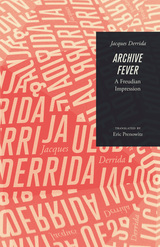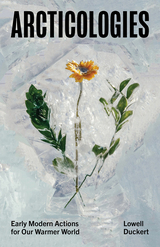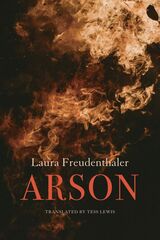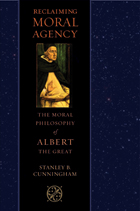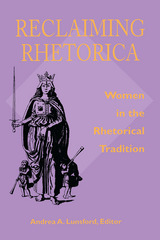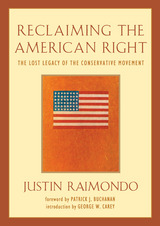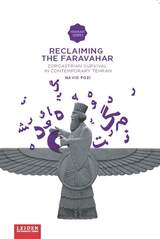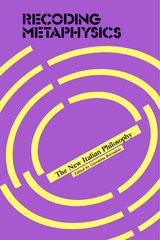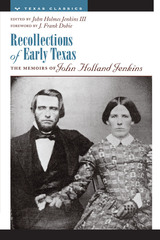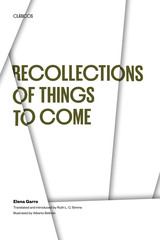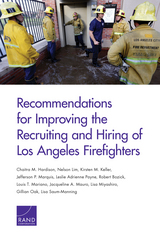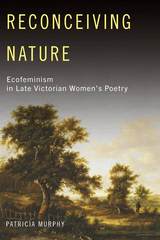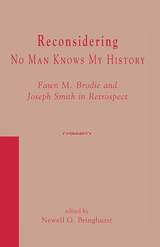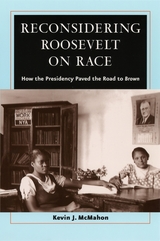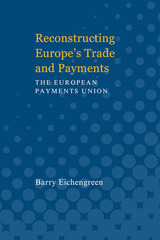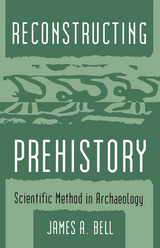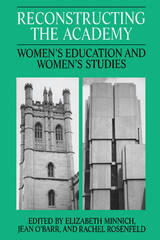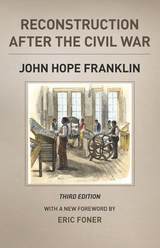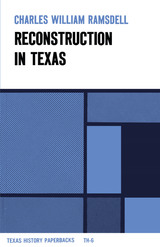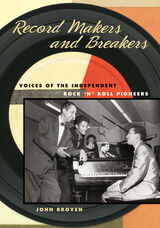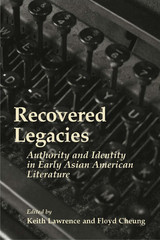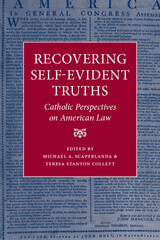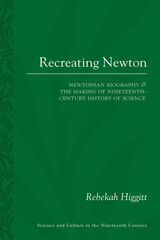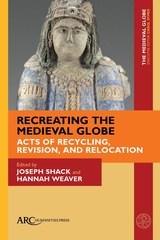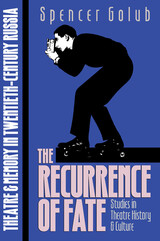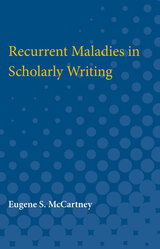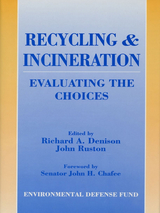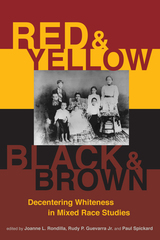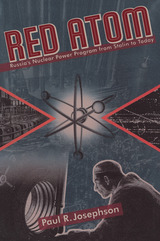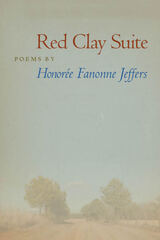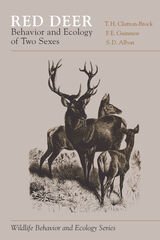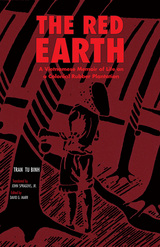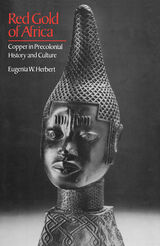 Reclaiming Goodness: Education and the Spiritual Quest
Hanan Alexander
University of Notre Dame Press, 2001 Reclaiming Goodness: Education and the Spiritual Quest begins with the premise that sound models for achieving both spiritual fulfillment and the "good life" are lacking in contemporary culture. Arguing that contemporary education is responsible for having abandoned spirituality and the cultivation of goodness in people, Hanan A. Alexander advances a definition of spirituality which acknowledges an integral connection to education.
For Alexander, spirituality requires that we seek to "discover our best selves in learning communities devoted to a higher good." He explores how spirituality provides an orientation toward a meaningful life and how, in our pursuit of that goal, it gives us a vision of the good life. For Alexander, this renewed vision of spirituality is necessary to provide the ethical framework so many of us seek; to achieve such a state of spiritual health, he proposes reenergizing liberal education.
In their extreme responses to the spiritual crisis, both relativists and fundamentalists have misused education as a method for promoting narrow ideological goals and producing individuals ill-equipped to act autonomously. Taking a cue from the golden mean of Aristotle and Maimonides, Alexander suggests situating education between the subjectivism and relativism of the left and the dogmatism and fundamentalism of the right. For Alexander, revitalizing education is a way to correct the misguided notion that extremism is an appropriate response to the spiritual crisis of modern society.
Reclaiming Goodness charts a way to reintegrate ethical and spiritual values with the values of critical thought and reason. Written in accessible and non-technical prose, it will be of interest to professional educators as well as to a wider audience.
Hanan A. Alexander is Head of the Ethics and Education Project and the Center for Jewish Education, and is Associate Professor in the Faculty of Education, University of Haifa. He is also Visiting Associate Professor in the School of Education, Bar Ilan University, and was editor-in-chief of Religious Education: An Interfaith Journal of Spirituality, Growth, and Transformation from 1991-2000.
----------
"Hanan Alexander turns his incisive mind to addressing spirituality and education in a marvelously integrative, challenging, and generative book. The work is integrative in drawing from three faith traditions, and also from the philosophy of education and broader philosophical discourse on questions of goodness. The work is challenging because it analyzes major social-religious-educational issues with sharpness and clarity. It also challenges people to think, to ask questions of themselves, to ask questions of Alexander, and even to argue with him. This is exactly what Alexander wants of his readers; intelligent spirituality is his goal. Finally, this work is generative. It stirs bold visions of education for goodness and clears practical pathways for religious peoples to travel. Alexander poses the possibility of a spiritual renaissance--most fully possible when religious and other communities are fully engaged in educating spirituality. I say a huge thank you to Hanan Alexander for daring to put goodness at the center of spiritual life and for equipping readers to see how this might be done!"--Mary Elizabeth Mullino Moore, Professor of Religion and Education, and Director of Program for Women in Theology and Ministry, Candler School of Theology, Emory University
"Reclaiming Goodness represents a sophisticated analysis of the spiritual crisis that marks modern life and offers an imaginative program for a renaissance of values and a revitalization of meaning in the present situation. Hanan Alexander draws upon a wide array of philosophical, sociological, and historical resources, as well as the Bible and classical rabbinic sources, in constructing the argument of book. Impressive in its learning and judicious in its diagnosis of the challenges confronting educators and others in the present-day world, Reawakening Goodness also contains positive proposals for the construction of enduring and humane purpose for modern persons." --David Ellenson, I.H. and Anna Grancell Professor of Jewish Religious Thought at Hebrew Union College-Jewish Institute of Religion
"Reclaiming Goodness invites profound reflection on the relationship between education and spirituality. Hanan Alexander complements his clarity of analysis with a passion for the educative potential of religious traditions. His outstanding book deserves a wide readership.--Mary C. Boys, Skinner & McAlpin Professor of Practical Theology, Union Theological Seminary
"Reclaiming Goodness is a powerful and important book. It will be noticed not only because it goes against the grain--spirituality, liberal education, education for the good life--but also because the book is so clearly the narrative expression of someone who has passionately lived a life of spirituality, education, and scholarship. The book is profoundly marked by Alexander's biography."--Michael Connelly, Professor, Director, Center for Teacher Development, University of Toronto
"This is an insightful and compassionate book that seeks to connect philosophy with religion; rationality with spirituality; and the cosmic with the secular. I recommend it highly to those in quest of an education that seeks to continue our responsibility to create a society rooted in a consciousness of loving-kindness." --David E. Purpel
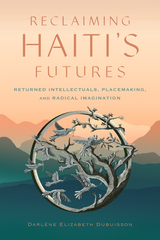 Reclaiming Haiti's Futures: Returned Intellectuals, Placemaking, and Radical Imagination
Darlène Elizabeth Dubuisson
Rutgers University Press, 2025 Haiti was once a beacon of Black liberatory futures, but now it is often depicted as a place with no future where emigration is the only way out for most of its population. But Reclaiming Haiti's Futures tells a different story. It is a story about two generations of Haitian scholars who returned home after particular crises to partake in social change. The first generation, called jenerasyon 86, were intellectuals who fled Haiti during the Duvalier dictatorship (1957–1986). They returned after the regime fell to participate in the democratic transition through their political leadership and activism. The younger generation, dubbed the jenn doktè, returned after the 2010 earthquake to partake in national reconstruction through public higher education reform. An ethnography of the future, the book explores how these returned scholars resisted coloniality's fractures and displacements by working toward and creating inhabitability or future-oriented places of belonging through improvisation, rasanblaj (assembly), and radical imagination. By centering on Haiti and the Caribbean, the book offers insights not just into the Haitian experience but also into how fractures have come to typify more aspects of life globally and what we might do about it.
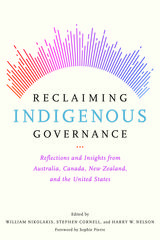 Reclaiming Indigenous Governance: Reflections and Insights from Australia, Canada, New Zealand, and the United States
Edited by William Nikolakis, Stephen Cornell, and Harry W. Nelson; Foreword by Sophie Pierre and Gwen Phillips
University of Arizona Press, 2019 Reclaiming Indigenous Governance examines the efforts of Indigenous peoples in four important countries to reclaim their right to self-govern. Showcasing Native nations, this timely book presents diverse perspectives of both practitioners and researchers involved in Indigenous governance in Canada, Australia, New Zealand, and the United States (the CANZUS states).
Indigenous governance is dynamic, an ongoing relationship between Indigenous peoples and settler-states. The relationship may be vigorously contested, but it is often fragile—one that ebbs and flows, where hard-won gains can be swiftly lost by the policy reversals of central governments. The legacy of colonial relationships continues to limit advances in self-government.
Yet Indigenous peoples in the CANZUS countries are no strangers to setbacks, and their growing movement provides ample evidence of resilience, resourcefulness, and determination to take back control of their own destiny. Demonstrating the struggles and achievements of Indigenous peoples, the chapter authors draw on the wisdom of Indigenous leaders and others involved in rebuilding institutions for governance, strategic issues, and managing lands and resources.
This volume brings together the experiences, reflections, and insights of practitioners confronting the challenges of governing, as well as researchers seeking to learn what Indigenous governing involves in these contexts. Three things emerge: the enormity of the Indigenous governance task, the creative agency of Indigenous peoples determined to pursue their own objectives, and the diverse paths they choose to reach their goal.
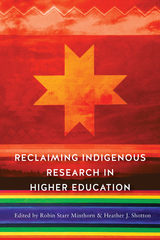 Reclaiming Indigenous Research in Higher Education
Minthorn, Robin Starr
Rutgers University Press, 2018 Indigenous students remain one of the least represented populations in higher education. They continue to account for only one percent of the total post-secondary student population, and this lack of representation is felt in multiple ways beyond enrollment. Less research money is spent studying Indigenous students, and their interests are often left out of projects that otherwise purport to address diversity in higher education.
Recently, Native scholars have started to reclaim research through the development of their own research methodologies and paradigms that are based in tribal knowledge systems and values, and that allow inherent Indigenous knowledge and lived experiences to strengthen the research. Reclaiming Indigenous Research in Higher Education highlights the current scholarship emerging from these scholars of higher education. From understanding how Native American students make their way through school, to tracking tribal college and university transfer students, this book allows Native scholars to take center stage, and shines the light squarely on those least represented among us.
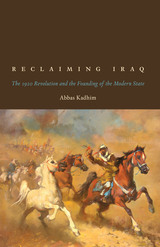 Reclaiming Iraq: The 1920 Revolution and the Founding of the Modern State
By Abbas Kadhim
University of Texas Press, 2012 While some scholars would argue that there was no “Iraq” before King Faysal’s coronation in 1921, Iraqi history spans fourteen centuries of tribal communities that endured continual occupation in their historic homeland, including Mongol invasions in the thirteenth century and subsequent Ottoman and British invasions. An Iraqi identity was established long before the League of Nations defined the nation-state of Iraq in 1932. Drawing on neglected primary sources and other crucial accounts, including memoirs and correspondence, Reclaiming Iraq puts the 1920 revolt against British occupation in a new light—one that emphasizes the role of rural fighters between June and November of that year. While most accounts of the revolution have been shaped by the British administration and successive Iraqi governments, Abbas Kadhim sets out to explore the reality that the intelligentsia of Baghdad and other cities in the region played an ideological role but did not join in the fighting. His history depicts a situation we see even today in conflicts in the Middle East, where most military engagement is undertaken by rural tribes that have no central base of power. In the study of the modern Iraqi state, Kadhim argues, Faysal’s coronation has detracted from the more significant, earlier achievements of local attempts at self-rule. With clarity and insight, this work offers an alternative perspective on the dawn of modern Iraq.
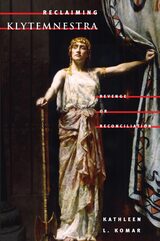 Reclaiming Klytemnestra: REVENGE OR RECONCILIATION
Kathleen L. Komar
University of Illinois Press, 2003 Reclaiming Klytemnestra explores the surprisingly numerous revisions by late twentieth-century women writers of the famous axe-wielding Greek queen who killed her husband in his bath when he returned from the Trojan War.
By slaying her husband, Klytemnestra exposed the competing ethics of motherhood and matrimony at the beginnings of the Western tradition. In this interdisciplinary study, Kathleen L. Komar first examines the classical archetype of Klytemnestra established by writers such as Aeschylus, Sophocles, and Euripides. Turning to the twentieth century, she investigates the work of modern writers who, since the 1960s, have reconceptualized Klytemnestra’s actions and motivations in the contemporary contexts of dance, fiction, drama, poetry, and the Internet. These revisions include a Martha Graham ballet; a performance piece by multiple authors; a play by Dacia Maraini; novels by Christa Reinig, Nancy Bogen, Christa Wolf, and Marie Cardinal; a short story by Christine Brückner; a poem by Laura Kennelly; a mixed-genre piece by Séverine Auffret; and two Internet presentations.
Eloquent, provocative, and richly detailed, Reclaiming Klytemnestra asks us to reassess the roles women were assigned at the beginnings of Western culture and to reenvision how those roles might be changed in the new millennium.
 Reclaiming Modernity: Essays on a Paradoxical Nostalgia
Larry Bennett
University of Illinois Press, 2025 Why do we seek to return to the past or rescue pieces of the past that may have value in the present? Why does nostalgia attach to an approach to the world, social rules, and material products that willfully rejected the past? Larry Bennett explores the complexities of nostalgia with considerations of the historic preservation of brutalist architecture, specifically Bertrand Goldberg’s Prentice Women’s Hospital in Chicago; the memoirs and recollections of early and mid-twentieth-century Brooklyn and Detroit; and the turntable’s rebirth as a musical instrument alongside the vinyl LP’s resurgence as a prized way of consuming music. Bennett tracks modernity as expressed through ideas, artistic products, and widespread social practices. His consideration of nostalgia focuses on our inclination to rediscover value in people, places, and social habits diminished by the passage of time. Provocative and multidisciplinary, Reclaiming Modernity delves into the paradox of how we feel nostalgia for ideas and times that emerged from an impulse to shun nostalgia.
 Reclaiming Public Housing: A Half Century of Struggle in Three Public Neighborhoods
Lawrence J. Vale
Harvard University Press, 2002 In Reclaiming Public Housing, Lawrence Vale explores the rise, fall, and redevelopment of three public housing projects in Boston. Vale looks at these projects from the perspectives of their low-income residents and assesses the contributions of the design professionals who helped to transform these once devastated places during the 1980s and 1990s.
The three similarly designed projects were built at the same time under the same government program and experienced similar declines. Each received comparable funding for redevelopment, and each design team consisted of first-rate professionals who responded with similar "defensible space" redesign plans. Why, then, was one redevelopment effort a nationally touted success story, another only a mixed success, and the third a widely acknowledged failure? The book answers this key question by situating each effort in the context of specific neighborhood struggles. In each case, battles over race and poverty played out somewhat differently, yielding wildly different results.
At a moment when local city officials throughout America are demolishing more than 100,000 units of low-income housing, this crucial book questions the conventional wisdom that all large public housing projects must be demolished and rebuilt as mixed-income neighborhoods.
 Reclaiming Queer: Activist and Academic Rhetorics of Resistance
Erin J. Rand
University of Alabama Press, 2014 An examination of the rhetorical linkage of queer theory in the academy with street-level queer activism in the 1980s and early 1990s
The late 1980s and early 1990s were a defining historical moment for both queer activism and queer theory in the United States. LGBTQ communities, confronted with the fatal indifference and homophobia of the AIDS crisis, often responded with angry, militant forms of activism designed not merely to promote acceptance or tolerance, but to forge identity and strength from victimization and assert loudly and forcefully their rights to safety and humanity. The activist reclamation of the word “queer” is one marker of this shift in ideology and practice, and it was mirrored in academic circles by the concurrent emergence of the new field of “queer theory.” That is, as queer activists were mobilizing in the streets, queer theorists were producing a similar foment in the halls and publications of academia, questioning regulatory categories of gender and sexuality, and attempting to illuminate the heteronormative foundations of Western thought. Notably, the narrative of queer theory’s development often describes it as arising from or being inspired by queer activism.
In Reclaiming Queer, Erin J. Rand examines both queer activist and academic practices during this period, taking as her primary object the rhetorical linkage of queer theory in the academy with street-level queer activism. Through this strategic conjuncture of activism and academia, Rand grapples with the specific conditions for and constraints on rhetorical agency in each context. She examines the early texts that inaugurated the field of queer theory, Queer Nation’s infamous “Queers Read This” manifesto, Larry Kramer’s polemic speeches and editorials, the Lesbian Avengers’ humorous and outrageous antics, the history of ACT UP, and the more recent appearance of Gay Shame activism. From these activist and academic discourses, Rand builds a theory of rhetorical agency that posits queerness as the very condition from which agency emerges.
Reclaiming Queer thus offers a critical look at the rhetoric of queer activism, engages the history of queer theory’s institutionalization and the politics of its proliferation, suggests a radically contextual understanding of rhetorical agency and form, and argues for the centrality of queerness to all rhetorical action.
Reclaiming Rhetorica: Women In The Rhetorical Tradition
Andrea A. Lunsford
University of Pittsburgh Press, 1995 Women’s contribution to rhetoric throughout Western history, like so many other aspects of women’s experience, has yet to be fully explored. In pathbreaking discussions ranging from ancient Greece, though the Middle Ages and the Renaissance, to modern times, sixteen closely coordinated essays examine how women have used language to reflect their vision of themselves and their age; how they have used traditional rhetoric and applied it to women’s discourse; and how women have contributed to rhetorical theory. Language specialists, feminists, and all those interested in rhetoric, composition, and communication, will benefit from the fresh and stimulating cross-disciplinary insights they offer.
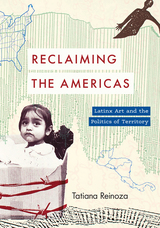 Reclaiming the Americas: Latinx Art and the Politics of Territory
Tatiana Reinoza
University of Texas Press, 2023 2023 Outstanding Book Award, National Association for Ethnic Studies
2024 Finalist, Charles Rufus Morey Book Award, College Art Association
2024 Best Arts Book, Empowering Latino Futures’ International Latino Book Awards
2025 Ewell L. Newman Book Award, American Historical Print Collectors Society How Latinx artists around the US adopted the medium of printmaking to reclaim the lands of the Americas. Printmakers have conspired, historically, to illustrate the maps created by European colonizers that were used to chart and claim their expanding territories. Over the last three decades, Latinx artists and print studios have reclaimed this printed art form for their own spatial discourse. This book examines the limited editions produced at four art studios around the US that span everything from sly critiques of Manifest Destiny to printed portraits of Dreamers in Texas. Reclaiming the Americas is the visual history of Latinx printmaking in the US. Tatiana Reinoza employs a pan-ethnic comparative model for this interdisciplinary study of graphic art, drawing on art history, Latinx studies, and geography in her discussions. The book contests printmaking’s historical complicity in the logics of colonization and restores the art form and the lands it once illustrated to the Indigenous, migrant, mestiza/o, and Afro-descendant people of the Americas.
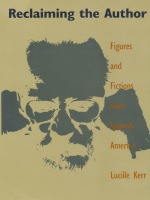 Reclaiming the Author: Figures and Fictions from Spanish America
Lucille Kerr
Duke University Press, 1992 The recent fiction of Spanish America has been widely acclaimed for its experimental and revolutionary qualities. In Reclaiming the Author, Lucille Kerr studies the sources of power of this newly emergent literature in her detailed examination of the critical concept of "the author." Kerr considers how Spanish American narratives raise questions about authorial identity and activity through the different figures of the author they propose. These author-figures, she maintains, both complement and contradict notions of authority that exist outside of the world of fiction.
By focusing on works by well-known Spanish American authors—Cortazar, Donoso, Fuentes, Poniatowska, Puig, and Vargas Llosa—Kerr shows how the Spanish Americans have formed a radical poetics of the author. Her readings demonstrate how exemplary Spanish American texts, such as Rayuela, Terra nostra, and El hablador, call into question the author as a unitary or uniform, and therefore unproblematical, figure. Individually and together, Kerr's readings reclaim "the author" as a complex critical concept encompassing diverse, conflicting, even competitive roles.
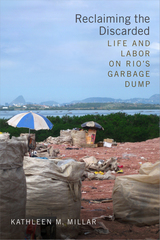 Reclaiming the Discarded: Life and Labor on Rio's Garbage Dump
Kathleen M. Millar
Duke University Press, 2018 In Reclaiming the Discarded Kathleen M. Millar offers an evocative ethnography of Jardim Gramacho, a sprawling garbage dump on the outskirts of Rio de Janeiro, where roughly two thousand self-employed workers known as catadores collect recyclable materials. While the figure of the scavenger sifting through garbage seems iconic of wageless life today, Millar shows how the work of reclaiming recyclables is more than a survival strategy or an informal labor practice. Rather, the stories of catadores show how this work is inseparable from conceptions of the good life and from human struggles to realize these visions within precarious conditions of urban poverty. By approaching the work of catadores as highly generative, Millar calls into question the category of informality, common conceptions of garbage, and the continued normativity of wage labor. In so doing, she illuminates how waste lies at the heart of relations of inequality and projects of social transformation.
Reclaiming The Faravahar: Zoroastrian Survival in Contemporary Tehran
Navid Fozi
Amsterdam University Press, 2014 Reclaiming the Faravahar is an ethnographic study of the contemporary Zoroastrians in Tehran. It examines many public discursive and ritual performances to show how they utilize national, religious, and ethnic categories to frame the Zoroastrian identity within the longstanding conflict between Iranian Shi.a and Arab Sunnis, defining and defending Zoroastrians’ identity and values in Shi.i dominated Iran.
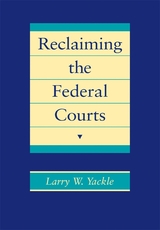 Reclaiming the Federal Courts
Larry Yackle
Harvard University Press, 1994 Go ahead and try to make a federal case of it. That may seem to be your right, but as Larry Yackle reveals in Reclaiming the Federal Courts, the guardians of that right don’t see it that way. A systematic study of the role the federal courts play in enforcing the Constitution, this powerful book shows how the current conservative Supreme Court has undermined that role by restricting citizens’ access to these courts.
Yackle focuses on judicially created doctrines that channel certain cases away from the federal courts (which tend to hold government power in check) and into state courts (which tend to allow government a relatively free hand). In doing so, he clearly shows how seemingly arcane and confusing legal technicalities actually tilt the delicate balance between government power and individual liberty in the United States. As he traces the historical underpinnings of the federal judicial system, Yackle explains how access to the federal courts in federal-question cases is intertwined with the most fundamental elements of American Jurisprudence—Legal Formalism, Legal Realism, Legal Process, and the Civil Rights Movement—as well as with the recent conservative retrenchment. He goes on to examine specific modern doctrines. Here we see how the Rehnquist Court’s restrictive rules deny citizens standing to sue in federal court, disclaim the federal courts’ jurisdiction even when standing is conceded, channel cases away from the federal courts even when they have jurisdiction, and frustrate the right to petition the federal courts for a writ of habeas corpus—perhaps the most fundamental right of any citizen.
Yackle’s straightforward style makes his description and analysis of existing law intelligible to students and others who wish to understand how the federal judicial system actually functions—or fails to function. The book concludes with concrete recommendations for congressional action to correct the subtle but significant injustice that Yackle so clearly and cogently exposes.
Reclaiming the Media: Communication Rights and Democratic Media Roles
Edited by Bart Cammaerts and Nico Carpentier
Intellect Books, 1995 In the twentieth century, the media gave whistleblowers a voice, spearheaded the downfall of powerful politicians, and exposed widespread corporate corruption. How will the twenty-first-century media cope with its storied legacy as the watchdog of democratic society? Reclaiming the Media examines the sometimes tenuous, often fraught relationship between media organizations and civil rights in Europe. In sections devoted to citizenship, participation, contemporary journalism, and activist communication strategies, a panel of European media experts makes the case for deepening the media’s role in democracy.
 Reclaiming the Nation: The Return of the National Question in Africa, Asia and Latin America
Edited by Sam Moyo and Paris Yeros
Pluto Press, 2011 This book compares the trajectories of states and societies in Africa, Asia and Latin America under neoliberalism, a time marked by serial economic crises, escalating social conflicts, the re-militarisation of North-South relations and the radicalisation of social and nationalist forces.
Sam Moyo and Paris Yeros bring together researchers and activists from the three continents to assess the state of national sovereignty and the challenges faced by popular movements today. They show that global integration has widened social and regional inequalities within countries, exacerbated ethnic, caste, and racial conflicts, and generally reduced the bureaucratic capacities of states to intervene in a defensive way. Moreover, inequalities between the countries of the South have also widened. These structural tensions have all contributed to several distinct political trajectories among states: from fracture and foreign occupation, to radicalisation and uncertain re-stabilisation.
This book re-draws the debate on the political economy of the contemporary South and provides students of international studies with an important collection of readings.
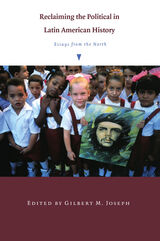 Reclaiming the Political in Latin American History: Essays from the North
Gilbert M. Joseph, ed.
Duke University Press, 2001 Reclaiming the Political in Latin American History is a collection that embraces a new social and cultural history of Latin America that is not divorced from politics and other arenas of power. True to the intellectual vision of Brazilian historian Emilia Viotti da Costa, one of Latin America’s most distinguished scholars, the contributors actively revisit the political—as both a theme of historical analysis and a stance for historical practice—to investigate the ways in which power, agency, and Latin American identity have been transformed over the past few decades.
Taking careful stock of the state of historical writing on Latin America, the volume delineates current historiographical frontiers and suggests a series of new approaches that focus on several pivotal themes: the construction of historical narratives and memory; the articulation of class, race, gender, sexuality, and generation; and the historian’s involvement in the making of history. Although the book represents a view of the Latin American political that comes primarily from the North, the influence of Viotti da Costa powerfully marks the contributors’ engagement with Latin America’s past. Featuring a keynote essay by Viotti da Costa herself, the volume’s lively North-South encounter embodies incipient trends of hemispheric intellectual convergence.
Contributors. Jeffrey L. Gould, Greg Grandin, Daniel James, Gilbert M. Joseph, Thomas Miller Klubock, Mary Ann Mahony, Florencia E. Mallon, Diana Paton, Steve J. Stern, Heidi Tinsman, Emilia Viotti da Costa, Barbara Weinstein
 Reclaiming the Road: Mobility Justice beyond Complete Streets
David L Prytherch
University of Minnesota Press, 2025 Imagining equitable streets for all For the past century, our roadways have been engineered as pipes for cars, but they offer vast potential as public spaces. From New York and Boston to Portland and Los Angeles, cities are rethinking their streets, going beyond sidewalks and bike lanes to welcome nonmotorists to share the asphalt roadway. Reclaiming the Road traces the historical evolution of America’s streets and explores contemporary movements to retake them from cars—temporarily and permanently—for diverse forms of mobility and community life. To share the street raises important questions of equity, in transportation and beyond. David L. Prytherch proposes a bold, intersectional vision of a more just street. Reclaiming the Road connects cutting-edge theory, policy analysis, and firsthand accounts from those leading the charge in transforming our streets to advocate for changing how we think about and design roads. Prytherch features case studies of nine major cities in the United States to show how experiments in reclaiming streets accelerated during the Covid-19 pandemic to become lasting changes. Through in-depth interviews, he shares stories of how planners, transportation advocates, and community leaders have implemented innovative programs for slowing neighborhood streets, opening roads for walking and biking, and reconstructing roadways with public parklets and street plazas as social spaces for curbside conversation. Examining movements to transform streets through the lenses of equity and justice, Reclaiming the Road tackles the conceptual challenge of defining mobility justice and the practicalities of planning a more just public street, offering a compelling vision for the future of America’s public spaces. Retail e-book files for this title are screen-reader friendly with images accompanied by short alt text and/or extended descriptions.
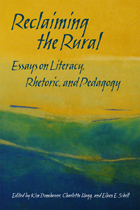 Reclaiming the Rural: Essays on Literacy, Rhetoric, and Pedagogy
Edited by Kim Donehower, Charlotte Hogg, and Eileen E. Schell
Southern Illinois University Press, 2012 In Reclaiming the Rural: Essays on Literacy, Rhetoric, and Pedagogy, editors Kim Donehower, Charlotte Hogg, and Eileen E. Schell bring together a diverse collection of essays that consider literacy, rhetoric, and pedagogy in the United States, Canada, and Mexico. The essays move beyond the typical arguments for preserving, abandoning, or modernizing by analyzing how rural communities sustain themselves through literate action. The contributors explore the rhetorics of water disputes in the western United States, the histories and influences of religious rhetorics in Mexico, agricultural and rural literacy curricula, the literacies of organizations such as 4-H and Academia de la Nueva Raza, and neoliberal rhetorics. Central to these examinations are the rural populations themselves, which include indigenous peoples in the rural United States, Canada, and Mexico, as well as those of European or other backgrounds. The strength of the anthology lies in its multiple perspectives, various research sites, and the range of methodologies employed, including rhetorical analyses of economies and environments, media, and public spaces; classroom-based research; historical analysis and archival work; and qualitative research. The researchers engage the duality between the practices of everyday life in rural communities and the practices of reflecting on and making meaning. Reclaiming the Rural reflects the continually changing, nuanced, context-dependent realities of rural life while acknowledging the complex histories, power struggles, and governmental actions that have affected and continue to affect the lives of rural citizens. This thought-provoking collection demonstrates the value in reclaiming the rural for scholarly and pedagogical analysis.
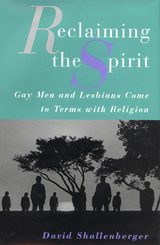 Reclaiming the Spirit: Gay Men and Lesbians Come to Terms with Their Religion
Shallenberger, David
Rutgers University Press, 1998 In a world in which religion and homosexuality are often by definition incompatible, it is crucial to hear from gay men and women about how they perceive themselves to be religious or spiritual people. Eliciting powerful, frank, and sometimes troubling responses, David Shallenberger interviewed gay men and women who grew up in families that belonged to traditional religions-Jewish, Roman Catholic, and Protestant-that rejected homosexuality as an unacceptable life-style. When these children grew into adulthood and "came out," many rejected the religion of their childhood as they sought out a more accepting gay community. But once they became comfortable with their new gay identity, they began to experience a spiritual hunger and a desire to be part of a religious community. Some sought to return to the traditions from which they came; others desired membership in new religious communities. The quest for an integration of homosexuality and spirituality is the focus of Reclaiming the Spirit. Shallenberger asks how individuals can balance both a gay and a religious identity, whether coming out is a spiritual experience, and how coming out affects an individual's relationship to a traditional religious community. Divided into chapters that correspond to the common stages of spiritual integration, Reclaiming the Spirit is immensely readable and introduces an important group of voices into the hotly contested debates surrounding religion and gay participation.
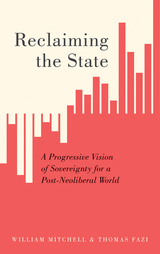 Reclaiming the State: A Progressive Vision of Sovereignty for a Post-Neoliberal World
William Mitchell and Thomas Fazi
Pluto Press, 2017 Trump. Brexit. The alt-right. It’s increasingly apparent that old political notions—believed to be consigned to the dustbin of history—are now resurrected. The neonationalist, anti-globalization, and anti-establishment attitude engulfing the United States and United Kingdom hints suspiciously at a yearning for national sovereignty. Reclaiming the State offers an urgent and prescient political analysis and economic program for the Left who are strategizing for these uncertain times.
Many of our assumptions—about ideology, democracy, trade, and globalization—are being thrown into doubt, deposed by populism, nationalism, and racism. In response to these challenging times, economist Bill Mitchell and political theorist Thomas Fazi propose a reconceptualization of the sovereign state as a vehicle for change. They offer a progressive view of sovereignty based not on the demonization of the other, but as a way to bring the economy back under democratic control. With nationalism gaining support across the United States with each passing week, Reclaiaming the State provides innovative ideas to mobilize and reenergize a tired, divided Left.
 Reclaiming Time: Race, Temporality, and Black Expressive Culture
Isaiah Matthew Wooden
Northwestern University Press, 2025 Showing how twenty-first-century Black theater and media arts challenge dominant conceptualizations of time Reclaiming Time: Race, Temporality, and Black Expressive Culture examines works by contemporary Black artists in multiple media—drama, film, performance art, and photography—that trouble dominant conceptualizations and normative configurations of time in relation to race in the twenty-first century. Isaiah Matthew Wooden explores the ways in which an intentional and sometimes ludic engagement with time and temporality has enabled these artists to probe urgent questions and themes concerning the conditions of contemporary Black life. Wooden surveys a diverse array of performance-based and visual texts to explore the rich practices of contemporary Black expressive culture: dramatic works by playwrights Eisa Davis, Tarell Alvin McCraney, and Robert O’Hara; performance art and photography by visual artists Jefferson Pinder and LaToya Ruby Frazier; and feature-length cinema by director-producer Tanya Hamilton. These works expose normative time as specious and evidence the transformative potential in honing practices of Black temporal experimentation and intervention. By putting this cross-disciplinary set of texts in conversation with each other, Wooden sheds new light on the shrewd ways that they each reflect an investment in unbinding time from the exigencies of normativity and teleology, as well as on their shared commitments to reclaiming time to reimagine and represent Blackness in all its multiplicities.
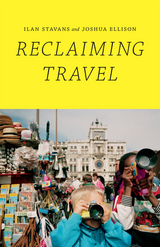 Reclaiming Travel
Ilan Stavans and Joshua Ellison
Duke University Press, 2015 Based on a controversial opinion piece originally published in the New York Times, Reclaiming Travel is a provocative meditation on the meaning of travel from ancient times to the twenty-first century. Ilan Stavans and Joshua Ellison seek to understand why we travel and what has come to be missing from our contemporary understanding of travel. Engaging with canonical and contemporary texts, they explore the differences between travel and tourism, the relationship between travel and memory, the genre of travel writing, and the power of mapmaking, Stavans and Ellison call for a rethinking of the art of travel, which they define as a transformative quest that gives us deeper access to ourselves.
Tourism, Stavans and Ellison argue, is inauthentic, choreographed, sterile, shallow, and rooted in colonialism. They critique theme parks and kitsch tourism, such as the shantytown hotels in South Africa where guests stay in shacks made of corrugated metal and cardboard yet have plenty of food, water and space. Tourists, they assert, are merely content with escapism, thrill seeking, or obsessively snapping photographs. Resisting simple moralizing, the authors also remind us that people don’t divide neatly into crude categories like travelers and tourists. They provoke us to reflect on the opportunities and perils in our own habits.
In this powerful manifesto, Stavans and Ellison argue that travel should be an art through which our restlessness finds expression—a search for meaning not only in our own lives but also in the lives of others. It is not about the destination; rather, travel is about loss, disorientation, and discovering our place in the universe.
 Reclaiming Truth: Contribution to a Critique of Cultural Relativism
Christopher Norris
Duke University Press, 1996 Truth, Christopher Norris reminds us, is very much out of fashion at the moment whether at the hands of politicians, media pundits, or purveyors of postmodern wisdom in cultural and literary studies. Across a range of disciplines the idea has taken hold that truth-talk is either redundant or the product of epistemic might. Questions of truth and falsehood are always internal to some specific language-game; history is just another kind of fiction; philosophy is only a kind of writing; law is a wholly rhetorical practice. In Reclaiming Truth, Norris critiques these fashionable trends of thought and mounts a specific challenge to cultural relativist doctrines in epistemology, philosophy of science, ethics, and political theory. Norris presents his case in a series of closely argued chapters that take issue with the relativist position. He attempts to rehabilitate the value of truth in philosophy of science by restoring a lost distinction between concept and metaphor and argues that theoretical discourse, so far from being an inconsequential activity, has very real consequences, particularly in ethics and politics. This debate has become skewed, he suggests, through the widespread and typically postmodern idea that truth-claims must always go along with a presumptive or authoritarian bid to silence opposing views. On the contrary, there is nothing as dogmatic—or as silencing—as a relativism that acknowledges no shared truth conditions for valid or responsible discourse. Norris also offers a timely reassessment of several thinkers—Althusser and Derrida among them—whose reception history has been distorted by the vagaries of short-term intellectual fashion. Reclaiming Truth will be welcomed by readers concerned with the uses and abuses of theory at a time when such questions are in urgent need of sustained and serious debate.
Recoding Metaphysics: The New Italian Philosophy
Giovanna Borradori
Northwestern University Press, 1988 Recoding Metaphysics: The New Italian Philosophy presents for the first time in English the work of many leading Italian contemporary thinkers. It suggests a third way in the hitherto almost exclusively French and German discussion of the deconstructive critique of poststructuralism on one hand, and the emancipatory convictions of post-Marxist discourse on the other. Each essay attempts to establish the validity of this third way, some by developing the concept of "weak thought" through rigorous analysis of Marxism and a reinterpretation of Nietzsche's nihilism and Heidegger's existentialism, and others by developing alternative critiques to postructuralist thinking.
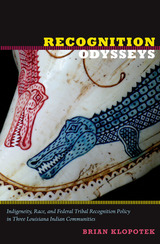 Recognition Odysseys: Indigeneity, Race, and Federal Tribal Recognition Policy in Three Louisiana Indian Communities
Brian Klopotek
Duke University Press, 2011 In Recognition Odysseys, Brian Klopotek explores the complicated relationship between federal tribal recognition policy and American Indian racial and tribal identities. He does so by comparing the experiences of three central Louisiana tribes that have petitioned for federal acknowledgment: the Tunica-Biloxi Tribe (recognized in 1981), the Jena Band of Choctaws (recognized in 1995), and the Clifton-Choctaws (currently seeking recognition). Though recognition has acquired a transformational aura, seemingly able to lift tribes from poverty and cultural decay to wealth and revitalization, these three cases reveal a more complex reality. Klopotek describes the varied effects of the recognition process on the social and political structures, community cohesion, cultural revitalization projects, identity, and economic health of each tribe. He emphasizes that recognition policy is not the only racial project affecting Louisiana tribes. For the Tunica-Biloxis, the Jena Band of Choctaws, and the Clifton-Choctaws, discourses around blackness and whiteness have shaped the boundaries of Indian identity in ways that have only begun to be explored. Klopotek urges scholars and officials from the Bureau of Indian Affairs (BIA) to acknowledge the multiple discourses and viewpoints influencing tribal identities. At the same time, he puts tribal recognition in broader perspective. Indigenous struggles began long before the BIA existed, and they will continue long after it renders any particular recognition decision.
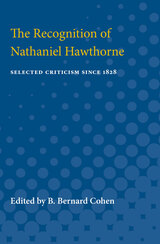 Recognition of Nathaniel Hawthorne: Selected Criticism Since 1828
Edited by B. Bernard Cohen
University of Michigan Press, 1969 What is Hawthorne's eminent literary reputation—"enduring" or "hypertrophied"? Both views are represented in this basic collection of seminal 19th- and 20th-century evaluations. Hawthorne's reputation appears secure, yet his work is still the subject of significant critical controversy.Reviews by Hawthorne's contemporaries take up the first section of The Recognition of Nathaniel Hawthorne—including an early review that predicted future greatness for the then-anonymous author of Fanshawe, and important pieces by Duyckinck, Longfellow, Poe, Melville, and Lowell. These estimates reveal many of the critical issues that were to concern successive generations of readers.Cohen's second section, covering the period from 1865 to 1910, includes criticism by Henry James, William Dean Howells, Paul Elmer More, Bliss Perry, and William C. Brownell. In the final section, T. S. Eliot, Vernon Louis Parrington, Austin Warren, F. O. Matthiessen, Hyatt H. Waggoner, Martin Green, and Frederick C. Crews are among the critics who explore, from a wide variety of viewpoints, the complex mind of this great American writer.The Recognition of Nathaniel Hawthorne is prefaced by a valuable survey of the criticism by Professor Cohen, and headnotes are provided for each of the selections.
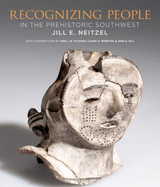 Recognizing People in the Prehistoric Southwest
Jill E Neitzel with contributions by Ann L. W. Stodder, Laurie Webster, and Jane H. Hill
University of Utah Press, 2016 In the prehistoric Southwest, if you traveled from one community to another, you would have observed tremendous diversity in how people looked and spoke. This volume is the first to look at how prehistoric people’s appearance and speech conveyed their identities. Previously, Southwest archaeologists have studied identity using architecture, ceramics, textiles, and jewelry. This book uses a holistic, comparative approach to consider all aspects of appearance. Advocating a people-centered perspective for studying the past, Neitzel and her colleagues show how these characteristics conveyed information about an individual’s social status, cultural affiliation, inter-group connections, religious beliefs, and ceremonial roles.
Contributors: Ann L. W. Stodder, Museum of New Mexico, and Department of Anthropology, The University of New Mexico; Laurie Webster, University of Arizona; and Jane H. Hill, School of Anthropology, University of Arizona (emerita)
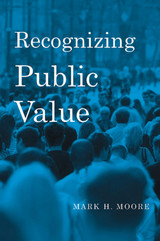 Recognizing Public Value
Mark H. Moore
Harvard University Press, 2013 Mark H. Moore’s now classic Creating Public Value offered advice to public managers about how to create public value. But that book left a key question unresolved: how could one recognize (in an accounting sense) when public value had been created? Here, Moore closes the gap by setting forth a philosophy of performance measurement that will help public managers name, observe, and sometimes count the value they produce, whether in education, public health, safety, crime prevention, housing, or other areas. Blending case studies with theory, he argues that private sector models built on customer satisfaction and the bottom line cannot be transferred to government agencies. The Public Value Account (PVA), which Moore develops as an alternative, outlines the values that citizens want to see produced by, and reflected in, agency operations. These include the achievement of collectively defined missions, the fairness with which agencies operate, and the satisfaction of clients and other stake-holders.
But strategic public managers also have to imagine and execute strategies that sustain or increase the value they create into the future. To help public managers with that task, Moore offers a Public Value Scorecard that focuses on the actions necessary to build legitimacy and support for the envisioned value, and on the innovations that have to be made in existing operational capacity.
Using his scorecard, Moore evaluates the real-world management strategies of such former public managers as D.C. Mayor Anthony Williams, NYPD Commissioner William Bratton, and Commissioner of the Minnesota Department of Revenue John James.
 Recognizing Wrongs
John C. P. Goldberg and Benjamin C. Zipursky
Harvard University Press, 2020 Two preeminent legal scholars explain what tort law is all about and why it matters, and describe their own view of tort’s philosophical basis: civil recourse theory.
Tort law is badly misunderstood. In the popular imagination, it is “Robin Hood” law. Law professors, meanwhile, mostly dismiss it as an archaic, inefficient way to compensate victims and incentivize safety precautions. In Recognizing Wrongs, John Goldberg and Benjamin Zipursky explain the distinctive and important role that tort law plays in our legal system: it defines injurious wrongs and provides victims with the power to respond to those wrongs civilly.
Tort law rests on a basic and powerful ideal: a person who has been mistreated by another in a manner that the law forbids is entitled to an avenue of civil recourse against the wrongdoer. Through tort law, government fulfills its political obligation to provide this law of wrongs and redress. In Recognizing Wrongs, Goldberg and Zipursky systematically explain how their “civil recourse” conception makes sense of tort doctrine and captures the ways in which the law of torts contributes to the maintenance of a just polity.
Recognizing Wrongs aims to unseat both the leading philosophical theory of tort law—corrective justice theory—and the approaches favored by the law-and-economics movement. It also sheds new light on central figures of American jurisprudence, including former Supreme Court Justices Oliver Wendell Holmes, Jr., and Benjamin Cardozo. In the process, it addresses hotly contested contemporary issues in the law of damages, defamation, malpractice, mass torts, and products liability.
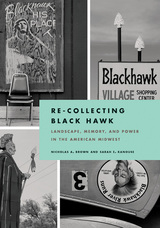 Re-Collecting Black Hawk: Landscape, Memory, and Power in the American Midwest
Nicholas A. Brown
University of Pittsburgh Press, 2015
The name Black Hawk permeates the built environment in the upper midwestern United States. It has been appropriated for everything from fitness clubs to used car dealerships. Makataimeshekiakiak, the Sauk Indian war leader whose name loosely translates to “Black Hawk,” surrendered in 1832 after hundreds of his fellow tribal members were slaughtered at the Bad Axe Massacre.
Re-Collecting Black Hawk examines the phenomena of this appropriation in the physical landscape, and the deeply rooted sentiments it evokes among Native Americans and descendants of European settlers. Nearly 170 original photographs are presented and juxtaposed with texts that reveal and complicate the significance of the imagery. Contributors include tribal officials, scholars, activists, and others including George Thurman, the principal chief of the Sac and Fox Nation and a direct descendant of Black Hawk. These image-text encounters offer visions of both the past and present and the shaping of memory through landscapes that reach beyond their material presence into spaces of cultural and political power. As we witness, the evocation of Black Hawk serves as a painful reminder, a forced deference, and a veiled attempt to wipe away the guilt of past atrocities. Re-Collecting Black Hawk also points toward the future. By simultaneously unsettling and reconstructing the midwestern landscape, it envisions new modes of peaceful and just coexistence and suggests alternative ways of inhabiting the landscape.
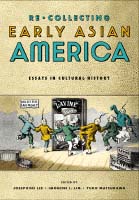 Recollecting Early Asian America: Essays In Cultural History
Josephine Lee
Temple University Press, 2002 As a book about cultural memory and retrieval, this collection of essays asks readers to reconsider who represents Asian America and what constitutes its history. Defining the early period as spanning the nineteenth century and the 1960s, the original essays here speak to the difficulty of recovering a past that was largely unrecorded as well as understanding the varied experiences of peoples of Asian descent. Interdisciplinary in approach, the essays address the Asian American individuals and communities that have been omitted from "official" histories; trace the roots of persistent racial stereotypes and myths; and retrieve artistic production that raises vexed questions of what counts as "art" or as Asian American. By reconsidering the political, cultural, and material history written in the last three decades, this volume contributes to a new understanding of Asian America's past and relationship to the present.
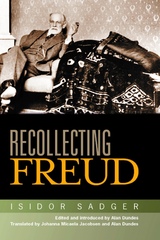 Recollecting Freud
Isidor Sadger; Edited and introduced by Alan Dundes; Translated by Johanna Micaela Jacobsen and Alan Dundes
University of Wisconsin Press, 2005 Available here for the first time in English, this eyewitness account by one of Freud's earliest students has been rediscovered for twenty-first century readers. Isidor Sadger's recollections provide a unique window into the early days of the psychoanalytic movement—the internecine and ideological conflicts of Freud's disciples. They also illuminate Freud's own struggles: his delight in wit, his attitudes toward Judaism, and his strong opinions concerning lay, non-medical analysts.
As a student, Sadger attended Freud's lectures from 1895 through 1904. Two years later Freud nominated Sadger to his Wednesday Psychological Society (later called the Viennese Psychoanalytic Society). Sadger, however, was not part of Freud's inner circle, but more a participant observer of the early years of the psychoanalytic movement and of Freud as teacher, therapist, and clinician.
Sadger was considered one of the most devoted followers of Freud and hoped to become one of Freud's "favorite sons." At the First Psychoanalytic Congress held in Salzburg in 1908, Sadger was chosen to be one of the principal speakers along with Freud, Jones, Alder, Jung, Prince, Rifkin, Abraham, and Stekel, an honor that bespeaks Sadger's early role in the movement. But Freud and many of his disciples were also openly critical of Sadger's work, calling it at various times overly simplistic, unimaginative, reductionist, orthodox, and rigid.
In 1930 Sadger published his memoir, Sigmund Freud: Persönliche Erinnerungen. With the rise of Nazism and World War II, the book became lost to the world of psychoanalytic history. Recently, Alan Dundes learned of its existence and mounted a search that led him around the world to one of the few extant copies—in a research library in Japan. The result of his fascinating quest is Recollecting Freud, a long-lost personal account that provides invaluable insights into Freud and his social, cultural, and intellectual context.
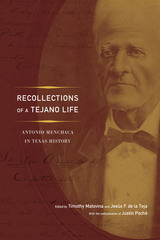 Recollections of a Tejano Life: Antonio Menchaca in Texas History
Edited by Timothy Matovina and Jesús F. de la Teja
University of Texas Press, 2013 San Antonio native, military veteran, merchant, and mayor pro tem José Antonio Menchaca (1800–1879) was one of only a few Tejano leaders to leave behind an extensive manuscript of recollections. Portions of the document were published in 1907, followed by a “corrected” edition in 1937, but the complete work could not be published without painstaking reconstruction. At last available in its entirety, Menchaca’s book of reminiscences captures the social life, people, and events that shaped the history of Texas’s tumultuous transformation during his lifetime. Highlighting not only Menchaca’s acclaimed military service but also his vigorous defense of Tejanos’ rights, dignity, and heritage, Recollections of a Tejano Life charts a remarkable legacy while incorporating scholarly commentary to separate fact from fiction. Revealing how Tejanos perceived themselves and the revolutionary events that defined them, this wonderfully edited volume presents Menchaca’s remembrances of such diverse figures as Antonio López de Santa Anna, Jim Bowie, Davy Crockett, Sam Houston, General Adrián Woll, Comanche chief “Casamiro,” and Texas Ranger Jack Hays. Menchaca and his fellow Tejanos were actively engaged in local struggles as Mexico won her independence from Spain; later many joined the fight to establish the Republic of Texas, only to see it annexed to the United States nine years after the Battle of San Jacinto. This first-person account corrects important misconceptions and brings previously unspoken truths vividly to life.
Recollections of Early Texas: Memoirs of John Holland Jenkins
Edited by John Holmes Jenkins III
University of Texas Press, 1958 “[These reminiscences] light up for whoever will read the earliest days of early English-speaking Texas.” —J. Frank Dobie, from the foreword A firsthand account of pioneer life in east Texas.
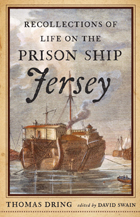 Recollections of Life on the Prison Ship Jersey
Thomas Dring
Westholme Publishing, 2010 A First-hand Account of Prison Experience in the American Revolution “Among the many events which took place during the Revolutionary War from its commencement to its termination [are] the cruelties inflicted upon that unfortunate class of men who had the misfortune to be numbered among the prisoners [of the British] and more particularly those whom the dreadful chance of war had placed on board their prison ships at New York.” So begins the remarkable narrative of Thomas Dring. In 1824, Dring was an aging man of 65, retired in his native state of Rhode Island. Forty-two years before, he, like thousands of other young men, had been caught up in the American cause. In 1782, he had been captured by the British and sentenced to the infamous prison ship Jersey, a demasted hulk anchored in the East River off New York City. It is estimated that more than 11,000 men perished on the British prison ships over the course of the war, and their bones regularly washed up on the shore long after hostilities ceased. Dring survived to tell the tale, and in 1824, he decided to do just that. He was motivated partly because the fate of the prisoners was beginning to be doubted, that their hardships were thought to have been grossly exaggerated, and even that the entire experience had never occurred. This book publishes for the first time the complete text of Dring’s handwritten manuscript, a major primary-source document, in which he describes the horrible conditions, treatment by guards, and experiences that he and others endured during captivity. Recollections of Life on the Prison Ship Jersey is a plea not to forget but instead to remember the inhumanity of the captors and the sacrifices of the captives—a message that continues to resonate today. Editor David Swain has provided an introductory essay and extensive notes that contain background information and historical documentation to accompany and illuminate the original manuscript.
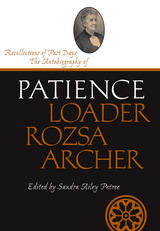 Recollections of Past Days: The Autobiography of Patience Loader Rozsa Archer
edited by Sandra Ailey Petree
Utah State University Press, 2006 For visitors to the Martin's Cove historic site in Wyoming, Patience Loader has become an icon of the disastrous winter entrapment of the Martin and Willie handcart companies. Her record of those events is important, but there is much else of interest in her autobiography. In fact, it is a bit unusual that someone such as her would have left such an engaging record of her life. The daughter of an English gardener, Patience Loader became a boarding house servant, domestic maid, and seamstress. Converted to Mormonism, she shipped with her parents to America. They joined the ill-fated Martin company, which because of poor planning and a late start west, was caught poorly prepared by severe high plains snowstorms in October and November 1856. The combined fatalities of the Martin and Willie companies made this the worst disaster in the history of overland travel. Patience = s father was one of those who died. After reaching Utah, Patience took the unusual step for a Mormon of marrying a soldier, John Rozsa, stationed at Camp Floyd. The troops there had made up the Utah Expedition, sent to ensure federal authority over the Mormons. Rozsa was a Hungarian immigrant and Mormon convert. When the Utah troops were recalled for the Civil War, Patience accompanied her husband, as an army laundress, to Washington, D.C., running a boarding house while Rozsa fought. After the war, he died at Fort Leavenworth of consumption, and Patience returned alone to Utah, where she became a cook at a mining camp in American Fork Canyon. Her autobiography ends there in 1872, though she lived till 1922.
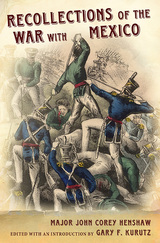 Recollections of the War with Mexico
Major John Corey Henshaw & Edited by Gary F. Kurutz
University of Missouri Press, 2008 Major John Henshaw, a dutiful regimental officer in the American invasion of Mexico, was one of only a handful of eyewitnesses to describe the two major theaters of that war from start to finish. But unlike most of his peers, he did not see himself as a conquering warrior and took pride in never having taken a life. He even wrote, “If I were alone, no earthly power could induce me to lend a helping hand in this base and infamous war.” This book presents Henshaw’s recollections for the first time, covering all the action from the first skirmish in southern Texas to the collapse of Mexico City. As a member of the Seventh Infantry Regiment, this pugnacious line officer from New England served under both of the war’s principal generals, Zachary Taylor and Winfield Scott, and survived seven major battles. His writings constitute a virtual “minority opinion” report on the Mexican War. Henshaw’s recollections include a rare and highly descriptive account of the siege of Fort Texas (later Fort Brown), plus rich new details of the storming of the Bishop’s Palace at Monterrey, the bombardment of Veracruz, the assault on Cerro Gordo, and the savage fighting outside the capital. His records of battles, marches, and maneuvers greatly augment what is already known about the campaign, but in addition to reporting daily occurrences and describing combat in graphic detail, Henshaw also reflected on the strategies and tactics—and what he saw as shortcomings—of officers on both sides. Bitingly critical of those in command, of American volunteers, and of the war’s glory hounds, Henshaw admired the valor of ordinary soldiers on both sides of the fighting. And in the midst of the carnage, he also found time to describe Mexico’s cities and scenery in rhapsodic prose and express considerable empathy for its people. In addition to the “Recollections,” the volume includes vivid passages from letters Henshaw sent back to his wife, which supply additional details of the campaign. Editor Gary Kurutz provides an extensive biography of Henshaw, as well as comprehensive annotations to the text. What Henshaw may have lacked as an unquestioning officer he more than made up for as an astute observer. Offering a decidedly different view of this war of American expansion, these writings with their balanced approach lend a fresh perspective among other primary sources and paint a startlingly honest picture of both Americans fighting abroad and those they fought.
Recollections of Things to Come
By Elena Garro
University of Texas Press, 1969 This remarkable first novel depicts life in the small Mexican town of Ixtepec during the grim days of the Revolution. The town tells its own story against a variegated background of political change, religious persecution, and social unrest. Elena Garro, who has also won a high reputation as a playwright, is a masterly storyteller. Although her plot is dramatically intense and suspenseful, the novel does not depend for its effectiveness on narrative continuity. It is a book of episodes, one that leaves the reader with a series of vivid impressions. The colors are bright, the smells pungent, the many characters clearly drawn in a few bold strokes. Octavio Paz, the distinguished poet and critic, has written that it "is truly an extraordinnary work, one of the most perfect creations in contemporary Latin American literature."
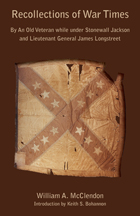 Recollections of War Times: By An Old Veteran while under Stonewall Jackson and Lieutenant General James Longstreet
William A. McClendon, with an introduction by Keith S. Bohannon
University of Alabama Press, 2010 Recollections of War Times is a dramatically improved edition of William A. “Gus” McClendon’s memoir of his service in the 15th Alabama Infantry. It has long been recognized among the rarest books by any veteran of the Army of Northern Virginia. Keith Bohannon has conducted relentless research that uncovered a gratifying array of new information about McClendon, as well as new photographs. The introduction based on that research might be a model for the genre, full of details acquired from arcane sources that throw new light on the subject. Bohannon's new exhaustive index also makes McClendon's memoir notably more accessible.
"Gus" McClendon joined the 15th Alabama Infantry Regiment, and served in many of the Eastern Theater engagements. More than fifty years later, he sent down his reminiscences, still an unreconstructed Southern patriot, although able to look back with some amusement on his younger self.
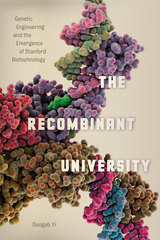 The Recombinant University: Genetic Engineering and the Emergence of Stanford Biotechnology
Doogab Yi
University of Chicago Press, 2015 The advent of recombinant DNA technology in the 1970s was a key moment in the history of both biotechnology and the commercialization of academic research. Doogab Yi’s The Recombinant University draws us deeply into the academic community in the San Francisco Bay Area, where the technology was developed and adopted as the first major commercial technology for genetic engineering. In doing so, it reveals how research patronage, market forces, and legal developments from the late 1960s through the early 1980s influenced the evolution of the technology and reshaped the moral and scientific life of biomedical researchers.
Bay Area scientists, university administrators, and government officials were fascinated by and increasingly engaged in the economic and political opportunities associated with the privatization of academic research. Yi uncovers how the attempts made by Stanford scientists and administrators to demonstrate the relevance of academic research were increasingly mediated by capitalistic conceptions of knowledge, medical innovation, and the public interest. Their interventions resulted in legal shifts and moral realignments that encouraged the privatization of academic research for public benefit. The Recombinant University brings to life the hybrid origin story of biotechnology and the ways the academic culture of science has changed in tandem with the early commercialization of recombinant DNA technology.
Recommendations for Energy-efficient Exterior Lighting Systems
The Institution of Engineering and Technology
The Institution of Engineering and Technology, 2015 This good practice Guide supports informed customers and users of exterior lighting systems, providing a basis for evaluation of technical issues and decision-making on technology adoption, in order to achieve functional, budgetary and compliance requirements. It provides recommendations for decision making and appropriate approaches to the specification and procurement of energy efficient exterior lighting systems.
Recommendations for Improving the Recruiting and Hiring of Los Angeles Firefighters
Chaitra M. Hardison
RAND Corporation, 2015 Reviews the Los Angeles Fire Department’s hiring practices as of June 2014 and outlines a recommended new firefighter hiring process that is intended to increase efficiency of the hiring process, bolster the evidence supporting the validity of it, and make it more transparent and inclusive.
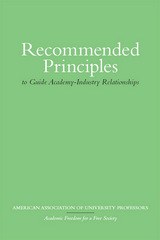 Recommended Principles to Guide Academy-Industry Relationships
American Association of University Professors
University of Illinois Press, 2014 The reputation of a college or institution depends upon the integrity of its faculty and administration. Though budgets are important, ethics are vital, and a host of new ethical problems now beset higher education. From MOOCS and intellectual property rights to drug industry payments and conflicts of interest, this book offers AAUP policy language and best practices to deal with all the campus-wide challenges of today's corporate university:
• Preserving the integrity of research and public respect for higher education
• Eliminating and managing individual and institutional financial conflicts of interest
• Maintaining unbiased hiring and recruitment policies
• Establishing grievance procedures and due process rights for faculty, graduate students, and academic professionals
• Mastering the complications of negotiations over patents and copyright
• Assuring the ethics of research involving human subjects.
In a time of dynamic change Recommended Principles to Guide Academy-Industry Relationships offers an indispensable and authoritative guide to sustaining integrity and tradition while achieving great things in twenty-first century academia.
Recommended Standards for Delivering High-Quality Care to Veterans with Invisible Wounds
Carrie M. Farmer
RAND Corporation, 2022 The authors identified ten standards for the delivery of high-quality care for veterans with posttraumatic stress disorder, depression, substance use disorders, and mild traumatic brain injury. They also provide considerations for implementing and disseminating these standards as a first step to improve access to high-quality care for veterans with invisible wounds.
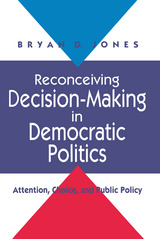 Reconceiving Decision-Making in Democratic Politics: Attention, Choice, and Public Policy
Bryan D. Jones
University of Chicago Press, 1994 Most models of political decision-making maintain that individual preferences remain relatively constant. Why, then, are there often sudden abrupt changes in public opinion on political issues? Or total reversals by politicians on specific issues? Bryan D. Jones answers these questions by innovatively connecting insights from cognitive science and rational choice theory to political life.
Individuals and political systems alike, Jones argues, tend to be attentive to only one issue at a time. Using numerous examples from elections, public opinion polls, congressional deliberations, and of bureaucratic decision-making, he shows how shifting attentiveness can and does alter choices and political outcomes—even when underlying preferences remain relatively fixed. An individual, for example, may initially decide to vote for a candidate because of her stand on spending but change his vote when he learns of her position on abortion, never really balancing the two options.
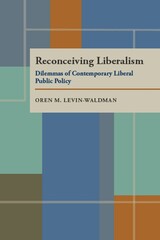 Reconceiving Liberalism: Dilemmas of Contemporary Liberal Public Policy
Oren M. Levin-Waldman
University of Pittsburgh Press, 1996
Levin-Waldman argues that if American public policy were to be evaluated against a different set of principles—ones more closely aligned with core liberal values, especially the common good—liberalism would be in greater harmony with contemporary public opinion and thought.
Liberalism rests on a moral vision of what constitutes the good life and a set of principles that can measure whether public policy accords with society's underlying philosophical principles. Levin-Waldman faults modern liberalism for obscuring these principles through a misplaced reliance on neutrality. Liberalism, he contends, appears to have diverged from mainstream perceptions of traditional American values because policy is debated and formulated within the confines of this neutrality standard.
Levin-Waldman develops a new methodology intended to take us away from the usual cost-benefit analysis and move us closer to assessing public policies in terms of what best serves the common good.
Reconceiving Nature: Ecofeminism in Late Victorian Women's Poetry
Patricia Murphy
University of Missouri Press, 2019 Surprisingly, glimmerings of ecofeminist theory that would emerge a century later can be detected in women’s poetry of the late Victorian period. In Reconceiving Nature, Patricia Murphy examines the work of six ecofeminist poets—Augusta Webster, Mathilde Blind, Michael Field, Alice Meynell, Constance Naden, and L. S. Bevington—who contested the exploitation of the natural world. Challenging prevalent assumptions that nature is inferior, rightly subordinated, and deservedly manipulated, these poets instead “reconstructed” nature.
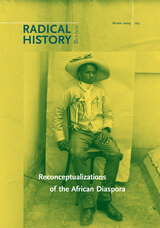 Reconceptualizations of the African Diaspora, Volume 2009
Erica Ball, Melina Pappademos, and Michelle Ann Stephens, eds.
Duke University Press This special issue of Radical History Review aims to revitalize African diaspora studies by shifting current emphases within the field. The contributors rethink current understandings of African and diaspora as a dispersal of Africans from the African continent via the Atlantic slave trade and offer reconceptualizations of dominant paradigms, such as home, origins, migrations, politics, blackness, African, Africa, African-descended, and Americanness. The contributors draw on perspectives from political science, history, cultural studies, art history, anthropology, feminist theory, sexuality and queer studies, and Caribbean and African American studies. The collection addresses transnational discourses of race, gender, and sexuality in African diaspora politics, African diaspora experiences on the African continent, the politics of African-descended peoples in Europe, and creative uses of the discourses of memory and diaspora to support political organizing and local struggles. Essays on Venezuelans, Bolivians, and Mexicans address the status of race in the study of African-descended populations and cultures in Latin America. The issue also includes two essays that showcase African diasporic art and curatorial practices in the United States, the Caribbean, and the United Kingdom. Contributors: Erica Ball, Anthony Bogues, Lisa Brock, Sara Busdiecker, Prudence Cumberbatch,Jacqueline Francis, Anita González, Amoaba Gooden, Dayo Gore, Laura A. Harris, Christopher J. Lee, Kevin Mumford, Melina Pappademos, Cristóbal Valencia Ramírez, Rochelle Rowe, Theresa Runstedtler, Michelle Ann Stephens, Tyler Stovall, Deborah Thomas, Leon Wainwright, Cadence Wynter, Paul Tiyambe Zeleza
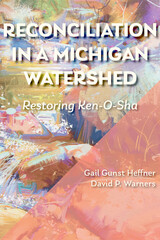 Reconciliation in a Michigan Watershed: Restoring Ken-O-Sha
Gail Gunst Heffner
Michigan State University Press, 2024 Like many American urban waterways, Ken-O-Sha has been in decline for nearly two hundred years. Once life-supporting, the waterway now known as Plaster Creek is life-threatening. In this provocative book, scholars and environmentalists Gail Gunst Heffner and David P. Warners explore the watershed’s ecological, social, spiritual, and economic history to determine what caused the damage, and describe more recent efforts to repair it. Heffner and Warners provide insight into the concept of reconciliation ecology, as enacted through their group, Plaster Creek Stewards,who together with community partners refuse to accept the status quo of a contaminated creek unfit for children’s play, severely reduced biological diversity, and environmental injustices. Their work reveals that reconciliation ecology needs to focus not only on repairing damaged human–nature relationships, but also on the relationships between people groups, including Indigenous North Americans and the descendants of European colonizers.
 Reconciling Catholicism Feminism
Ron Ebest
University of Notre Dame Press, 2003 In this timely collection of essays, twenty-two widely respected writers, historians, theologians, and feminists thoughtfully reflect on their own personal experiences with the Catholic Church. The essayists movingly describe how they have, or in some cases have not, come to terms with a church that does not permit them full participation. In so doing, they offer practical suggestions for ways in which the church can become more open to the concerns of its progressive members. In a format that is easily accessible to general readers, Reconciling Catholicism and Feminism? explores issues of concern to progressive and feminist Catholics, including abortion, birth control, clerical celibacy, and the ordination of women.
SALLY BARR EBEST is associate professor of English and Director of the Writing Program at the University of Missouri-St. Louis.
RON EBEST teaches courses in literature and writing at the University of Missouri-St. Louis.
Contributors: Sandra M. Gilbert, Rosemary Radford Ruether, Jean Molesky-Poz, Janet Kalven, Jean McGarry, Madeleine Blais, Linda A. McMillin, Flavia Alaya, Victoria Kill, Nancy Mairs, Kathleen M. Joyce, Mary Kenny, Nilsa Lasso-Von Lang, Brad Peters, Jane Zeni, Kathleen A. Tobin, Mary Jo T. Marcellus, Lorraine Liscio, Jeanne Noonan-Eckholdt, Theresa Delgadillo, Henrik Borgstrom, Sally Barr Ebest, Ron Ebest.
----------
"I know of nothing in print that offers this engaging mix of voices rational and exalted, meliorative and audacious, troubled, pugnacious, quizzical, and sane." --Judith Wilt, Boston College
"Good Catholic girls and great catholic women make feminism and Catholicism anything but a contradiction in terms. Authors of these essays demonstrate that the combination is a vital source for personal integration and social/ecclesial change. Feminist Catholicism proves that religions are dynamic activities indeed." --Mary E. Hunt, Co-director of the Women's Alliance for Theology, Ethics and Ritual (WATER)
"This thoughtful work is recommended for academic libraries and for community libraries with a good religion circulation." --Library Journal
"The editors were astute (and catholic) to include an international range of experiences of the Church and feminism." --Boston College Magazine
Reconciling Rwanda: Unity, Nationality and State Control
Jennifer Melvin
University of London Press, 2015 In July 1994, the Rwandan Patriotic Front (RPF) set out to stabilise and secure Rwanda, a country decimated by genocide. This mandate was later extended to include the herculean task of promoting unity and reconciliation to a population torn apart by violence. More than two decades later, these goals appear to have been achieved. Beneath the veneer of reconciliation lies myriad programmes and legislation that do more than seek to unite the population - they keep the RPF in power. In Reconciling Rwanda: Unity, Nationality and State Control, Jennifer Melvin analyses the highly controversial RPF and its vision of reconciliation to determine who truly benefits from the construction of the new post-genocide Rwanda.
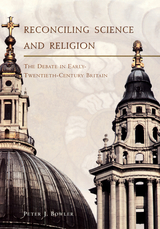 Reconciling Science and Religion: The Debate in Early-Twentieth-Century Britain
Peter J. Bowler
University of Chicago Press, 2001 Although much has been written about the vigorous debates over science and religion in the Victorian era, little attention has been paid to their continuing importance in early twentieth-century Britain. Reconciling Science and Religion provides a comprehensive survey of the interplay between British science and religion from the late nineteenth century to World War II.
Peter J. Bowler argues that unlike the United States, where a strong fundamentalist opposition to evolutionism developed in the 1920s (most famously expressed in the Scopes "monkey trial" of 1925), in Britain there was a concerted effort to reconcile science and religion. Intellectually conservative scientists championed the reconciliation and were supported by liberal theologians in the Free Churches and the Church of England, especially the Anglican "Modernists." Popular writers such as Julian Huxley and George Bernard Shaw sought to create a non-Christian religion similar in some respects to the Modernist position. Younger scientists and secularists—including Rationalists such as H. G. Wells and the Marxists—tended to oppose these efforts, as did conservative Christians, who saw the liberal position as a betrayal of the true spirit of their religion. With the increased social tensions of the 1930s, as the churches moved toward a neo-orthodoxy unfriendly to natural theology and biologists adopted the "Modern Synthesis" of genetics and evolutionary theory, the proposed reconciliation fell apart.
Because the tensions between science and religion—and efforts at reconciling the two—are still very much with us today, Bowler's book will be important for everyone interested in these issues.
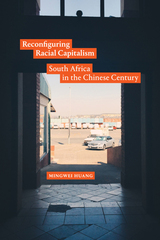 Reconfiguring Racial Capitalism: South Africa in the Chinese Century
Mingwei Huang
Duke University Press, 2024 In Reconfiguring Racial Capitalism, Mingwei Huang traces the development of new forms of racial capitalism in the twenty-first century. Through fieldwork in one of the “China malls” that has emerged along Johannesburg’s former mining belt, Huang identifies everyday relations of power and difference between Chinese entrepreneurs and African migrant workers in these wholesale shops. These relations, Huang contends, replicate and perpetuate global structures of white supremacy, anti-Blackness, capitalism, and colonialism, even when whiteness is not present. Huang argues that this dynamic reflects the sedimented legacies and continued operation of white supremacy and colonialism, which have been transformed in the shift of capitalism’s center of gravity toward China and the Global South. These new forms of racial capitalism and empire layer onto and extend histories of exploitation and racialization in South Africa. Taking a palimpsestic approach, Huang offers tools for understanding this shift and decentering contemporary Western conceptions of race, empire, and racial capitalism in the Chinese Century.
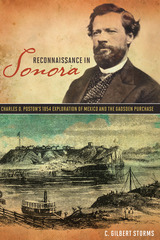 Reconnaissance in Sonora: Charles D. Poston’s 1854 Exploration of Mexico and the Gadsden Purchase
C. Gilbert Storms
University of Arizona Press, 2015 In 1854, funded by a syndicate of San Francisco businessmen, Charles D. Poston and a party of twenty-five men launched an expedition from San Francisco to Sinaloa and Sonora, Mexico, before trekking north into Arizona and returning to California. Reconnaissance in Sonora brings to light Poston’s handwritten report to the syndicate about the journey, published here for the first time.
Poston led his party through Sonora and the territory of the 1854 Gadsden Purchase, which today encompasses southern Arizona and a portion of southern New Mexico. The syndicate’s charge to the young adventurer was to acquire land in Mexico in anticipation of the Gadsden Purchase and the building of the transcontinental railroad. Reconnaissance in Sonora details Poston’s expedition, including the founding of the town of Colorado City at the site of present-day Yuma, Arizona.
C. Gilbert Storms explores the American ideas of territorial expansion and Manifest Destiny, the national debate over a route for a transcontinental railroad, the legends of rich gold and silver mines in northern Mexico, and the French and American filibusters that plagued northern Mexico in the early 1850s.
Reconnoitring Russia: Mapping, Exploring and Describing Early Modern Russia, 1613–1825
Denis J. B. Shaw
University College London, 2024 A geographical and historical analysis of Russian perspectives on the expansion of Russia.
Focusing on geographical practices—such as exploring, observing, describing, and mapping—Reconnoitring Russia explains how Russia’s rulers and public came to understand the expanse of their territory. It adopts a broad chronological framework and compares the Russian experience to the concurrent realities of other European countries between 1613, the emergence of the Romanov dynasty, and 1825, the conclusion of Alexander I’s reign.
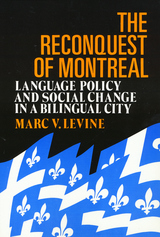 The Reconquest Of Montreal: Language Policy and Social Change in a Bilingual City
Marc V. Levine
Temple University Press, 1991 Although Montreal has been a bilingual city since 1760 and demographically dominated by French-speakers for well over a century and a quarter, it was not until the late 1960s that full-fledged challenges to the city’s English character emerged. Since then. two decades of agitation over la question linguistique as well as the enactment of three language laws have altered the places of French and English in Montreal‘s schools, public administration, economy. and even commercial signs. In this book, Marc Levine examines the nature of this stunning transformation and, in particular, the role of public policy in promoting it. The reconquest of Montreal by the French-speaking majority makes for interesting history. It includes episodes of intense conflict and occasional violence and tells the fascinating story of how an economically disadvantaged and culturally threatened linguistic community mobilized politically and used the state to redistribute group power in Canada’s second largest city. In addition, the history of Montreal’s language question offers analysts of urban politics and public policy an excellent case study of some of the central issues facing cities containing more than one major linguistic community. After tracing the politicization of the language question in the 1960s and 1970s, Levine analyzes the impact of the three controversial language laws penacted by the Quebec provincial government between 1969 and 1977. Exhaustively researched, The Reconquest of Montreal is the definitive study of the most explosive issue in Quebec political life. In the series Conflicts in Urban and Regional Development, edited by John R. Logan and Todd Swanstrom.
 Reconsidering Gender, Violence, and the State
Lisa Arellano, Erica L. Ball and Amanda Frisken, special issue editors
Duke University Press, 2016 A special issue of Radical History Review In bringing together a geographically and temporally broad range of interdisciplinary historical scholarship, this issue of Radical History Review offers an expansive examination of gender, violence, and the state. Through analyses of New York penitentiaries, anarchists in early twentieth-century Japan, and militarism in the 1990s, contributors reconsider how historical conceptions of masculinity and femininity inform the persistence of and punishments for gendered violence. The contributors to a section on violence and activism challenge the efficacy of state solutions to gendered violence in a contemporary U.S. context, highlighting alternatives posited by radical feminist and queer activists. In five case studies drawn from South Africa, India, Ireland, East Asia, and Nigeria, contributors analyze the archive's role in shaping current attitudes toward gender, violence, and the state, as well as its lasting imprint on future quests for restitution or reconciliation. This issue also features a visual essay on the "false positives" killings in Colombia and an exploration of Zanale Muholi’s postapartheid activist photography. Contributors: Lisa Arellano, Erica L. Ball, Josh Cerretti, Jonathan Culleton, Amanda Frisken, Raphael Ginsberg, Deana Heath, Efeoghene Igor, Catherine Jacquet, Jessie Kindig, Benjamin N. Lawrance, Jen Manion, Xhercis Méndez, Luis Morán, Claudia Salamanca, Tomoko Seto, Carla Tsampiras, Jennifer Yeager
 Reconsidering Intellectual Disability: L'Arche, Medical Ethics, and Christian Friendship
Jason Reimer Greig
Georgetown University Press, 2016 Drawing on the controversial case of “Ashley X,” a girl with severe developmental disabilities who received interventionist medical treatment to limit her growth and keep her body forever small—a procedure now known as the “Ashley Treatment”—Reconsidering Intellectual Disability explores important questions at the intersection of disability theory, Christian moral theology, and bioethics. What are the biomedical boundaries of acceptable treatment for those not able to give informed consent? Who gets to decide when a patient cannot communicate their desires and needs? Should we accept the dominance of a form of medicine that identifies those with intellectual impairments as pathological objects in need of the normalizing bodily manipulations of technological medicine? In a critical exploration of contemporary disability theory, Jason Reimer Greig contends that L'Arche, a federation of faith communities made up of people with and without intellectual disabilities, provides an alternative response to the predominant bioethical worldview that sees disability as a problem to be solved. Reconsidering Intellectual Disability shows how a focus on Christian theological tradition’s moral thinking and practice of friendship with God offers a way to free not only people with intellectual disabilities but all people from the objectifying gaze of modern medicine. L'Arche draws inspiration from Jesus's solidarity with the "least of these" and a commitment to Christian friendship that sees people with profound cognitive disabilities not as anomalous objects of pity but as fellow friends of God. This vital act of social recognition opens the way to understanding the disabled not as objects to be fixed but as teachers whose lives can transform others and open a new way of being human.
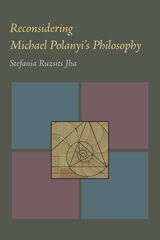 Reconsidering Michael Polanyi’s Philosophy
Stefania Ruzsits Jha
University of Pittsburgh Press, 2002 The chemist and philosopher Michael Polanyi (1891–1976) was one of the first twentieth-century scientists to propose a program to resolve the internal conflict of the modern Enlightenment: scientific detachment and moral nihilism with humanist values. Stefania Jha’s intellectual biography places Polanyi in the context of his time and culture, analyzes his key philosophical ideas, and explicates the application—and at times misappropriation—of his work.
Polanyi’s method was not laid out in his published works, and his vocabulary tends to make his writings difficult to understand. By exposing the structure of his theory of tacit knowing, and by tracing the growth of his thinking, Jha shows how the various elements of his thought are integrated. Through examination of his philosophical roots in Kant and the complexity of his evolving thought, she counteracts the popular notion that Polanyi’s philosophy stands apart from the western philosophic tradition.
Jha’s deep analysis makes Polanyi’s shift of focus from science to philosophy more intelligible, his philosophy more approachable, and the causes he championed—such as the freedom of science and cultural freedom—more understandable. Applying his notion of tacit knowing in practical directions, Jha seeks to bring the study of Polanyi’s philosophy out of the specialists’ enclave and into such fields as ethics and clinical medicine.
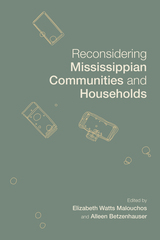 Reconsidering Mississippian Communities and Households
Edited by Elizabeth Watts Malouchos and Alleen Betzenhauser
University of Alabama Press, 2021 Explores the archaeology of Mississippian communities and households using new data and advances in method and theory
Published in 1995, Mississippian Communities and Households, edited by J. Daniel Rogers and Bruce D. Smith, was a foundational text that advanced southeastern archaeology in significant ways and brought household-level archaeology to the forefront of the field. Reconsidering Mississippian Communitiesand Households revisits and builds on what has been learned in the years since the Rogers and Smith volume, advancing the field further with the diverse perspectives of current social theory and methods and big data as applied to communities in Native America from the AD 900s to 1700s and from northeast Florida to southwest Arkansas.
Watts Malouchos and Betzenhauser bring together scholars researching diverse Mississippian Southeast and Midwest sites to investigate aspects of community and household construction, maintenance, and dissolution. Thirteen original case studies prove that community can be enacted and expressed in various ways, including in feasting, pottery styles, war and conflict, and mortuary treatments.
Reconsidering No Man Knows My History
edited by Newell G. Bringhurst
Utah State University Press, 1996 Fawn Brodie's biography of the founding Mormon prophet has received both praise and condemnation since it's publication in 1945. In 1995, at a symposium to mark its fiftieth anniversary, several scholars gathered together to re-examine Brodie, her Joseph Smith biography and its continuing importance. Bringhurst has brought together many of the essays from that meeting.
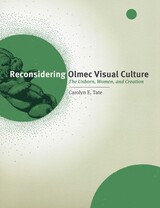 Reconsidering Olmec Visual Culture: The Unborn, Women, and Creation
By Carolyn E. Tate
University of Texas Press, 2012 Recently, scholars of Olmec visual culture have identified symbols for umbilical cords, bundles, and cave-wombs, as well as a significant number of women portrayed on monuments and as figurines. In this groundbreaking study, Carolyn Tate demonstrates that these subjects were part of a major emphasis on gestational imagery in Formative Period Mesoamerica. In Reconsidering Olmec Visual Culture, she identifies the presence of women, human embryos, and fetuses in monuments and portable objects dating from 1400 to 400 BC and originating throughout much of Mesoamerica. This highly original study sheds new light on the prominent roles that women and gestational beings played in Early Formative societies, revealing female shamanic practices, the generative concepts that motivated caching and bundling, and the expression of feminine knowledge in the 260-day cycle and related divinatory and ritual activities. Reconsidering Olmec Visual Culture is the first study that situates the unique hollow babies of Formative Mesoamerica within the context of prominent females and the prevalent imagery of gestation and birth. It is also the first major art historical study of La Venta and the first to identify Mesoamerica's earliest creation narrative. It provides a more nuanced understanding of how later societies, including Teotihuacan and West Mexico, as well as the Maya, either rejected certain Formative Period visual forms, rituals, social roles, and concepts or adopted and transformed them into the enduring themes of Mesoamerican symbol systems.
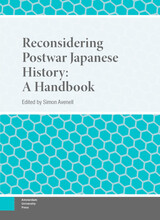 Reconsidering Postwar Japanese History: A Handbook
Simon Avenell
Amsterdam University Press, 2023 After war defeat in 1945, Japan underwent historic political, economic and social transformations resulting in the country’s rebirth as an economic powerhouse and exemplar of liberal democracy in East Asia. This handbook expands and enriches our understanding of this tumultuous contemporary era in Japan’s modern history. Chapters in the volume ask novel theoretical questions and present fresh empirical perspectives on the era. How, for example, has the postwar era been chronologized to date and how might we rethink or enhance such interpretations? What can we learn by rethinking established moments and phases like the Allied Occupation, the period of high-speed economic growth, the 1970s, the Bubble Economy, and the “lost decades” of Heisei Japan (1989-2019)? What new issues might we introduce to subvert accepted understandings of the postwar era and its various sub-eras? Moreover, how might Japan’s internal postwar be expanded by rethinking the era through novel historical frameworks and regional imaginaries such as East Asian history, Cold War history, environmental history and transnational history? Contributors attempt to transcend temporal, geographical, intellectual and other boundaries inherent in our current understandings of Japan’s postwar experience to provide a compelling compilation of perspectives. Showcasing the work of historians and leading scholars from other disciplines, chapters cover thematic areas including the origins of the postwar era, postwar politics, society and popular culture, transnational and international interactions, and historical memory. The volume’s extensive chronological coverage, combined with the innovative perspectives of the contributors, make it essential reading for both researchers and learners interested in the multifaceted dynamics of Japan’s fascinating contemporary era.
Reconsidering Roosevelt on Race: How the Presidency Paved the Road to Brown
Kevin J. McMahon
University of Chicago Press, 2003 Many have questioned FDR's record on race, suggesting that he had the opportunity but not the will to advance the civil rights of African Americans. Kevin J. McMahon challenges this view, arguing instead that Roosevelt's administration played a crucial role in the Supreme Court's increasing commitment to racial equality—which culminated in its landmark decision in Brown v. Board of Education.
McMahon shows how FDR's attempt to strengthen the presidency and undermine the power of conservative Southern Democrats dovetailed with his efforts to seek racial equality through the federal courts. By appointing a majority of rights-based liberals deferential to presidential power, Roosevelt ensured that the Supreme Court would be receptive to civil rights claims, especially when those claims had the support of the executive branch.
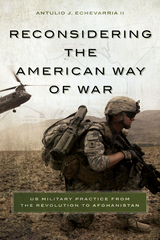 Reconsidering the American Way of War: US Military Practice from the Revolution to Afghanistan
Antulio J. Echevarria II
Georgetown University Press, 2014 Challenging several longstanding notions about the American way of war, this book examines US strategic and operational practice from 1775 to 2014. It surveys all major US wars from the War of Independence to the campaigns in Iraq and Afghanistan, as well as most smaller US conflicts to determine what patterns, if any, existed in American uses of force. Contrary to many popular sentiments, Echevarria finds that the American way of war is not astrategic, apolitical, or defined by the use of overwhelming force. Instead, the American way of war was driven more by political considerations than military ones, and the amount of force employed was rarely overwhelming or decisive. As a scholar of Clausewitz, Echevarria borrows explicitly from the Prussian to describe the American way of war not only as an extension of US policy by other means, but also the continuation of US politics by those means. The book’s focus on strategic and operational practice closes the gap between critiques of American strategic thinking and analyses of US campaigns. Echevarria discovers that most conceptions of American strategic culture fail to hold up to scrutiny, and that US operational practice has been closer to military science than to military art. Providing a fresh look at how America’s leaders have used military force historically and what that may mean for the future, this book should be of interest to military practitioners and policymakers, students and scholars of military history and security studies, and general readers interested in military history and the future of military power.
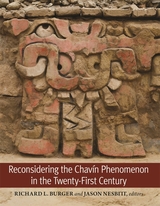 Reconsidering the Chavín Phenomenon in the Twenty-First Century
Richard L. Burger and Jason Nesbitt
Harvard University Press The UNESCO World Heritage Site of Chavín de Huántar holds an iconic place in the archaeology of pre-Columbian Peru and is crucial to understanding the emergence of Andean civilization during the early first millennium BCE. Best known for its elaborate religious architecture and distinctive stone sculpture, Chavín de Huántar was the center of a much wider Andean world and the synchronicity of widespread socioeconomic changes coupled with intrusive Chavín material culture and iconography at distant centers suggests that Chavín de Huántar influenced a vast region through the expansion of religious ideology and intensified long-distance interaction.
Reconsidering the Chavín Phenomenon in the Twenty-First Century builds upon a surge of archaeological research over the last twenty years, bringing together the work of scholars researching Chavín de Huántar and its neighbors on the coast, highlands, and ceja de selva. This volume offers a cohesive vision of the Chavín Phenomenon at both the local and interregional level, one which recognizes the high degree of socioeconomic and cultural diversity that existed and the active role of centers outside the Chavín heartland in shaping the radical transformations that occurred within the Chavín Interaction Sphere between 1000 and 400 BCE.
 Reconsidering the Insular Cases: The Past and Future of the American Empire
Gerald L. Neuman
Harvard University Press, 2015 Over a century has passed since the United States Supreme Court decided a series of cases, known as the “Insular Cases,” that limited the applicability of constitutional rights in Puerto Rico and other overseas territories and allowed the United States to hold them indefinitely as subordinated possessions without the promise of representation or statehood. Essays in this volume, which originated in a Harvard Law School conference, reconsider the Insular Cases. Leading legal authorities examine the history and legacy of the cases, which are tinged with outdated notions of race and empire, and explore possible solutions for the dilemmas they created. Reconsidering the Insular Cases is particularly timely in light of the latest referendum in Puerto Rico expressing widespread dissatisfaction with its current form of governance, and litigation by American Samoans challenging their unequal citizenship status. This book gives voice to a neglected aspect of U.S. history and constitutional law and provides a rich context for rethinking notions of sovereignty, citizenship, race, and place, as well as the roles of law and politics in shaping them.
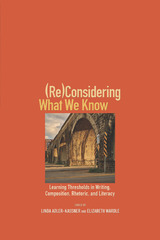 (Re)Considering What We Know: Learning Thresholds in Writing, Composition, Rhetoric, and Literacy
Linda Adler-Kassner
Utah State University Press, 2019 Naming What We Know: Threshold Concepts of Writing Studies, published in 2015, contributed to a discussion about the relevance of identifying key concepts and ideas of writing studies. (Re)Considering What We Know continues this conversation while simultaneously raising questions about the ideas around threshold concepts. New contributions introduce additional concepts, investigate threshold concepts as a framework, and explore their use within and beyond writing.
Part 1 raises questions about the ideologies of consensus that are associated with naming threshold concepts of a discipline. Contributions challenge the idea of consensus and seek to expand both the threshold concepts framework and the concepts themselves. Part 2 focuses on threshold concepts in action and practice, demonstrating the innovative ways threshold concepts and a threshold concepts framework have been used in writing courses and programs. Part 3 shows how a threshold concepts framework can help us engage in conversations beyond writing studies.
(Re)Considering What We Know raises new questions and offers new ideas that can help to advance the discussion and use of threshold concepts in the field of writing studies. It will be of great interest to scholars and graduate students in writing studies, especially those who have previously engaged with Naming What We Know.
Contributors:
Marianne Ahokas, Jonathan Alexander, Chris M. Anson, Ian G. Anson, Sarah Ben-Zvi, Jami Blaauw-Hara, Mark Blaauw-Hara, Maggie Black, Dominic Borowiak, Chris Castillo, Chen Chen, Sandra Descourtis, Norbert Elliot, Heidi Estrem, Alison Farrell, Matthew Fogarty, Joanne Baird Giordano, James Hammond, Holly Hassel, Lauren Heap, Jennifer Heinert, Doug Hesse, Jonathan Isaac, Katie Kalish, Páraic Kerrigan, Ann Meejung Kim, Kassia Krzus-Shaw, Saul Lopez, Jennifer Helane Maher, Aishah Mahmood, Aimee Mapes, Kerry Marsden, Susan Miller-Cochran, Deborah Mutnick, Rebecca Nowacek, Sarah O’Brien, Ọlá Ọládipọ̀, Peggy O’Neill, Cassandra Phillips, Mya Poe, Patricia Ratanapraphart, Jacqueline Rhodes, Samitha Senanayake, Susan E. Shadle, Dawn Shepherd, Katherine Stein, Patrick Sullivan, Brenna Swift, Carrie Strand Tebeau, Matt Thul, Nikhil Tiwari, Lisa Tremain, Lisa Velarde, Kate Vieira, Gordon Blaine West, Anne-Marie Womack, Kathleen Blake Yancey, Xiaopei Yang, Madylan Yarc
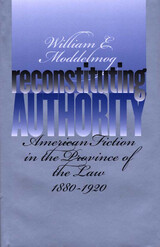 Reconstituting Authority: American Fiction in the Province of the Law, 1880-1920
William E. Moddelmog
University of Iowa Press, 2000 In Reconstituting Authority, William Moddelmog explores the ways in which American law and literature converged in the late nineteenth and early twentieth centuries. Through close readings of significant texts from the era, he reveals not only how novelists invoked specific legal principles and ideals in their fictions but also how they sought to reconceptualize the boundaries of law and literature in ways that transformed previous versions of both legal and literary authority. Moddelmog does not assume a sharp distinction between literary and legal institutions and practices but shows how writers imagined the two fields as engaged in the same cultural process. He argues that because the law was instrumental in setting the terms by which concepts such as race, gender, nationhood, ownership, and citizenship were defined in the nineteenth century, authors challenging those definitions had to engage the law on its own terrain: to place their work in a dialogue with the law by telling stories that were already authorized (though perhaps suppressed) by legal institutions. The first half of the book is devoted in separate chapters to William Dean Howells, Helen Hunt Jackson, and Pauline Hopkins. The focus shifts from large theoretical concerns to questions of contract and native sovereignty, to issues of African American citizenship and racial entitlement. In each case the discussion is rooted in a larger consideration of the rule (or misrule) of law.
The second half of the book turns from the rule of law to the issue of property, specifically the Lockean version of the self that tied identity to legal conceptions of property and economic value. In separate discussions of Charles Chesnutt, Edith Wharton, and Theodore Dreiser, Reconstituting Authority reveals authors as closely engaged with those changing perspectives on property and identity, in ways that challenged the racial, gendered, and economic consequences of America's possessive individualism.
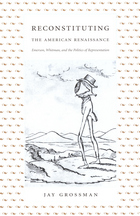 Reconstituting the American Renaissance: Emerson, Whitman, and the Politics of Representation
Jay Grossman
Duke University Press, 2003 Challenging the standard periodization of American literary history, Reconstituting the American Renaissance reinterprets the works of Ralph Waldo Emerson and Walt Whitman and the relationship of these two authors to each other. Jay Grossman argues that issues of political representation—involving vexed questions of who shall speak and for whom—lie at the heart of American political and literary discourse from the revolutionary era through the Civil War. By taking the mid-nineteenth-century period, traditionally understood as marking the advent of literary writing in the United States, and restoring to it the ways in which Emerson and Whitman engaged with eighteenth-century controversies, rhetorics, and languages about political representation, Grossman departs significantly from arguments that have traditionally separated American writing in the eighteenth and nineteenth centuries. Reconstituting the American Renaissance describes how Emerson and Whitman came into the period of their greatest productivity with different conceptions of the functions and political efficacy of the word in the world. It challenges Emerson’s position as Whitman’s necessary precursor and offers a cultural history that emphasizes the two writers’ differences in social class, cultural experience, and political perspective. In their writings between 1830 and 1855, the book finds contrasting conceptions of the relations between the “representative man” and the constituencies to whom, and for whom, he speaks. Reconstituting the American Renaissance opens up the canonical relationship between Emerson and Whitman and multiplies the historical and discursive contexts for understanding their published and unpublished works.
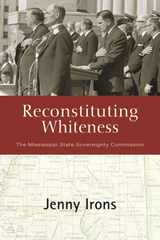 Reconstituting Whiteness: The Mississippi State Sovereignty Commission
Jenny Irons
Vanderbilt University Press, 2010 In Reconstituting Whiteness, sociologist Jenny Irons explores the tactics and legacy of the Mississippi State Sovereignty Commission, an agency of the state that existed from 1956 to 1977 and was devoted exclusively to defending and supporting the institution of segregation. Using a myriad of surveillance and public relations efforts, the commission was unique in its expanse and resistance during a time of change.
Going far beyond a mere institutional history, however, Irons uses the commission as a tool to explore the intersection of state-organized defense of white supremacy and the dramatically shifting racial constructs of the civil rights era. Ultimately, the commission failed to protect segregation, but as a state entity, it adapted racism in new terms.
Reconstituting Whiteness is an insightful study of the methods Mississippi state government used to move the goal posts of what was considered "decent" and "acceptable" white supremacy and racism, as it raced against time to define whiteness while the boundaries of segregation fell all around it.
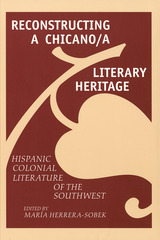 Reconstructing a Chicano/a Literary Heritage: Hispanic Colonial Literature of the Southwest
Edited by María Herrera-Sobek
University of Arizona Press, 1993 Early literary works written in Spanish in what is today the American Southwest have been largely excluded from the corpus of American literature, yet these documents are the literary antecedents of contemporary Chicano and Chicana writing. This collection of essays establishes the importance of this literary heritage through a critical examination of key texts produced in the Southwest from 1542 to 1848. Drawing on research in the archives of southwestern libraries and applying contemporary literary theoretical constructs to these centuries-old manuscripts, the authors—all noted scholars in Chicano literature—demonstrate that these works should be recognized as an integral part of American literature.
Contributors:
Juan Bruce-Novoa
Ramón Gutiérrez
María Herrera-Sobek
Enrique Lamadrid
Luis Leal
Francisco A. Lomelí
Genaro Padilla
Tey Diana Rebolledo
Tino Villanueva
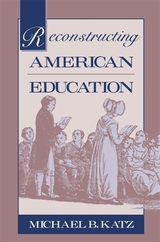 Reconstructing American Education
Michael B. Katz
Harvard University Press, 1987 One of the leading historians of education in the United States here develops a powerful interpretation of the uses of history in educational reform and of the relations among democracy, education, and the capitalist state. Michael Katz discusses the reshaping of American education from three perspectives. First is the perspective of history: How did American education take shape? The second is that of reform: What can a historian say about recent criticisms and proposals for improvement? The third is that of historiography: What drives the politics of educational history? Katz shows how the reconstruction of America’s educational past can be used as a framework for thinking about current reform. Contemporary concepts such as public education, institutional structures such as the multiversity, and modern organizational forms such as bureaucracy all originated as solutions to problems of public policy. The petrifaction of these historical products—which are neither inevitable nor immutable—has become, Katz maintains, one of the mighty obstacles to change.
The book’s central questions are as much ethical and political as they are practical. How do we assess the relative importance of efficiency and responsiveness in educational institutions? Whom do we really want institutions to serve? Are we prepared to alter institutions and policies that contradict fundamental political principles? Why have some reform strategies consistently failed? On what models should institutions be based? Should schools and universities be further assimilated to the marketplace and the state? Katz’s iconoclastic treatment of these issues, vividly and clearly written, will be of interest to both specialists and general readers. Like his earlier classic, The Irony of Early School Reform (1968), this book will set a fresh agenda for debate in the field.
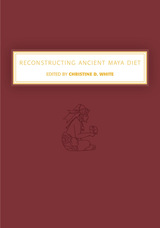 Reconstructing Ancient Maya Diet
Christine White
University of Utah Press, 1999 The collapse of classic Maya civilization at the end of the eighth century A.D. is still an enigma, but the story behind it is likely more than a clash of warring city-states. New research indicates that ecological degradation and nutritional deficiency may be as important to our understanding of Maya cultural processes as deciphering the rise and fall of kings.
Reconstructing Ancient Maya Diet integrates recent data from bone-chemistry research, paleopathology, paleobotany, zooarchaeology, and ethnobotany to show what the ancient Maya actually ate at various periods (as opposed to archaeological suppositions) and how it affected the quality of their lives. It is now evident that to feed a burgeoning population the Maya relied on increasingly intensive forms of agriculture.
Exploring the relationship between these practices, ecological degradation, and social collapse, this book uses dietary data to investigate the rise of agricultural systems and class structure; the characterization of social relationships along lines of gender and age (i.e., who ate what); and the later effects of the Spanish conquest on diet and extant modes of agriculture.
Maya subsistence has been investigated intensively for the past two decades, but this is the first volume that unites work across the spectrum of Maya bioarchaeology.
 Reconstructing Architecture: Critical Discourses and Social Practices
Thomas A. Dutton and Lian Hurst Mann, Editors
University of Minnesota Press, 1996 Reconstructing Architecture was first published in 1996. Minnesota Archive Editions uses digital technology to make long-unavailable books once again accessible, and are published unaltered from the original University of Minnesota Press editions. To create architecture is an inherently political act, yet its nature as a social practice is often obscured beneath layers of wealth and privilege. The contributors to this volume question architecture's complicity with the status quo, moving beyond critique to outline the part architects are playing in building radical social movements and challenging dominant forms of power. The making of architecture is instrumental in the construction of our identities, our differences, the world around us-much of what we know of institutions, the distribution of power, social relations, and cultural values is mediated by the built environment. Historically, architecture has constructed the environments that house the dominant culture. Yet, as the essays in Reconstructing Architecture demonstrate, there exists a strong tradition of critical practice in the field, one that attempts to alter existing social power relations. Engaging the gap between modernism and postmodernism, each chapter addresses an oppositional discourse that has developed within the field and then reconstructs it in terms of a new social project: feminism, social theory, environmentalism, cultural studies, race and ethnic studies, and critical theory. The activists and scholars writing here provide a clarion call to architects and other producers of culture, challenging them to renegotiate their political allegiances and to help reconstruct a viable democratic life in the face of inexorable forces driving economic growth, destroying global ecology, homogenizing culture, and privatizing the public realm. Reconstructing Architecture reformulates the role of architecture in society as well as its capacity to further a progressive social transformation. Contributors: Sherry Ahrentzen, U of Wisconsin, Milwaukee; Bradford C. Grant, California Polytechnic State U, San Luis Obispo; Richard Ingersoll, Rice U; Margaret Soltan, George Washington U; Anthony Ward, U of Auckland, New Zealand. Thomas A. Dutton is an architect and professor of architecture at Miami University, Ohio. He is editor of Voices in Architectural Education (1991) and is associate editor of the Journal of Architectural Education. Lian Hurst Mann is an architect and editor of Architecture California. A founding member of the Labor/Community Strategy Center in Los Angeles, she is editor of its bilingual quarterly Ahora Now and a coauthor of Reconstructing Los Angeles from the Bottom Up (1993).
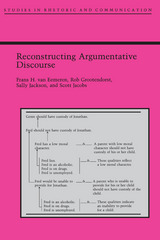 Reconstructing Argumentative Discourse
Frans Van Eemeren
University of Alabama Press, 1993 Reconstructing Argumentative Discourse analyzes argumentation in ordinary disputes. The analysis begins with an ideal model: a theoretical structure of discourse that might be used to resolve a dispute about the merits of two opposing cases. The ideal model does not describe actual argumentative practice. Argumentative discourse does not always seek genuine resolution and, when it does, the participants may not perform as ideal arguers. A central challenge for argumentation theory is to give an account of argumentation occurring under less-than-ideal conditions and conducted by less-than-ideal participants. The authors offer detailed analysis of argument in such contexts as ordinary conversation, third party dispute mediation, and religious confrontation. An adequate analytic approach to such forms of discourse, the authors argue, must offer critical insight into actual practice; must begin with a defensible normative standard against which practice can be compared; and must also offer an applicable analytic machinery for making the comparison, so its methods can be tailored to empirical circumstances. The authors position their study of argumentation within a general “normative pragmatics” characterized by a dual commitment to usefulness and adequacy in description. A distinctive set of practical applications and a distinctive view of practicality follow from this approach, characterized not by the search for generalizable means-end relationships but by the development and testing of plans for making real argumentation look as much as possible like ideal argumentation. This book integrates for the first time the normative interest of dialectical theories of argumentation with the descriptive interests of the empirical study of everyday language use. This ambitious project is achieved by adopting a distinctively social and pragmatic view of argumentation—by seeing argumentation as a language activity structured for the function of resolving disagreements. The authors examine argumentation in a wide variety of contexts—including everyday conversation, campus evangelism, political speeches, newspaper letters to the editor, and the formal mediation of disputes. In doing so, they illustrate how to analyze the details of actual argumentation and tackle a variety of theoretical and methodological puzzles encountered in the effort to apply normative models to real life argumentation.
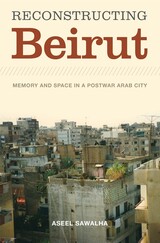 Reconstructing Beirut: Memory and Space in a Postwar Arab City
By Aseel Sawalha
University of Texas Press, 2010 Once the cosmopolitan center of the Middle East, Beirut was devastated by the civil war that ran from 1975 to 1991, which dislocated many residents, disrupted normal municipal functions, and destroyed the vibrant downtown district. The aftermath of the war was an unstable situation Sawalha considers "a postwar state of emergency," even as the state strove to restore normalcy. This ethnography centers on various groups' responses to Beirut's large, privatized urban-renewal project that unfolded during this turbulent moment. At the core of the study is the theme of remembering space. The official process of rebuilding the city as a node in the global economy collided with local day-to-day concerns, and all arguments invariably inspired narratives of what happened before and during the war. Sawalha explains how Beirutis invoked their past experiences of specific sites to vie for the power to shape those sites in the future. Rather than focus on a single site, the ethnography crosses multiple urban sites and social groups, to survey varied groups with interests in particular spaces. The book contextualizes these spatial conflicts within the discourses of the city's historical accounts and the much-debated concept of heritage, voiced in academic writing, politics, and journalism. In the afterword, Sawalha links these conflicts to the social and political crises of early twenty-first-century Beirut.
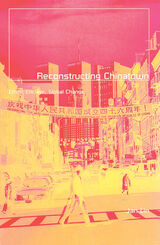 Reconstructing Chinatown: Ethnic Enclave, Global Change
Jan Lin
University of Minnesota Press, 1998 An exploration of this fascinating community as a window on globalization. In the American popular imagination, Chinatown is a mysterious and dangerous place, clannish and dilapidated, filled with sweatshops, vice, and organized crime. In this well-written and engaging volume, Jan Lin presents a real-world picture of New York City’s Chinatown, countering this “orientalist” view by looking at the human dimensions and the larger forces of globalization that make this vital neighborhood both unique and broadly instructive. Using interviews with residents, firsthand observation, archival research, and U.S. census data, Lin delivers an informed, reliable picture of Chinatown today. Lin claims that to understand contemporary ethnic neighborhoods like this one we must dispense with notions of monolithic “community.” When he looks at Chinatown, Lin sees a neighborhood that is being rebuilt, both literally and economically. Rather than a clannish and unified peer group, he sees substantial class inequality and internal social conflict. There is also social change, most visibly manifested in dramatic episodes of collective action by sweatshop workers and community activists and in the growing influence of Chinatown’s denizens in electoral politics. Popular portrayals of Chinatown also reflect a new global reality: as American cities change with the international economy, traditional assumptions about immigrant incorporation into U.S. society alter as well. Lin describes the public disquiet and official response regarding immigration, sweatshops, and the influx of Asian capital. He outlines the ways that local, state, and federal governments have directed and gained from globalization in Chinatown through banking deregulation and urban redevelopment policy. Finally, Lin puts forth Chinatown as a central enclave in the “world city” of New York, arguing that globalization brings similar structural processes of urban change to diverse locations. In the end, Lin moves beyond the myth of Chinatown, clarifying the meaning of globalization and its myriad effects within the local context.
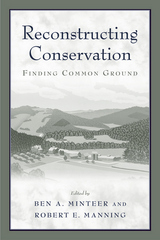 Reconstructing Conservation: Finding Common Ground
Edited by Ben A. Minteer and Robert E. Manning
Island Press, 2003 In the 1990s, influenced by the deconstructionist movement in literary theory and trends toward revisionist history, a cadre of academics and historians led by William Cronon began raising provocative questions about ideas of wilderness and the commitments and strategies of the contemporary environmental movement. While these critiques challenged some cherished and widely held beliefs -- and raised the hackles of many in the environmental community -- they also stimulated an important and potentially transformative debate about the conceptual foundations of environmentalism. Reconstructing Conservation makes a vital contribution to that debate, bringing together 23 leading scholars and practitioners -- including J. Baird Callicott, Susan Flader, Richard Judd, Curt Meine, Bryan Norton, and Paul B. Thompson -- to examine the classical conservation tradition and its value to contemporary environmentalism. Focusing not just on the tensions that have marked the deconstructivist debate over wilderness and environmentalism, the book represents a larger and ultimately more constructive and hopeful discussion over the proper course of future conservation scholarship and action. Essays provide a fresh look at conservation icons such as George Perkins Marsh and Aldo Leopold, as well as the contributions of lesser-known figures including Lewis Mumford, Benton MacKaye, and Scott Nearing. Represented are a wealth of diverse perspectives, addressing such topics as wilderness and protected areas, cultural landscapes, rural/agrarian landscapes, urban/built environments, and multiple points on the geographic map. Contributors offer enthusiastic endorsements of pluralism in conservation values and goals along with cautionary tales about the dangers of fragmentation and atomism. The final chapter brings together the major insights, arguments, and proposals contained in the individual contributions, synthesizing them into a dozen broad-ranging principles designed to guide the study and practice of conservation. Reconstructing Conservation assesses the meaning and relevance of our conservation inheritance in the 21st century, and represents a conceptually integrated vision for reconsidering conservation thought and practice to meet the needs and circumstances of a new, post-deconstructivist era.
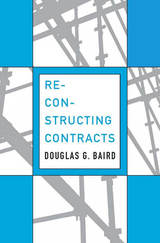 Reconstructing Contracts
Douglas G. Baird
Harvard University Press, 2013 Every legal system must decide how to distinguish between agreements that are enforceable and those that are not. Formal bargains in the marketplace and casual promises in a social setting mark the two extremes, but many hard cases lie between. When gaps are left in a contract, how should courts fill them? What does it mean to say that an agreement is legally enforceable? If someone breaks a legally enforceable contract, what consequences follow?
For 150 years, legal scholars have debated whether a set of coherent principles provide answers to such basic questions. Oliver Wendell Holmes put forward the affirmative case, arguing that bargained-for consideration, expectation damages, and a handful of related ideas captured the essence of contract law. The work of the next several generations, culminating in Grant Gilmore’s The Death of Contract in 1974, took a contrary view. The coherence Holmes had tried to bring to the field was illusory. It was more sensible to see contracts as merely a species of civil obligation and resist the temptation to impose rigid and artificial rules.
In Reconstructing Contracts, Douglas Baird takes stock of the current state of contract doctrine and in the process reinvigorates the classic framework of Anglo-American contract law. He shows that Holmes’s principles are fundamentally sound. Even if they lack that talismanic quality formerly ascribed to them, properly understood they continue to provide the best guide to contracts for a new generation of students, practitioners, and judges.
 Reconstructing Democracy: How Citizens Are Building from the Ground Up
Charles Taylor, Patrizia Nanz, and Madeleine Beaubien Taylor
Harvard University Press, 2020 “An urgent manifesto for the reconstruction of democratic belonging in our troubled times.” —Davide Panagia
Across the world, democracies are suffering from a disconnect between the people and political elites. In communities where jobs and industry are scarce, many feel the government is incapable of understanding their needs or addressing their problems. The resulting frustration has fueled the success of destabilizing demagogues. To reverse this pattern and restore responsible government, we need to reinvigorate democracy at the local level. But what does that mean? Drawing on examples of successful community building in cities large and small, from a shrinking village in rural Austria to a neglected section of San Diego, Reconstructing Democracy makes a powerful case for re-engaging citizens. It highlights innovative grassroots projects and shows how local activists can form alliances and discover their own power to solve problems.
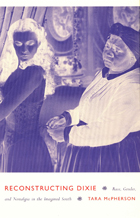 Reconstructing Dixie: Race, Gender, and Nostalgia in the Imagined South
Tara McPherson
Duke University Press, 2003 The South has long played a central role in America’s national imagination—the site of the trauma of slavery and of a vast nostalgia industry, alternatively the nation’s moral other and its moral center. Reconstructing Dixie explores how ideas about the South function within American culture. Narratives of the region often cohere around such tropes as southern hospitality and the southern (white) lady. Tara McPherson argues that these discursive constructions tend to conceal and disavow hard historical truths, particularly regarding race relations and the ways racial inequities underwrite southern femininity. Advocating conceptions of the South less mythologized and more tethered to complex realities, McPherson seeks to bring into view that which is repeatedly obscured—the South’s history of both racial injustice and cross-racial alliance. Illuminating crucial connections between understandings of race, gender, and place on the one hand and narrative and images on the other, McPherson reads a number of representations of the South produced from the 1930s to the present. These are drawn from fiction, film, television, southern studies scholarship, popular journalism, music, tourist sites, the internet, and autobiography. She examines modes of affect or ways of "feeling southern" to reveal how these feelings, along with the narratives and images she discusses, sanction particular racial logics. A wide-ranging cultural studies critique, Reconstructing Dixie calls for vibrant new ways of thinking about the South and for a revamped and reinvigorated southern studies. Reconstructing Dixie will appeal to scholars in American, southern, and cultural studies, and to those in African American, media, and women’s studies.
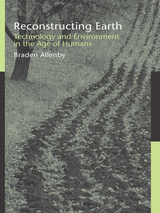 Reconstructing Earth: Technology and Environment in the Age of Humans
Braden Allenby
Island Press, 2005 The Earth's biological, chemical, and physical systems are increasingly shaped by the activities of one species-ours. In our decisions about everything from manufacturing technologies to restaurant menus, the health of the planet has become a product of human choice. Environmentalism, however, has largely failed to adapt to this new reality. Reconstructing Earth offers seven essays that explore ways of developing a new, more sophisticated approach to the environment that replaces the fantasy of recovering pristine landscapes with a more grounded viewpoint that can foster a better relationship between humans and the planet. Braden Allenby, a lawyer with degrees in both engineering and environmental studies, explains the importance of technological choice, and how that factor is far more significant in shaping our environment (in ways both desirable and not) than environmental controls. Drawing on his varied background and experience in both academia and the corporate world, he describes the emerging field of "earth systems engineering and management," which offers an integrated approach to understanding and managing complex human/natural systems that can serve as a basis for crafting better, more lasting solutions to widespread environmental problems. Reconstructing Earth not only critiques dysfunctional elements of current environmentalism but establishes a foundation for future environmental management and progress, one built on an understanding of technological evolution and the cultural systems that support modern technologies. Taken together, the essays offer an important means of developing an environmentalism that is robust and realistic enough to address the urgent realities of our planet. Reconstructing Earth is a thought-provoking new work for anyone concerned with the past or future of environmental thought, including students and teachers of environmental studies, environmental policy, technology policy, technological evolution, or sustainability.
 Reconstructing Europe after the Great War
Dan P. Silverman
Harvard University Press, 1982 This is the story of how the economists, bankers, and politicians of Britain, France, and the United States approached the financial crisis of 1918–1923 after the most devastating of wars. It captures the emotional demands for rapid recovery and reconstruction of Europe as well as the machinations of countries already jousting for economic advantage in peace. It’s also a timely book because the West today faces similar problems with little more in the way of theory or tools for repair than after World War I, and with an evident loss of historical memory.
Dan Silverman places the reparations issue in proper perspective as only one of many complex problems. He demonstrates that the war produced a crisis in financial and monetary theory as well as in fact. Theory proved inadequate to the requirements of balancing budgets, liquidating massive debts, halting inflation, and stabilizing foreign exchange. In fact, the English and Americans imposed their economic orthodoxy on their less fortunate French ally and their former German adversary.
One of the more remarkable results of Silverman’s research is the reversal of the old view that France responded to its allies’ economic demands with intransigence, ignorance, and incompetence. Instead, Silverman depicts France as legitimately pursuing its own national self-interest, fighting Anglo-American hegemony, and defending itself as a debtor nation against the creditors who were its “allies.”
Reconstructing Europe's Trade and Payments
Barry Eichengreen
University of Michigan Press, 1993 This title was formally part of the Studies in International Trade Policy Series, now called Studies in International Economics.
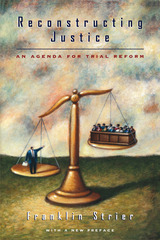 Reconstructing Justice: An Agenda for Trial Reform
Franklin Strier
University of Chicago Press, 1996 In Reconstructing Justice, Franklin Strier doesn't simply describe problems with the American trial system; he proposes reforms. Arguing that lawyers need to share more power with the judge and jury, Strier recommends ways we can retain and improve our basic adversarial system. He suggests we eliminate peremptory challenges, give judges the authority to ask questions of witnesses, and limit the number of expert witnesses. Drawing from a wide variety of sources, including case histories, scholarly works, Blackstone's Commentaries, and The Federalist Papers, he argues that judicial reform is not only possible, but—because of the increased public coverage of trials and understanding of the need for reform—inevitable.
Franklin Strier brings this critical look at trial reform up to date with a new preface in which he discusses how the inordinate amount of public attention of the O. J. Simpson trial, and the power the attorneys had over the court in that case, shed new light on the trial system's weaknesses and inequities.
"Anyone with an interest in courtroom trials will be fascinated by Strier's analysis of the game of law and suggestions for reforming the trail system to provide justice in a greater number of cases. . . . Highly recommended."—Choice
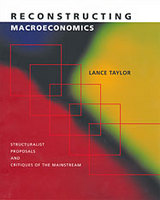 Reconstructing Macroeconomics: Structuralist Proposals and Critiques of the Mainstream
Lance Taylor
Harvard University Press, 2004 Macroeconomics is in disarray. No one approach is dominant, and an increasing divide between theory and empirics is evident.
This book presents both a critique of mainstream macroeconomics from a structuralist perspective and an exposition of modern structuralist approaches. The fundamental assumption of structuralism is that it is impossible to understand a macroeconomy without understanding its major institutions and distributive relationships across productive sectors and social groups.
Lance Taylor focuses his critique on mainstream monetarist, new classical, new Keynesian, and growth models. He examines them from a historical perspective, tracing monetarism from its eighteenth-century roots and comparing current monetarist and new classical models with those of the post-Wicksellian, pre-Keynesian generation of macroeconomists. He contrasts the new Keynesian vision with Keynes's General Theory, and analyzes contemporary growth theories against long traditions of thought about economic development and structural change.
Reconstructing Prehistory: Scientific Method in Archaeology
James Bell
Temple University Press, 1994 Reevaluating the method of scientific investigation, James A. Bell provides a bold philosophical framework for developing and assessing archaeologists' theories of the past. More informed and judicious decisions, the author asserts, are made when archaeologists explore questions such as: • How can theories be formulated so that they increase understanding and provide insight, and are theories still useful when they do not? • How can theories be adjusted when anomalies are revealed? • How can theories be assessed against competing theories? • When should theories be abandoned, and when should they be pursued further? With numerous examples from archaeology as well as comparative examples from the physical and biological sciences, Bell illustrates how exploring the answers to these and related inquiries will lead to improved formulation and testing of theories.
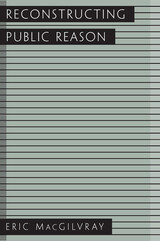 Reconstructing Public Reason
Eric A. MacGilvray
Harvard University Press, 2004 Can a liberal polity act on pressing matters of public concern in a way that respects the variety of beliefs and commitments that its citizens hold? Recent efforts to answer this question typically begin by seeking an uncontroversial starting point from which legitimate public ends can be said to follow. This reluctance to admit controversial beliefs as legitimate grounds for public action threatens to prevent us from responding effectively to many of the leading social and political challenges that we face.
Eric MacGilvray argues that we should shift our attention away from the problem of identifying uncontroversial public ends in the present and toward the problem of evaluating potentially controversial public ends through collective inquiry over time. Rather than ask ourselves which public ends are justified, we must instead decide which public ends we should seek to justify.
Reconstructing Public Reason offers a fundamental rethinking of the nature and aims of liberal toleration, and of the political implications of pragmatic philosophy. It also provides fresh interpretations of founding pragmatic thinkers such as John Dewey and William James, and of leading contemporary figures such as John Rawls and Richard Rorty.
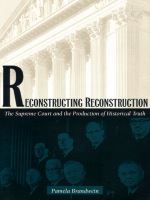 Reconstructing Reconstruction: The Supreme Court and the Production of Historical Truth
Pamela Brandwein
Duke University Press, 1999 Was slavery over when slaves gained formal emancipation? Was it over when the social, economic, and political situation for African Americans no longer mimicked the conditions of slavery? If the Thirteenth Amendment abolished it in 1865, why did most of the disputed points during the Reconstruction debates of 1866–75 concern issues of slavery? In this book Pamela Brandwein examines the post–Civil War struggle between competing political and legal interpretations of slavery and Reconstruction to reveal how accepted historical truth was established.
Delving into the circumstances, assumptions, and rhetoric that shaped the “official” story of Reconstruction, Brandwein describes precisely how a dominant interpretation of events ultimately emerged and what its implications have been for twentieth-century judicial decisions, particularly for Supreme Court rulings on civil rights. While analyzing interpretive disputes about slavery, Brandwein offers a detailed rescoring of post–Civil War legislative and constitutional history, including analysis of the original understanding of the Fourteenth Amendment. She identifies the perspectives on Reconstruction that were endorsed or rejected by the Supreme Court. Explaining what it meant—theoretically and practically—to resolve Reconstruction debates with a particular definition of slavery, Brandwein recounts how the Northern Democratic definition of “ending” slavery was not the only definition, just the one that prevailed. Using a familiar historical moment to do new interpretive work, she outlines a sociology of constitutional law, showing how subjective narrative construction can solidify into opaque institutional memory.
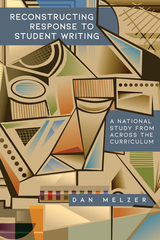 Reconstructing Response to Student Writing: A National Study from across the Curriculum
Dan Melzer
Utah State University Press, 2023 In Reconstructing Response to Student Writing Dan Melzer makes the argument that writing instructors should shift the construct so that peer response and student self-assessment are more central than teacher response.
Presenting the results of a national study of teacher and peer response and student self-assessment at institutions of higher education across the United States, Melzer analyzes teacher and peer response to over 1,000 pieces of student writing as well as 128 student portfolio reflection essays. He draws on his analysis and on a comprehensive review of the literature on response to introduce a constructivist heuristic for response aimed at both composition instructors and instructors across disciplines. Melzer argues that teachers and researchers should focus less on teacher response to individual pieces of student writing and more on engaging in dialogue with student self-assessment and peer response, focusing on growth and transfer rather than products and grades.
Reconstructing Response to Student Writing, especially when taken together with Melzer’s previous book Assignments across the Curriculum, provides a comprehensive and large-scale view of college writing and responding across the curriculum in the United States.
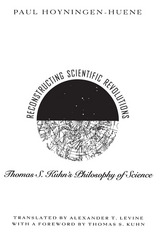 Reconstructing Scientific Revolutions: Thomas S. Kuhn's Philosophy of Science
Paul Hoyningen-Huene
University of Chicago Press, 1993 Few philosophers of science have influenced as many readers as Thomas S. Kuhn. Yet no comprehensive study of his ideas has existed—until now. In this volume, Paul Hoyningen-Huene examines Kuhn's work over four decades, from the days before The Structure of Scientific Revolutions to the present, and puts Kuhn's philosophical development in a historical framework.
Scholars from disciplines as diverse as political science and art history have offered widely differing interpretations of Kuhn's ideas, appropriating his notions of paradigm shifts and revolutions to fit their own theories, however imperfectly. Hoyningen-Huene does not merely offer another interpretation—he brings Kuhn's work into focus with rigorous philosophical analysis. Through extended discussions with Kuhn and an encyclopedic reading of his work, Hoyningen-Huene looks at the problems and justifications of his claims and determines how his theories might be expanded. Most significantly, he discovers that The Structure of Scientific Revolutions can be understood only with reference to the historiographic foundation of Kuhn's philosophy.
Discussing the concepts of paradigms, paradigm shifts, normal science, and scientific revolutions, Hoyningen-Huene traces their evolution to Kuhn's experience as a historian of contemporary science. From here, Hoyningen-Huene examines Kuhn's well-known thesis that scientists on opposite sides of a revolutionary divide "work in different worlds," explaining Kuhn's notion of a world-change during a scientific revolution. He even considers Kuhn's most controversial claims—his attack on the distinction between the contexts of discovery and justification and his notion of incommensurability—addressing both criticisms and defenses of these ideas.
Destined to become the authoritative philosophical study of Kuhn's work, Reconstructing Scientific Revolutions both enriches our understanding of Kuhn and provides powerful interpretive tools for bridging Continental and Anglo-American philosophical traditions.
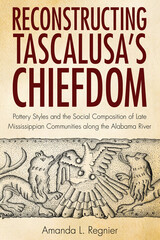 Reconstructing Tascalusa's Chiefdom: Pottery Styles and the Social Composition of Late Mississippian Communities along the Alabama River
Amanda L. Regnier
University of Alabama Press, 2014 Reconstructing Tascalusa’s Chiefdom is an archaeological study of political collapse in the Alabama River Valley following the Hernando de Soto expedition. To explain the cultural and political disruptions caused by Hernando de Soto's exploration deep into north America, Amanda L. Regnier presents an innovative analysis of ceramics and theory of cultural exchange. She argues that culture consists of a series of interconnected models governing proper behavior that are shared across the belief systems of communities and individuals. Historic cognitive models derived from ceramic data via cluster and correspondence analysis can effectively be used to examine these models and explain cultural exchange. The results of Regnier's work demonstrate that the Alabama River Valley was settled by populations migrating from three different regions during the late fifteenth century. The mixture of ceramic models associated with these traditions at Late Mississippian sites suggests that these newly founded towns, controlled by Tascalusa, comprised ethnically and linguistically diverse populations. Perhaps most significantly, Tascalusa's chiefdom appears to be a precontact example of a coalescent society that emerged after populations migrated from the deteriorating Mississippian chiefdoms into a new region. A summary of excavations at Late Mississippian sites also includes the first published chronology of the Alabama River from approximately AD 900 to 1600.
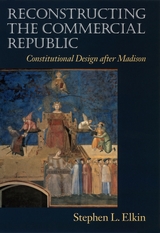 Reconstructing the Commercial Republic: Constitutional Design after Madison
Stephen L. Elkin
University of Chicago Press, 2006 James Madison is the thinker most responsible for laying the groundwork of the American commercial republic. But he did not anticipate that the propertied class on which he relied would become extraordinarily politically powerful at the same time as its interests narrowed. This and other flaws, argues Stephen L. Elkin, have undermined the delicately balanced system he constructed. In Reconstructing the Commercial Republic, Elkin critiques the Madisonian system, revealing which of its aspects have withstood the test of time and which have not.
The deficiencies Elkin points out provide the starting point for his own constitutional theory of the republic—a theory that, unlike Madison’s, lays out a substantive conception of the public interest that emphasizes the power of institutions to shape our political, economic, and civic lives. Elkin argues that his theory should guide us toward building a commercial republic that is rooted in a politics of the public interest and the self-interest of the middle class. He then recommends specific reforms to create this kind of republic, asserting that Americans today can still have the lives a commercial republic is intended to promote: lives with real opportunities for economic prosperity, republican political self-government, and individual liberty.
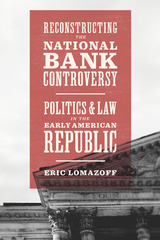 Reconstructing the National Bank Controversy: Politics and Law in the Early American Republic
Eric Lomazoff
University of Chicago Press, 2018 The Bank of the United States sparked several rounds of intense debate over the meaning of the Constitution’s Necessary and Proper Clause, which authorizes the federal government to make laws that are “necessary” for exercising its other powers. Our standard account of the national bank controversy, however, is incomplete. The controversy was much more dynamic than a two-sided debate over a single constitutional provision and was shaped as much by politics as by law.
With Reconstructing the National Bank Controversy, Eric Lomazoff offers a far more robust account of the constitutional politics of national banking between 1791 and 1832. During that time, three forces—changes within the Bank itself, growing tension over federal power within the Republican coalition, and the endurance of monetary turmoil beyond the War of 1812 —drove the development of our first major debate over the scope of federal power at least as much as the formal dimensions of the Constitution or the absence of a shared legal definition for the word “necessary.” These three forces—sometimes alone, sometimes in combination—repeatedly reshaped the terms on which the Bank’s constitutionality was contested. Lomazoff documents how these three dimensions of the polity changed over time and traces the manner in which they periodically led federal officials to adjust their claims about the Bank’s constitutionality. This includes the emergence of the Coinage Clause—which gives Congress power to “coin money, regulate the value thereof”—as a novel justification for the institution. He concludes the book by explaining why a more robust account of the national bank controversy can help us understand the constitutional basis for modern American monetary politics.
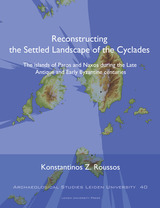 Reconstructing the Settled Landscape of the Cyclades: The Islands of Paros and Naxos During the Late Antique and Early Byzantine Centuries
Konstantinos Z. Roussos
Leiden University Press, 2018
The aim of this book is to offer a fresh approach to the history and archaeology of the Cyclades in Late Antiquity and the Byzantine Early Middle Ages in light of current archaeological investigations. It is an attempt to interpret human-environmental interaction in order to read the relationship between islands, settlements, landscapes, and seascapes in the context of the diverse and highly interactive Mediterranean world.
It offers an interdisciplinary approach, which combines archaeological evidence, literary sources, and observations of the sites and microlandscapes as a whole, using the advantages offered by the application of new technologies in archaeological research (Geographic Information Systems). The islands of Paros and Naxos are used as case-studies. The author traces how these neighboring insular communities reacted under the same general circumstances pertaining in the Aegean and to what extent the landscape played a role in this process.
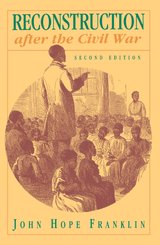 Reconstruction after the Civil War: Second Edition
John Hope Franklin
University of Chicago Press, 1994 Ever since its original publication in 1961, Reconstruction after the Civil War has been praised for cutting through the controversial scholarship and popular myths of the time to provide an accurate account of the role of former slaves during this period in American history.
Now Franklin has updated his work to acknowledge the enormous body of research and scholarship that followed in the wake of the first edition. New are Franklin’s references to important, later texts that enrich the original narrative. In addition, the extensive bibliography has been thoroughly revised.
What has not changed, however, is the foundation Franklin has laid. Still compelling are his arguments concerning the brevity of the North’s military occupation of the South, the limited amount of power wielded by former slaves, the influence of moderate southerners, the flaws of the constitutions drawn up by the Radical state governments, and the reasons for the downfall of Reconstruction.
Reconstruction after the Civil War, Third Edition
John Hope Franklin
University of Chicago Press, 2012 Reconstruction after the Civil War explores the role of former slaves during this period in American history. Looking past popular myths and controversial scholarship, John Hope Franklin uses his astute insight and careful research to provide an accurate, comprehensive portrait of the era. His arguments concerning the brevity of the North’s occupation, the limited power wielded by former slaves, the influence of moderate southerners, the flawed constitutions of the radical state governments, and the downfall of Reconstruction remain compelling today. This new edition of Reconstruction after the Civil War also includes a foreword by Eric Foner and a perceptive essay by Michael W. Fitzgerald.
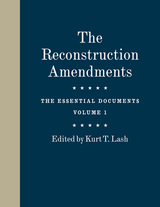 The Reconstruction Amendments: The Essential Documents, Volume 1
Edited by Kurt T. Lash
University of Chicago Press, 2021 Ratified in the years immediately following the American Civil War, the Thirteenth, Fourteenth, and Fifteenth Amendments to the U.S. Constitution—together known as the Reconstruction Amendments—abolished slavery, safeguarded a set of basic national liberties, and expanded the right to vote, respectively. This two-volume work presents the key speeches, debates, and public dialogues that surrounded the adoption of the three amendments, allowing us to more fully experience how they reshaped the nature of American life and freedom.
Volume I outlines a broad historical context for the Reconstruction Amendments and contains materials related to the Thirteenth Amendment, which abolished slavery, while Volume 2 covers the Fourteenth and Fifteenth Amendments on the rights of citizenship and enfranchisement. The documents in this collection encompass a sweeping range of primary sources, from congressional debates to court cases, public speeches to newspaper articles. As a whole, the volumes meticulously depict a significant period of legal change even as they illuminate the ways in which people across the land grappled with the process of constitutional reconstruction. Filling a major gap in the literature on the era, The Reconstruction Amendments will be indispensable for readers in politics, history, and law, as well as anyone seeking a better understanding of the post–Civil War basis of American constitutional democracy.
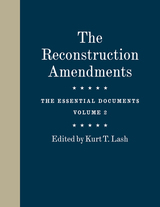 The Reconstruction Amendments: The Essential Documents, Volume 2
Edited by Kurt T. Lash
University of Chicago Press, 2021 Ratified in the years immediately following the American Civil War, the Thirteenth, Fourteenth, and Fifteenth Amendments to the United States Constitution—together known as the Reconstruction Amendments—abolished slavery, safeguarded a set of basic national liberties, and expanded the right to vote, respectively. This two-volume work presents the key speeches, debates, and public dialogues that surrounded the adoption of the three amendments, allowing us to more fully experience how they reshaped the nature of American life and freedom.
Volume I outlines a broad historical context for the Reconstruction Amendments along with materials related to the Thirteenth Amendment, which abolished slavery, while Volume II covers the Fourteenth and Fifteenth Amendments on the rights of citizenship and enfranchisement. The documents in this collection encompass a sweeping range of primary sources, from congressional talks to court cases, public speeches to newspaper articles. As a whole, the volumes meticulously depict a significant period of legal change even as they illuminate the ways in which people across the land grappled with the process of constitutional reconstruction. Filling a major gap in the literature on the era, The Reconstruction Amendments will be indispensable for readers in politics, history, and law, as well as anyone seeking a better understanding of the post–Civil War basis of American constitutional democracy.
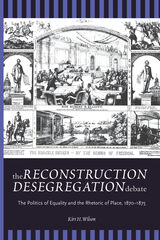 The Reconstruction Desegregation Debate: The Policies of Equality and the Rhetoric of Place, 1870-1875
Kirt H. Wilson
Michigan State University Press, 2002 In the decade that followed the Civil War, two questions dominated political debate: To what degree were African Americans now “equal” to white Americans, and how should this equality be implemented in law? Although Republicans entertained multiple, even contradictory, answers to these questions, the party committed itself to several civil rights initiatives. When Congress passed the Thirteenth Amendment, the 1866 Civil Rights Act, the Fourteenth Amendment, and the Fifteenth Amendment, it justified these decisions with a broad egalitarian rhetoric. This rhetoric altered congressional culture, instituting new norms that made equality not merely an ideal,but rather a pragmatic aim for political judgments.
Kirt Wilson examines Reconstruction’s desegregation debate to explain how it represented an important movement in the evolution of U.S. race relations. He outlines how Congress fought to control the scope of black civil rights by contesting the definition of black equality, and the expediency and constitutionality of desegregation. Wilson explores how the debate over desegregation altered public memory about slavery and the Civil War, while simultaneously shaping a political culture that established the trajectory of race relations into the next century.
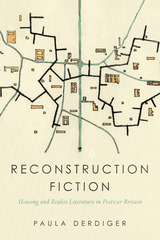 Reconstruction Fiction: Housing and Realist Literature in Postwar Britain
Paula Derdiger
Ohio State University Press, 2020 Reconstruction Fiction: Housing and Realist Literature in Postwar Britain by Paula Derdiger assesses the impact of World War II and the welfare state on literary fiction by focusing on one of the defining issues of the postwar period: housing. Through compelling close readings and lively historical and cultural analysis, Derdiger argues that literary realism was a necessary, generative response to the war and welfare state since they impacted the built environment and landscape. Wartime decimation of buildings and streets called for reconstruction, and reconstruction called not just for bricks and mortar, architectural drawings, town plans, preservation schemes, and new policies but also for fiction that invited particular ways of inhabiting an environment that had been irrevocably changed. Derdiger argues that fiction, like actual buildings, creates a sheltered space for the mediation between individual subjects and the social and geographical environments that they encounter. Realist fiction, specifically, insists that such mediation is possible and that it is socially valuable. Covering writers spanning various social positions and aesthetic tendencies—including Elizabeth Bowen, Graham Greene, Patrick Hamilton, Doris Lessing, Colin MacInnes, and Elizabeth Taylor—Derdiger shows how these authors responded to the war with realistic technique, investing in external conditions just as much as or more than their characters’ i nterior lives. In doing so, their reconstruction fiction helped to shape postwar life.
Reconstruction in Texas
By Charles William Ramsdell
University of Texas Press, 1970 A reprint of the 1910 study, Reconstruction in Texas examines the events that still impact upon Texas and the South.
 The Reconstruction of Georgia
Alan Conway
University of Minnesota Press, 1966
The Reconstruction of Georgia was first published in 1966. Minnesota Archive Editions uses digital technology to make long-unavailable books once again accessible, and are published unaltered from the original University of Minnesota Press editions.
In this study of the reconstruction period in Georgia following the Civil War, a British historian provides a dispassionate account of a highly controversial subject. A revisionist reappraisal, Dr. Conway's study is the first substantial history of the period to be published in fifty years. The sources include considerable material that has become available since the publication of the last major work on the subject in 1915.
The author gives close attention to the last days of the Civil War and its aftermath in Georgia, the early attempts at political reconstruction in 1865, the work of the Freedmen's Bureau, the economic problems involved in reshaping the state's economy, the development of the state-cropping and crop-lien systems, the imposition of Congressional reconstruction on Georgia under military supervision, the political maneuverings and economic ventures of such prominent figures as Joseph E. Brown, Benjamin Hill, and Hannibal I. Kimball, the efforts of the Ku-Klux Klan to nullify Negro voting rights and re-establish "white supremacy" concepts, and, finally, the investigations by the Democratic party of Republication misgovernment during the administration of Governor Rufus B. Bullock.
Dr. Conway, who did the research for the book in Georgia, has made considerable use of primary manuscripts, travelers' accounts, state and federal reports, and contemporary newspaper material to arrive at an account which judiciously assesses the claims and counter-claims of violently opposed groups which were vitally concerned with the place of the Negro in Southern society after emancipation and with the return of Georgia to the Union.
 The Reconstruction of Patriotism: Education for Civic Consciousness
Morris Janowitz
University of Chicago Press, 1984 "A meticulous, well-tuned examination of what Janowitz says is the decline of civic thought in America, and what might be done to restore it. . . . The patriotism Janowitz proposes to reconstruct is not the sort of narrow nationalism your political science professor may have warned you about—patriotism as 'the last refuge of a scoundrel.' It is instead a patriotism that intelligently appreciates life in a (however imperfect) democratic land."—Robert Marquand, The Christian Science Monitor
"In The Reconstruction of Patriotism, Morris Janowitz . . . places a national-service program on the national agenda. . . . Like William James, Janowitz envisions government enrolling young people to work for a year or two at subsistence pay, doing jobs that benefit society—working with, say, 'conservation, health, or old-age problems.' He believes that we need a service program because since the end of the Second World War our citizens (and, indeed, citizens of almost all the advanced industrial nations) have become more keenly aware of their rights than of their obligations, and generations are growing up with little or no understanding that they are members of a national community and have responsibilities to it—that they must give as well as take. . . . Because it reopens discussion of our wider obligations and how to fulfill them, Mr. Janowitz's thoughtful book is in itself a national service."—Naomi Bliven, The New Yorker
"Morris Janowitz examines an issue that seldom is subject to social and political analysis—patriotism. His thesis is clear: The long-term trend in politics has been to enhance citizen rights without effective articulation of citizen obligations. A meaningful balance between the two, he contends, must be restored. . . . The strength of this study lies in Janowitz's persuasive argument that the durability and vitality of democratic institutions require that a sense of community, or shared values, be preserved. Without civiz consciousness, he rightly observes, social and political fragmentation ensues. . . . A lucid and impressively researched polemic."—W. Wesley McDonald, American Political Science Review
"Janowitz addresses a seminal issue: how to restore the sense of shared civic responsibility that has fallen victim in recent years to our growing preoccupation with individual rights and the rise of special-interest groups. . . . Central to his prescription is the revival of the concept of the citizen soldier, whose importance since pre-Revolutionary War days Janoqitz discusses at length. He concludes, 'There can be no reconstruction of patriotism without a system of national service.' . . . An important book. I highly recommend it."—Washington Monthly
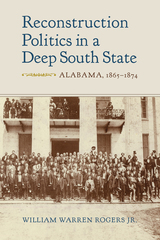 Reconstruction Politics in a Deep South State: Alabama, 1865–1874
William Warren Rogers Jr.
University of Alabama Press, 2021 Recounts in detail the volatile political period in Alabama following the end of the Civil War
Following the end of the Civil War, white Southerners were forced to concede equal rights to those who had been enslaved, ushering in a new and ruthless brand of politics. Suddenly, the status and place of some four million former slaves dominated the national and regional political dialogue. In Alabama, the Republican Party established itself quickly and powerfully with the participation of a newly freed constituency, firmly aligned against the Democratic Party that had long dictated the governance of the state. Well-heeled planters, merchants, and bankers, joined by yeoman farmers, staged a counterrevolution by gravitating strongly to the Democratic Party and its unabashedly white supremacist measures. The ensuing power struggle in the birthplace of the Confederacy is at the heart of Reconstruction Politics in a Deep South State: Alabama, 1865–1874.
What emerges in William Warren Rogers Jr.’s comprehensive study of the era is a detailed examination of Reconstruction politics, particularly in Alabama. This book explores an explosive and unpredictable political environment that a few years earlier would have been inconceivable. A vivid picture emerges of courthouse rallies and bitter infighting in legislative circles. Rogers’s narrative ventures into darker places as well: to the Tennessee Valley and the Black Belt regions of Alabama, where Klan nightriders used violence against an enemy and ideology they could not abide.
The attempt to capture and account for the unforgiving political landscape created by the extraordinary circumstances of Reconstruction constitutes this study’s most central contribution. Rogers often quotes black and white citizens, Democrats and Republicans. Drawn from newspapers, correspondence, and various federal investigations, these firsthand voices are passionate, unvarnished, and filled with conviction. They offer a startling immediacy and illustrate the temper—or distemper—of the times. Readers are treated to a panoramic unveiling of Reconstruction Alabama politics that provides a sense of what was truly at stake: the values by which a region and the nation as a whole would chart its future for the century to come.
.
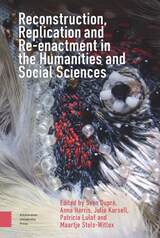 Reconstruction, Replication and Re-enactment in the Humanities and Social Sciences
Sven Dupré
Amsterdam University Press, 2021 Performative methods are playing an increasingly prominent role in research into historical production processes, materials, bodily knowledge and sensory skills, and in forms of education and public engagement in classrooms and museums. This book offers, for the first time, sustained, interdisciplinary reflections on performative methods, variously known as Reconstruction, Replication and Re-enactment (RRR) practices across the fields of history of science, archaeology, art history, conservation, musicology and anthropology. Each of these fields has distinct histories, approaches, tools and research questions. Researchers in the historical disciplines have used reconstructions to learn about the materials and practices of the past, while anthropologists and ethnographers have more often studied the re-enactments themselves, participating in these performances as engaged observers. In this book, authors bring their experiences of RRR practices within their discipline into conversation with RRR practices in other disciplines, providing a basis for interdisciplinary cross-fertilization.
Recontextualizing Medieval Heritage and Identity in Contemporary Austria
Alexandra Sterling-Hellenbrand
Arc Humanities Press, 2024
This book explores ways in which the medieval narrative past has been re-imagined in contemporary Austria. Focusing on the Styrian Literature Pathways of the Middle Ages, the Nibelung monuments in the cities of Tulln and Pöchlarn on the Danube River, and the Siegfriedskopf at the University of Vienna, it argues that each installation constructively applies medievalism to the process of working through the twentieth-century past. Sterling-Hellenbrand uncovers how medieval texts have been re-created in the Austrian landscape and how public installations make visible the values of the communities that build them. The author demonstrates how these modern installations facilitate an innovative process of engaged remembering: they prompt us to initiate challenging conversations about the past to tell different stories for the future.
Recontextualizing Texts: Narrative Performance in Modern Japanese Fiction
Atsuko Sakaki
Harvard University Press, 1999 Offering the first systematic examination of five modern Japanese fictional narratives, all of them available in English translations, Atsuko Sakaki explores Natsume Sōseki’s Kokoro and Kusamakura (The Three-Cornered World); Ibuse Masuji’s Kuroi ame (Black Rain); Mori Ōgai’s Gan (Wild Geese); and Tanizaki Jun’ichirō’s Manji (Quicksand). Her close reading of each text reveals a hitherto unexplored area of communication between narrator and audience, as well as between “implied author” and “implied reader.” By using this approach, the author situates each of these works not in its historical, cultural, or economic contexts but in the situation the text itself produces.
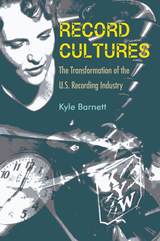 Record Cultures: The Transformation of the U.S. Recording Industry
Kyle Barnett
University of Michigan Press, 2020 Record Cultures tells the story of how early U.S. commercial recording companies captured American musical culture in a key period in both music and media history. Amid dramatic technological and cultural changes of the 1920s and 1930s, small recording companies in the United States began to explore the genres that would later be known as jazz, blues, and country. Smaller record labels, many based in rural or out of the way Midwestern and Southern towns, were willing to take risks on the country’s regional vernacular music as a way to compete with more established recording labels. Recording companies’ relationship with radio grew closer as both industries were on the rise, propelled by new technologies. Radio, which had become immensely popular, began broadcasting more recorded music in place of live performances, and this created profitable symbiosis. With the advent of the talkies, the film industry completed the media trifecta. The novelty of recorded sound was replacing film accompanists, and the popularity of movie musicals solidified film’s connections with the radio and recording industries. By the early 1930s, the recording industry had gone from being part of the largely autonomous phonograph industry to being major media industry of its own, albeit deeply tied to—and, in some cases, owned by—the radio and film industries. The triangular relationships between these media industries marked the first major entertainment and media conglomerates in U.S. history.
Through an interdisciplinary and intermedial approach to recording industry history, Record Cultures creates new connections between different strands of media research. It will be of interest to scholars of popular music, media studies, sound studies, American culture, and the history of film, television, and radio.
Record Makers and Breakers: Voices of the Independent Rock 'n' Roll Pioneers
John Broven
University of Illinois Press, 2009 This volume is an engaging and exceptional history of the independent rock 'n' roll record industry from its raw regional beginnings in the 1940s with R & B and hillbilly music through its peak in the 1950s and decline in the 1960s. John Broven combines narrative history with extensive oral history material from numerous recording pioneers including Joe Bihari of Modern Records; Marshall Chess of Chess Records; Jerry Wexler, Ahmet Ertegun, and Miriam Bienstock of Atlantic Records; Sam Phillips of Sun Records; Art Rupe of Specialty Records; and many more.
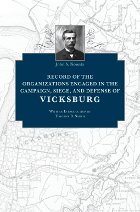 Record of the Organizations Engaged in the Campaign, Siege, and Defense of Vicksburg
John S. Kountz
University of Tennessee Press, 2011
Large numbers of Civil War veterans remembered and reminisced about their war experiences, but only a relative few dedicated the rest of their lives to the task of commemorating their long-ago deeds. John S. Kountz was one of this latter group. Kountz joined the Thirty-seventh Ohio Infantry in September 1861 as a fifteen-year-old drummer boy and later, under General William T. Sherman, endured the long siege at Vicksburg before helping to win control of the city in July 1863. In 1899 the War Department appointed Kountz as the official historian at the newly designated Vicksburg National Military Park. As part of his duties, he produced two major works, an organizational chronicle of the armies that fought at Vicksburg and an unpublished narrative of the campaign and siege. This welcome volume presents both of these extremely rare documents together for the first time, providing a valuable resource for a new generation of scholars and enthusiasts.
Record of the Organizations Engaged in the Campaign, Siege, and Defense of Vicksburg was published in a limited edition by the Government Printing Office in 1901 and offered visitors and historians a detailed examination of the various commands that fought at Vicksburg. The record has long been an essential but hard-to-find source for historians. Kountz’s impressive 116-page campaign overview is rarer still. Because of turnover at the park and Kountz’s death in 1909, the manuscript never saw publication and has, until now, lain buried in the archives at Vicksburg. Offering an unbiased account of both sides of the battle, it delves into the minds of the commanders, examines their decision-making processes, and articulates several opinions that have sparked debate ever since.
With a new introduction by noted historian Timothy B. Smith, this significant work makes widely available an important history by a participant in the action and opens a fascinating window into the history of Civil War scholarship.
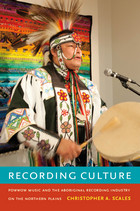 Recording Culture: Powwow Music and the Aboriginal Recording Industry on the Northern Plains
Christopher A. Scales
Duke University Press, 2012 Recording is central to the musical lives of contemporary powwow singers yet, until now, their aesthetic practices when recording have been virtually ignored in the study of Native American expressive cultures. Recording Culture is an exploration of the Aboriginal music industry and the powwow social world that supports it. For twelve years, Christopher A. Scales attended powwows—large intertribal gatherings of Native American singer-drummers, dancers, and spectators—across the northern Plains. For part of that time, he worked as a sound engineer for Arbor Records, a large Aboriginal music label based in Winnipeg, Canada. Drawing on his ethnographic research at powwow grounds and in recording studios, Scales examines the ways that powwow drum groups have utilized recording technology in the late twentieth and early twenty-first centuries, the unique aesthetic principles of recorded powwow music, and the relationships between drum groups and the Native music labels and recording studios. Turning to "competition powwows," popular weekend-long singing and dancing contests, Scales analyzes their role in shaping the repertoire and aesthetics of drum groups in and out of the recording studio. He argues that the rise of competition powwows has been critical to the development of the powwow recording industry. Recording Culture includes a CD featuring powwow music composed by Gabriel Desrosiers and performed by the Northern Wind Singers.
Recording Memories from Political Violence: A Film-maker's Journey
Cahal McLaughlin
Intellect Books, 2010 Based on work the author has carried out with survivor groups in Northern Ireland and South Africa, Recording Memories from Political Violence draws on written and audiovisual texts to describe and analyze the use of documentary filmmaking in recording experiences of political conflict. A variety of issues relevant to the genre are addressed at length, including the importance of ethics in the collaboration between the filmmaker and the participant and the effect of location on the accounts of participants. Cahal McLaughlin draws on the diverse fields of film and cultural studies, as well as nearly twenty years of production experience, in this informed and instructive contribution to documentary filmmaking and post-conflict studies.
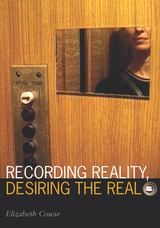 Recording Reality, Desiring the Real
Elizabeth Cowie
University of Minnesota Press, 2010 Documentary has once again emerged as one of the most vital cultural forms, whether seen in cinemas or inside the home, as digital, film, or video. In Recording Reality, Desiring the Real, Elizabeth Cowie looks at the history of documentary and its contemporary forms, showing how it has been simultaneously understood as factual, as story, as art, and as political, addressing the seeming paradox between the pleasures of spectacle in the documentary and its project of informing and educating.
Cowie claims that, as a radical film form, documentary has been a way for filmmakers to acknowledge historical and contemporary realities by presenting images of these realities. If documentary is the desire to know reality through its images and sounds, she asks, what kind of speaking (and speaking about) emerges in documentary, and how are we engaged by it? In considering this and other questions, Cowie examines a range of noteworthy films, including Spike Lee’s When the Levees Broke, John Huston’s Let There Be Light, and Milica Tomic’s Portrait of My Mother.
Recording Reality, Desiring the Real stakes documentary’s central place in cinema as both an art form and a form of social engagement, which together create a new understanding of spectatorship.
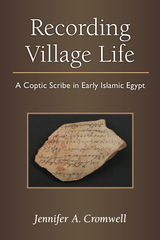 Recording Village Life: A Coptic Scribe in Early Islamic Egypt
Jennifer A. Cromwell
University of Michigan Press, 2017 Recording Village Life presents a close study of over 140 Coptic texts written between 724–756 CE by a single scribe, Aristophanes son of Johannes, of the village Djeme in western Thebes. These texts, which focus primarily on taxation and property concerns, yield a wealth of knowledge about social and economic changes happening at both the community and country-wide levels during the early years of Islamic rule in Egypt. Additionally, they offer a fascinating picture of the scribe’s role within this world, illuminating both the practical aspects of his work and the social and professional connections with clients for whom he wrote legal documents.
Papyrological analysis of Aristophanes’ documents, within the context of the textual record of the village, shows a new and divergent scribal practice that reflects broader trends among his contemporaries: Aristophanes was part of a larger, national system of administrative changes, enacted by the country’s Arab rulers in order to better control administrative practices and fiscal policies within the country. Yet Aristophanes’ dossier shows him not just as an administrator, revealing details about his life, his role in the community, and the elite networks within which he operated. This unique perspective provides new insights into both the micro-history of an individual’s experience of eighth-century Theban village life, and its reflection in the macro social, economic, and political trends in Egypt at this time.
This book will prove valuable to scholars of late antique studies, papyrology, philology, early Islamic history, social and economic history, and Egyptology.
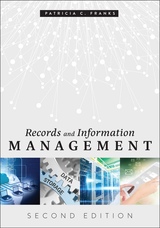 Records and Information Management
Patricia C. Franks
American Library Association, 2018 As Information Management put it, "On the strength of its currency and coverage alone, Franks' book is poised to take over as the recommended go-to reference for both students and RIM professionals for many years to come.” The new second edition cements this work’s status as an up-to-date classic, its content updated and expanded to address emerging technologies, most notably blockchain, and evolving standards and practices. Inside, Franks presents complete coverage of the records and information lifecycle model, encompassing paper, electronic (databases, office suites, email), and new media records (blogs, chat messages, and software as a service). Informed by an advisory board of experts in the field and with contributions by noted authorities, the text addresses such key topics as - the origins and development of records and information;
- the discipline of information governance and developing a strategic records management plan;
- creation/capture and classification;
- retention strategies, inactive records management, archives, and long-term preservation;
- access, storage, and retrieval;
- electronic records and electronic records management systems;
- the latest on rapidly evolving technologies such as web records, social media, and mobile devices;
- vital records, disaster preparedness and recovery, and business continuity;
- monitoring, auditing, and risk management; and
- education and training.
This book’s authoritative blend of theory and practice makes it a matchless resource for everyone in the archives and records management field. Instructor/trainer extras include a set of ready-to-go, customizable PowerPoint slides to accompany the text.
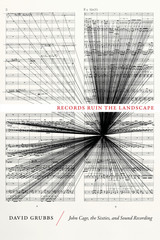 Records Ruin the Landscape: John Cage, the Sixties, and Sound Recording
David Grubbs
Duke University Press, 2014 John Cage's disdain for records was legendary. He repeatedly spoke of the ways in which recorded music was antithetical to his work. In Records Ruin the Landscape, David Grubbs argues that, following Cage, new genres in experimental and avant-garde music in the 1960s were particularly ill suited to be represented in the form of a recording. These activities include indeterminate music, long-duration minimalism, text scores, happenings, live electronic music, free jazz, and free improvisation. How could these proudly evanescent performance practices have been adequately represented on an LP?
In their day, few of these works circulated in recorded form. By contrast, contemporary listeners can encounter this music not only through a flood of LP and CD releases of archival recordings but also in even greater volume through Internet file sharing and online resources. Present-day listeners are coming to know that era's experimental music through the recorded artifacts of composers and musicians who largely disavowed recordings. In Records Ruin the Landscape, Grubbs surveys a musical landscape marked by altered listening practices.
Recovered Legacies: Authority And Identity In Early Asian Amer Lit
edited by Keith Lawrence and Floyd Cheung
Temple University Press, 2005 Recovered Legacies: Authority and Identity in Early Asian American Literature employs contemporary and traditional readings of representative works in prose, poetry, and drama to suggest new ways of understanding and appreciating the critically fertile but underexamined body of Asian American writing from the late 1800s to the early 1960s. The essays in this volume engage this corpus—composed of multiple genres from different periods and by authors of different ethnicities—with a strong awareness of historical context and a keen sensitivity to literary form. As a collection, Recovered Legacies re-establishes the rich and diverse literary heritage of Asian America and argues persuasively for the significance of these works to the American literary canon.
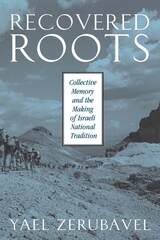 Recovered Roots: Collective Memory and the Making of Israeli National Tradition
Yael Zerubavel
University of Chicago Press, 1995 Because new nations need new pasts, they create new ways of commemorating and recasting select historic events. In Recovered Roots, Yael Zerubavel illuminates this dynamic process by examining the construction of Israeli national tradition.
In the years leading to the birth of Israel, Zerubavel shows, Zionist settlers in Palestine consciously sought to rewrite Jewish history by reshaping Jewish memory. Zerubavel focuses on the nationalist reinterpretation of the defense of Masada against the Romans in 73 C.E. and the Bar Kokhba revolt of 133-135; and on the transformation of the 1920 defense of a new Jewish settlement in Tel Hai into a national myth. Zerubavel demonstrates how, in each case, Israeli memory transforms events that ended in death and defeat into heroic myths and symbols of national revival.
Drawing on a broad range of official and popular sources and original interviews, Zerubavel shows that the construction of a new national tradition is not necessarily the product of government policy but a creative collaboration between politicans, writers, and educators. Her discussion of the politics of commemoration demonstrates how rival groups can turn the past into an arena of conflict as they posit competing interpretations of history and opposing moral claims on the use of the past. Zerubavel analyzes the emergence of counter-memories within the reality of Israel's frequent wars, the ensuing debates about the future of the occupied territories, and the embattled relations with Palestinians.
A fascinating examination of the interplay between history and memory, this book will appeal to historians, sociologists, anthropologists, political scientists, and folklorists, as well as to scholars of cultural studies, literature, and communication.
 Recovering Bodies: Illness, Disability, and Life Writing
G. Thomas Couser
University of Wisconsin Press, 1997 This is a provocative look at writing by and about people with illness or disability—in particular HIV/AIDS, breast cancer, deafness, and paralysis—who challenge the stigmas attached to their conditions by telling their lives in their own ways and on their own terms. Discussing memoirs, diaries, collaborative narratives, photo documentaries, essays, and other forms of life writing, G. Thomas Couser shows that these books are not primarily records of medical conditions; they are a means for individuals to recover their bodies (or those of loved ones) from marginalization and impersonal medical discourse.
Responding to the recent growth of illness and disability narratives in the United States—such works as Juliet Wittman’s Breast Cancer Journal, John Hockenberry’s Moving Violations, Paul Monette’s Borrowed Time: An AIDS Memoir, and Lou Ann Walker’s A Loss for Words: The Story of Deafness in a Family—Couser addresses questions of both poetics and politics. He examines why and under what circumstances individuals choose to write about illness or disability; what role plot plays in such narratives; how and whether closure is achieved; who assumes the prerogative of narration; which conditions are most often represented; and which literary conventions lend themselves to representing particular conditions. By tracing the development of new subgenres of personal narrative in our time, this book explores how explicit consideration of illness and disability has enriched the repertoire of life writing. In addition, Couser’s discussion of medical discourse joins the current debate about whether the biomedical model is entirely conducive to humane care for ill and disabled people.
With its sympathetic critique of the testimony of those most affected by these conditions, Recovering Bodies contributes to an understanding of the relations among bodily dysfunction, cultural conventions, and identity in contemporary America.
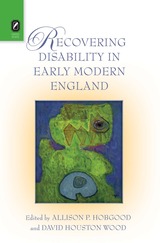 Recovering Disability in Early Modern England
Edited by Allison P. Hobgood and David Houston Wood
Ohio State University Press, 2013 While early modern selfhood has been explored during the last two decades via a series of historical identity studies involving class, race and ethnicity, and gender and sexuality, until very recently there has been little engagement with disability and disabled selves in sixteenth- and seventeenth-century England. This omission is especially problematic insofar as representations of disabled bodies and minds serve as some of the signature features in English Renaissance texts. Recovering Disability in Early Modern England explores how recent conversations about difference in the period have either overlooked or misidentified disability representations. It also presents early modern disability studies as a new theoretical lens that can reanimate scholarly dialogue about human variation and early modern subjectivities even as it motivates more politically invested classroom pedagogies. The ten essays in this collection range across genre, scope, and time, including examinations of real-life court dwarfs and dwarf narrators in Edmund Spenser’s poetry; disability in Aphra Behn’s assessment of gender and femininity; disability humor, Renaissance jest books, and cultural ideas about difference; madness in revenge tragedies; Spenserian allegory and impairment; the materiality of literary blindness; feigned disability in Jonsonian drama; political appropriation of Richard III in the postcommunist Czech Republic; the Book of Common Prayeras textual accommodation for cognitive disability; and Thomas Hobbes’s and John Locke’s inherently ableist conceptions of freedom and political citizenship.
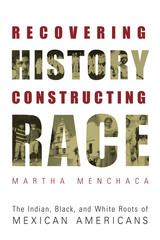 Recovering History, Constructing Race: The Indian, Black, and White Roots of Mexican Americans
By Martha Menchaca
University of Texas Press, 2002 A CHOICE Outstanding Academic Book, 2002 The history of Mexican Americans is a history of the intermingling of races—Indian, White, and Black. This racial history underlies a legacy of racial discrimination against Mexican Americans and their Mexican ancestors that stretches from the Spanish conquest to current battles over ending affirmative action and other assistance programs for ethnic minorities. Asserting the centrality of race in Mexican American history, Martha Menchaca here offers the first interpretive racial history of Mexican Americans, focusing on racial foundations and race relations from prehispanic times to the present. Menchaca uses the concept of racialization to describe the process through which Spanish, Mexican, and U.S. authorities constructed racial status hierarchies that marginalized Mexicans of color and restricted their rights of land ownership. She traces this process from the Spanish colonial period and the introduction of slavery through racial laws affecting Mexican Americans into the late twentieth-century. This re-viewing of familiar history through the lens of race recovers Blacks as important historical actors, links Indians and the mission system in the Southwest to the Mexican American present, and reveals the legal and illegal means by which Mexican Americans lost their land grants.
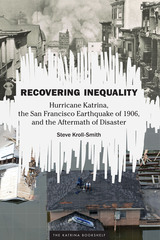 Recovering Inequality: Hurricane Katrina, the San Francisco Earthquake of 1906, and the Aftermath of Disaster
By Steve Kroll-Smith
University of Texas Press, 2018 A lethal mix of natural disaster, dangerously flawed construction, and reckless human actions devastated San Francisco in 1906 and New Orleans in 2005. Eighty percent of the built environments of both cities were destroyed in the catastrophes, and the poor, the elderly, and the medically infirm were disproportionately among the thousands who perished. These striking similarities in the impacts of cataclysms separated by a century impelled Steve Kroll-Smith to look for commonalities in how the cities recovered from disaster. In Recovering Inequality, he builds a convincing case that disaster recovery and the reestablishment of social and economic inequality are inseparable. Kroll-Smith demonstrates that disaster and recovery in New Orleans and San Francisco followed a similar pattern. In the immediate aftermath of the flooding and the firestorm, social boundaries were disordered and the communities came together in expressions of unity and support. But these were quickly replaced by other narratives and actions, including the depiction of the poor as looters, uneven access to disaster assistance, and successful efforts by the powerful to take valuable urban real estate from vulnerable people. Kroll-Smith concludes that inexorable market forces ensured that recovery efforts in both cities would reestablish the patterns of inequality that existed before the catastrophes. The major difference he finds between the cities is that, from a market standpoint, New Orleans was expendable, while San Francisco rose from the ashes because it was a hub of commerce.
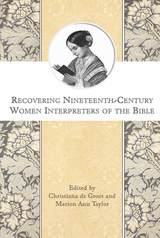 Recovering Nineteenth-Century Women Interpreters of the Bible
Christiana de Groot
SBL Press, 2007 Women have been thoughtful readers and interpreters of scripture throughout the ages, yet the usual history of biblical interpretation includes few women’s voices. To introduce readers to this untapped source for the history of biblical interpretation, this volume presents forgotten works from the nineteenth century written by women—including Grace Aguilar, Florence Nightingale, and Harriet Beecher Stowe, among others—from various faith backgrounds, countries, and social classes engaging contemporary biblical scholarship. Due to their exclusion from the academy, women’s interpretive writings addressed primarily a nonscholarly audience and were written in a variety of genres: novels and poetry, catechisms, manuals for Bible study, and commentaries on the books of the Bible. To recover these nineteenth-century women interpreters of the Bible, each essay in this volume locates a female author in her historical, ecclesiastical, and interpretive context, focusing on particular biblical passages to clarify an author’s contributions as well as to explore how her reading of the text was shaped by her experience as a woman.
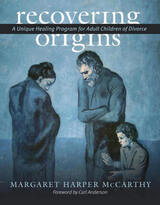 Recovering Origins: A Unique Healing Program for Adult Children of Divorce
Margaret Harper McCarthy
Catholic University of America Press, 2021 Recovering Origins is a healing program offered to adult children of divorced parents who now, with a certain distance from the practical difficulties that burden younger children, wrestle with the core problem at the heart of those difficulties. Having lost the community that brought them into the world, they have suffered a “primal loss.” Children are the literal embodiment of that community. When it is voluntarily dismantled, and worse–wished never to have been–the effect is not negligible. Children of divorce, by their own description, are now “pulled apart” as if “between two worlds.” They are “torn asunder.”
Paradoxically the idea for Recovering Origins was occasioned by this straight talk about divorce. For, by going to the depths of the loss of one’s primal community one can be opened up to the Community that stands at the root of it. “Deep calls unto deep,” as the Psalmist says. In short, Recovering Origins invites participants to move through the broken image of love that they see in their parents, to the loving Origin which is more fundamental than any human reflection of it, broken or not.
Recovering Origins begins with an invitation to look honestly at the actual experience of divorce, beyond all the “happy talk” about the “good divorce.” Participants are then invited to follow the path of the Lord’s Prayer, to recover what is at once challenging and precious to those whose very identities are on uncertain ground: the memory of God the Father, the goodness of their lives, and the real possibility of a good future. In this way, the program offers adult children of divorce a path to healing in the deepest sense.
Recovering Origins offers an occasion to encounter the Christian Faith more deeply, especially where it bears on fundamental question faced by children of divorce in a particularly dramatic way. Recovering Origins addresses adult children of divorce, then, not only as individuals in need of pastoral care, but as potential witnesses to something they can, perhaps, see more clearly: the goodness and fidelity of the One on whom their lives ultimately depend and the possibility (and need) that that be reflected in an irrevocable and fruitful love between the creatures made in his image.
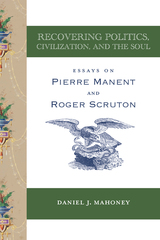 Recovering Politics, Civilization, and the Soul: Essays on Pierre Manent and Roger Scruton
Daniel J. Mahoney
St. Augustine's Press, 2022 The Western inheritance is under sustained theoretical and practical assault. Legitimate self-criticism has given way to nihilistic self-loathing and cultural, moral, and political repudiation is the order of the day. Yet, as Daniel J. Mahoney shows in this learned, eloquent, and provocative set of essays, two contemporary philosophic thinkers, Roger Scruton and Pierre Manent, have––separately and together––traced a path for the renewal of politics and practical reason, our civilized inheritance, the natural moral law, and the soul as the enduring site of self-conscious reflection, moral and civic agency, and mutual accountability.
Both Scruton and Manent have repudiated the fashionable nihilism associated with the “thought of 1968” and the “Parisian nonsense machine,” and have shown that gratitude is the proper response of the human person to the “givenness of things.” Both defend the self-governing nation against reckless nationalism and the even more reckless temptation of supranational governance and post-political democracy, what Manent suggestively calls a “kratos” without a “demos.” Both defend the secular state while taking aim at a radical secularism that rejects “the Christian mark” that is at the heart of our inheritance and that sustains the rich and necessary interpenetration of truth and liberty. Scruton’s more “cultural” perspective is indebted to Burke and Kant; Manent’s more political perspective draws on Aristotle, St. Thomas, Tocqueville, and Raymond Aron, among others. By highlighting their affinities, and reflecting on their instructive differences, Mahoney shows how, together, the English man of letters Scruton, and the French political philosopher Manent, guide us to the recovery of a horizon of thought and action animated by practical reason and the wellsprings of the human soul. They show us the humanizing path forward, but first we must make the necessary spiritual decision to repudiate repudiation once and for all.
“With sophisticated and profound scholarship, Daniel Mahoney deploys his elegant style to defend the soul of civilization. Through the writings of Pierre Manent and Roger Scruton, he charts a course through the political and philosophical turmoil of the present age, providing hope and light amid the prevailing darkness.”
— Mark Dooley, Irish philosopher, writer and journalist. Author of Conversations with Roger Scruton and Sir Roger's literary executor.
“Mahoney's collection of essays does a marvelous job of contextualizing and explaining the vital work of these two philosophers. He's also an engaging and elegant writer.”
— Daniel DiSalvo, City Journal
“A series of reflective essays by Mahoney on the philosophical, theological, and political thinking of our best conservative theorists: Pierre Manent and the late Roger
Scruton. Recovering Politics, Civilization, and the Soul expresses well what we need.” — Richard M. Reinsch II, National Review
Recovering Self-Evident Truths: Catholic Perspectives on American Law
Michael A. Scaperlanda
Catholic University of America Press, 2007 This book presents an engaging collection of essays exploring "catholic" and "Catholic" perspectives on American law--catholic in their claims of universal truths, and Catholic in their grounding in the teachings of the Roman Catholic Church
 Recovering Solidarity: Lessons from Poland's Unfinished Revolution
Gerald J. Beyer
University of Notre Dame Press, 2010
In Recovering Solidarity, Gerald J. Beyer provides a contextualized theological and ethical treatment of the idea of solidarity. He focuses particularly on the Polish Solidarity movement of the 1980s and the ways in which that movement originally embodied but, during the country's transformation to a capitalist democratic society, soon abandoned this important aspect of the Catholic social tradition. Using Poland as a case study, Beyer explores the obstacles to promoting an ethic of solidarity in contemporary capitalist societies and attempts to demonstrate how the moral revolution of the early Solidarity movement can be revived, both in its country of origin and around the world. Recovering Solidarity is widely interdisciplinary, utilizing Catholic social tradition, philosophical ethics, developmental economics, poverty research, gender studies, and sociology. It will appeal to those interested in the problems of poverty and justice.
"Recovering Solidarity raises an eloquent, much needed challenge for all nations today, both developed and developing. Beyer paints a poignant picture of how the inspiring movement that brought freedom to Poland died at the hands of supporters of unlimited market freedom. Solidarity and participation remain essential ethical supports for true freedom, and will be indispensable to addressing the new poverty in Poland today. Required reading for all concerned with the role of the market throughout the post-1989 world." --David Hollenbach, S.J., Boston College
"Recovering Solidarityuses a multidisciplinary approach to probe Poland's resistance movement for a deeper understanding of the potential of solidarity in modern society. This book shines a light on the contradictions of the phenomenon--both in our understanding of what it means to act 'in solidarity' and in the development of Poland's social movement. Beyer's sophisticated and subtle treatment of the dimensions of poverty in contemporary Poland helps the reader understand its broader implications." -- Maryjane Osa, Northwestern University
"This volume is enormously valuable in the classroom. No other book grounds a theological and ethical discussion of solidarity in the lived history of the Polish Solidarity movement, a history that includes the collision of the ideals of solidarity with the neoliberal economic programs enacted by the Solidarnosc government when it came to power. The book leaves students facing Poland's stark problem, and our own: how to act upon solidarity in an economy that systematically obscures our mutual interdependence and the common good." -- Vincent J. Miller, University of Dayton
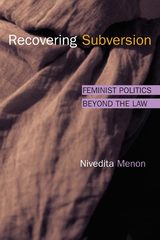 Recovering Subversion: Feminist Politics beyond the Law
Nivedita Menon
University of Illinois Press, 2004 Is the language of rights enough to foster real social and political change? Nivedita Menon explores the relationship between law and feminist politics by examining the contemporary Indian women's movement with comparisons to France and the United States. She argues that the intersection of feminist politics, law, and the state often paradoxically and severely distorts important ethical and emancipatory impulses of feminism. Menon reviews historical challenges to the liberal notion of rights from Marxist, feminist, postcolonial, and critical legal scholars, and analyzes current Indian debates on topics including abortion, sexual violence, and Parliamentary quotas for women. Far from being a call to withdraw from the arena of law, Recovering Subversion instead urges feminists everywhere to recognize the limits of "rights discourse" and pleads for a politics that goes beyond its boundaries.
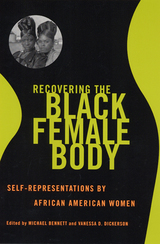 Recovering the Black Female Body: Self-Representation by African American Women
Edited by Michael Bennett and Vanessa D Dickerson
Rutgers University Press, 2000 Despite the recent flood of scholarly work investigating the interrelated issues of race, gender, and representation, little has been written about black women’s depictions of their own bodies. Both past and present-day American cultural discourse has attempted either to hypereroticize the black female body or make it a site of impropriety and crime. The essays in this volume focus on how African American women, from the nineteenth century to the present, have represented their physical selves in opposition to the distorted vision of others. Contributors attempt to “recover” the black female body in two ways: they explore how dominant historical images have mediated black female identity, and they analyze how black women have resisted often demeaning popular cultural perceptions in favor of more diverse, subtle presentations of self. The pieces in this book—all of them published here for the first time—address a wide range of topics, from antebellum American poetry to nineteenth-century African American actors, and twentieth-century pulp fiction. Recovering the Black Female Body recognizes the pressing need to highlight through scholarship the vibrant energy of African American women’s attempts to wrest control of the physical and symbolic construction of their bodies away from the distortions of others. Contributors are Margaret Bass, Dorri Rabung Beam, Michael Bennett, Jacqueline E. Brady, Daphne A. Brooks, Vanessa D. Dickerson, Meredith Goldsmith, Yvette Louis, Ajuan Maria Mance, Noliwe Rooks, Mark Winokur, and Doris Witt. This book also contains a foreword by Carla L. Peterson and an afterword by Deborah E. McDowell.
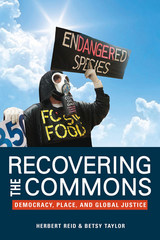 Recovering the Commons: Democracy, Place, and Global Justice
Herbert Reid and Betsy Taylor
University of Illinois Press, 2010 This penetrating work culls key concepts from grassroots activism to hold critical social theory accountable to the needs, ideas, and organizational practices of the global justice movement. The resulting critique of neoliberalism hinges on place-based struggles of groups marginalized by globalization and represents a brave rethinking of politics, economy, culture, and professionalism. Providing new practical and conceptual tools for responding to human and environmental crises in Appalachia and beyond, Recovering the Commons radically revises the framework of critical social thought regarding our stewardship of the civic and ecological commons. Herbert Reid and Betsy Taylor ally social theory, field sciences, and local knowledge in search of healthy connections among body, place, and commons that form a basis for solidarity as well as a vital infrastructure for a reliable, durable world. Drawing particularly on the work of philosophers Maurice Merleau-Ponty, John Dewey, and Hannah Arendt, the authors reconfigure social theory by ridding it of the aspects that reduce place and community to sets of interchangeable components. Instead, they reconcile complementary pairs such as mind/body and society/nature in the reclamation of public space. With its analysis embedded in philosophical and material contexts, this penetrating work culls key concepts from grassroots activism to hold critical social theory accountable to the needs, ideas, and organizational practices of the global justice movement. The resulting critique of neoliberalism hinges on place-based struggles of groups marginalized by globalization and represents a brave rethinking of politics, economy, culture, and professionalism.
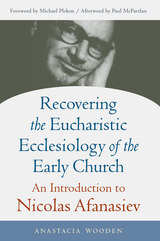 Recovering the Eucharistic Ecclesiology of the Early Church: An Introduction to Nicolas Afanasiev
Anastacia Wooden
Catholic University of America Press, 2025 The first theologian who spoke of eucharistic ecclesiology was the Russian Orthodox church historian and canonist Nicholas Afanasiev (1893-1966). He claimed to have re-discovered and systematized the original ecclesiology of the early church, which he called “eucharistic.” Since then, the eucharistic ecclesiology crossed confessional borders and shaped the theological discussion on the nature of the church. Many authors of different Christian confessions developed Afanasiev’s basic intuition while proposing a variety of their own understandings of the “eucharistic nature” of the church: from Orthodox theologians like John Zizioulas and John Romanides to Catholic theologians like J.-M. Tillard and Joseph Ratzinger. Ironically, the details of Afanasiev’s own ecclesiological system remain largely unknown. The aim of this book is to formulate a comprehensive view of Afanasiev’s ecclesiological vision and of its significance for contemporary ecclesial life in two parts.
It is Anastacia Wooden’s conviction that the prevailing “stereotypical” view of Afanasiev’s ecclesiology is suffering from misapprehension of his thought. Therefore, Part one addresses the issues that historically complicated understanding of Afanasiev’s ecclesiology. It will provide historical, theological, and biographical context of Afanasiev’s scholarship by presenting keys to understanding of his eucharistic ecclesiology.
In the second part the book provides a synthesis of Afanasiev’s total ecclesiological vision as well as systematic presentation of six specific ecclesiological issues. It demonstrates how Afanasiev’s methodological assumption that ecclesiology can serve as a tool to make sense of the historical data on the life of the church led to his realization that the early church had an operative ecclesiology which placed the exercise of royal priesthood in the Eucharist as the starting point of the ecclesial structure. In each chapter of the second part, this book provides reflections on the contemporary relevance of Afanasiev’s work. In the current crises of leadership in the Catholic Church (as well as other Christian churches) it may prevent the adoption of arbitrary forms of lay participation in the church governance by reminding church leaders that a theologically meaningful increase of lay participation should always be framed in terms of the increased participation of local churches.
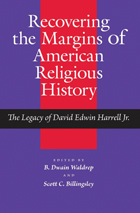 Recovering the Margins of American Religious History: The Legacy of David Edwin Harrell Jr.
B. Dwain Waldrep
University of Alabama Press, 2012 Normal0falsefalsefalseMicrosoftInternetExplorer4 Recovering the Margins of American Religious History, a celebration of the life and work of David Edwin Harrell Jr., brings together essays from Harrell’s colleagues, peers, and students that explore his impact and legacy in the field of American religious studies. Raised in an upper-class family in mid-twentieth-century Jacksonville, Florida, Harrell’s membership in the Church of Christ helped establish his sense of self as a spiritual outsider. This early exclusion from the Christian mainstream laid a foundation for Harrell’s pioneering studies of marginalized faiths, including the first stirrings of neo-fundamentalism and the diminishingly influential social gospel movement. Harrell’s connections with these religious movements point to his deeper ongoing concerns with class, gender, and race as core factors behind religious institutions, and he has unblinkingly investigated a wide range of social dynamics. Combining an extensive knowledge of and long-standing passion for American religious history with a comprehensive understanding of the developing world, Harrell’s research and writings over his lifetime have produced compelling portraits of the American religious underclass, an increased integration of religion into the narrative of world history, and innovative new comparative studies in the healing and charismatic movements of the developing world. Normal0falsefalsefalseMicrosoftInternetExplorer4 Contributors Scott C. Billingsley / Wayne Flynt / James R. Goff Jr. / John C. Hardin / Samuel S. Hill / Richard T. Hughes / Beth Barton Schweiger / Grant Wacker / B. Dwain Waldrep / Charles Reagan Wilson
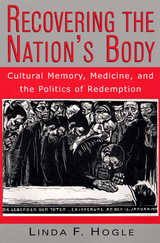 Recovering the Nation's Body: Cultural Memory, Medicine, and the Politics of Redemption
Linda F Hogle
Rutgers University Press, 1999 The body is both a site for medical practice and a source of therapeutic and scientific tools. As such, there are a variety of meanings ascribed to the body which both affect and are affected by cultural, economic, political and legal complexities. In order to access and use body parts, Linda F. Hogle states, transformative scientific and cultural processes are brought into play. Nowhere is this more evident than present-day Germany, where the spectre of Nazi medical experimentation still plays a large role in national policies governing the use of body parts and the way these policies are put into practice. In their efforts to be perceived as not repeating atrocities of the past, German medical practitioners and policy-makers reformulate ideas of bodily violation. To further confuse the issue, the reunification of East and West Germany has engendered new questions about the relationship between individuals’ bodies, science, and the state. Hogle shows how “universal” medicine is reinterpreted through the lens of national and transnational politics and history, using comparative examples from her research in the United. States. Recovering the Nation’s Body is the first book to analyze the actual practices involved in procuring human tissue, and the first to examine how the German past and the unique present-day situation within the European Union are key in understanding the form that medical practices take within various contexts.
 The Recovery of Unconscious Memories: Hypermnesia and Reminiscence
Matthew Hugh Erdelyi
University of Chicago Press, 1996 Memory has recently become the focus of media attention because of the emotionally charged uses made of delayed recall of repressed memories. Integrating literatures from all corners of psychology, The Recovery of Unconscious Memories includes historical accounts, analysis of experiments, and treatment topics, providing the first comprehensive scientific account of memory and how can it can increase over time. Erdelyi includes his own important contributions to this field, ranging from his early attempts to use free-association to produce hypermnesia to his most recent research with hypnosis, subliminal stimuli, forced-recall techniques, and very long-delayed recall probes.
Sketching out the scientific foundations for a unified theory of repression that integrates the findings of the laboratory and the clinic, this comprehensive and authoritative synthesis of a century of memory research will be crucial reading for psychologists and clinicians, as well as forensic and legal professionals interested in the recovery of "inaccessible" memories.
"By debunking hypnosis, [Erdelyi] has allowed the debate on memory to move forward. . . . Erdelyi's work on hypermnesia is very important to our understanding of the mechanisms of memory and the brain."—Janet D. Feigenbaum, Times Literary Supplement
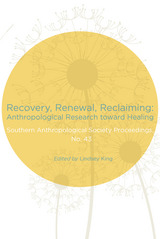 Recovery, Renewal, Reclaiming: Anthropological Research toward Healing
Lindsey King
University of Tennessee Press, 2015 Faced with a world that is environmentally out of balance, that is unhealthy in many respects, and that reflects stark inequalities, anthropologists are challenging themselves and others to engage in recovery, renewal, and reclaiming. This volume of Southern Anthropological Society Proceedings seeks to grapple with these challenges head-on. The essays provide wide-ranging discussions of concrete problems, often with a focus on the Appalachian region. Among the important issues raised are the following: the effect of landscape on health in Huntington, West Virginia; food justice; drug use and its misrepresentation in Appalachia; the relationship between evangelical religion and depression; the changing definitions of mental illness over time and how those definitions are used as instruments of social control; how the spiritual practices of Eastern Band Cherokees are connected to medical care; and the challenges recent Haitian immigrants face in obtaining health care in a new culture.
While solutions to these problems are complex and always have their roots in local circumstance, the essays in Recovery, Renewal, Reclaiming will inspire strategies that will clear blighted environments, deliver nourishing food, ease the lives of marginalized people, and lead to respect for all beliefs as we work together to bring balance to our environmental, physical, and spiritual health.
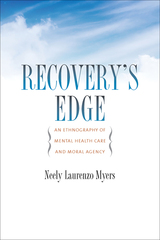 Recovery's Edge: An Ethnography of Mental Health Care and Moral Agency
Neely Laurenzo Myers
Vanderbilt University Press, 2015 In 2003 the Bush Administration's New Freedom Commission asked mental health service providers to begin promoting "recovery" rather than churning out long-term, "chronic" mental health service users. Recovery's Edge sends us to urban America to view the inner workings of a mental health clinic run, in part, by people who are themselves "in recovery" from mental illness.
In this provocative narrative, Neely Myers sweeps us up in her own journey through three years of ethnographic research at this unusual site, providing a nuanced account of different approaches to mental health care. Recovery's Edge critically examines the high bar we set for people in recovery through intimate stories of people struggling to find meaningful work, satisfying relationships, and independent living.
This book is a recipient of the Norman L. and Roselea J. Goldberg Prize from Vanderbilt University Press for the best book in the area of medicine.
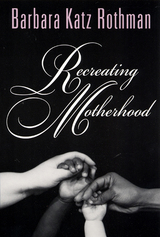 Recreating Motherhood
Rothman, Barbara Katz
Rutgers University Press, 2000 Selling “genetically gifted” human eggs on the free market for a hefty price. In vitro fertilization. Fetal rights. Prenatal diagnosis. Surrogacy. All are instances of biomedical and social “advancements” with which we have become familiar in recent years. Yet these issues are often regarded as distinct or only loosely related under the rubric of reproduction. Barbara Katz Rothman demonstrates how they form a complex whole that demands of us in response a woman-centered, class-sensitive way of understanding motherhood. We need a social policy for dealing with mothers and motherhood that is consistent with feminist politics and feminist theory. Her book show how we as a society must first recognize that the real needs of mother, father, and children have been swept aside in an attempt to reduce the complex process of human reproduction to a clinical event that can be controlled by medical technology. Rothman suggests ways to accomplish social and legal change that would allow technological advances to affirm motherhood and the mother-child relationship without cost to women’s identity. This new edition of Recreating Motherhood contains exciting updates. Rothman shows how this material is key in understanding the family, not just motherhood. And a new chapter, “Reflections on a Decade,” explores how new reproductive technologies combine with new marketing and new genetics to pose troubling social questions.
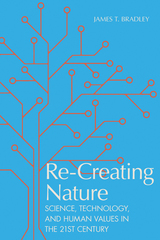 Re-Creating Nature: Science, Technology, and Human Values in the Twenty-First Century
James T. Bradley
University of Alabama Press, 2019 An exploration of the moral and ethical implications of new biotechnologies
Many of the ethical issues raised by new technologies have not been widely examined, discussed, or indeed settled. For example, robotics technology challenges the notion of personhood. Should a robot, capable of making what humans would call ethical decisions, be held responsible for those decisions and the resultant actions? Should society reward and punish robots in the same way that it does humans? Likewise, issues of safety, environmental concerns, and distributive justice arise with the increasing acceptance of genetically modified organisms (GMOs) in food production nanotechnology in engineering and medicine, and human gene therapy and enhancement. The problem of dual-use—when a technology can be used both to benefit and to harm—exists with virtually all new technologies but is central in the context of emerging 21st century technologies ranging from artificial intelligence and robotics to human gene-editing and brain-computer interfacing.
In Re-Creating Nature: Science, Technology, and Human Values in the Twenty-First Century, James T. Bradley addresses emerging biotechnologies with prodigious potential to benefit humankind but that are also fraught with ethical consequences. Some actually possess the power to directly alter the evolution of life on earth including human. Specifically, these topics include stem cells, synthetic biology, GMOs in agriculture, nanotechnology, bioterrorism, CRISPR gene-editing technology, three-parent babies, robotics and roboethics, artificial intelligence, and human brain research and neurotechnologies.
Offering clear explanations of these various technologies, a pragmatic presentation of the conundrums involved, and questions that illuminate hypothetical situations, Bradley guides discussions of these and other thorny issues resulting from the development of new biotechnologies. He also highlights the responsibilities of scientists to conduct research in an ethical manner and the responsibilities of nonscientists to become “science literate” in the twenty-first century.
Recreating Newton: Newtonian Biography and the Making of Nineteenth-Century History of Science
Rebekah Higgitt
University of Pittsburgh Press, 2007 Higgitt examines Isaac Newton's changing legacy during the nineteenth century. She focuses on 1820–1870, a period that saw the creation of the specialized and secularized role of the "scientist." At the same time, researchers gained better access to Newton's archives. These were used both by those who wished to undermine the traditional, idealised depiction of scientific genius and those who felt obliged to defend Newtonian hagiography. Higgitt shows how debates about Newton's character stimulated historical scholarship and led to the development of a new expertise in the history of science.
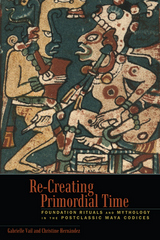 Re-Creating Primordial Time: Foundation Rituals and Mythology in the Postclassic Maya Codices
Gabrielle Vail and Christine Hernández
University Press of Colorado, 2013 Re-Creating Primordial Time offers a new perspective on the Maya codices, documenting the extensive use of creation mythology and foundational rituals in the hieroglyphic texts and iconography of these important manuscripts. Focusing on both pre-Columbian codices and early colonial creation accounts, Vail and Hernández show that in spite of significant cultural change during the Postclassic and Colonial periods, the mythological traditions reveal significant continuity, beginning as far back as the Classic period.
Remarkable similarities exist within the Maya tradition, even as new mythologies were introduced through contact with the Gulf Coast region and highland central Mexico. Vail and Hernández analyze the extant Maya codices within the context of later literary sources such as the Books of Chilam Balam, the Popol Vuh, and the Códice Chimalpopoca to present numerous examples highlighting the relationship among creation mythology, rituals, and lore. Compiling and comparing Maya creation mythology with that of the Borgia codices from highland central Mexico, Re-Creating Primordial Time is a significant contribution to the field of Mesoamerican studies and will be of interest to scholars of archaeology, linguistics, epigraphy, and comparative religions alike.
Recreating the Medieval Globe: Acts of Recycling, Revision, and Relocation
Joseph Shack
Arc Humanities Press, 2020 The creative reuse of materials, texts, and ideas was a common phenomenon in the medieval world. The seven chapters offer here a synchronic and diachronic consideration of the receptions and meanings of events and artifacts, analyzing the processes that allowed medieval works to remain relevant in sociocultural contexts far removed from those in which they originated. In the process, they elucidate the global valences of recycling, revision, and relocation throughout the interconnected Middle Ages, and their continued relevance for the shaping of modernity. The essays examine cases in the Arab and Muslim world, China and Mongolia, and the Prussian-Lithuanian frontier of eastern Europe.
 Recreational Colonialism and the Rhetorical Landscapes of the Outdoors
Kyle Boggs
Ohio State University Press, 2025 In Recreational Colonialism and the Rhetorical Landscapes of the Outdoors, Kyle Boggs chronicles the struggle between Indigenous peoples who have rooted religious and cultural ties to outdoor sites across the US and elsewhere and the settlers who claim the right to freely recreate in those same places. Synthesizing theories of rhetoric, environmental studies, and settler colonialism, Boggs confronts the ways that settler colonial experiences and expectations have been narrated through rhetorical practices on these so-called public lands. Fusing journalism and personal narrative with scholarly research, Boggs’s argument comes to bear on his central case study of a northern Arizona ski development on a mountain held sacred by at least thirteen Indigenous tribes. In illuminating the striking ways that settler imaginaries are accommodated, performed, and sustained in the everyday, Boggs offers a powerful reminder that even during leisure activities (in this case, sports such as ultrarunning, rock climbing, and skiing), complex webs of power control who can access resources and land and who has the right to protect histories and cultures.
 Recruiting Young Love: How Christians Talk about Homosexuality
Mark D. Jordan
University of Chicago Press, 2011 In the view of many Christians, the teenage years are simultaneously the most dangerous and the most promising. At the very moment when teens are trying to establish a sense of identity and belonging, they are beset by temptation on all sides—from the pressure of their peers to the nihilism and materialism of popular culture. Add the specter of homosexuality to the mix, and you’ve got a situation ripe for worry, sermonizing, and exploitation.
In Recruiting Young Love, Mark D. Jordan explores more than a half century of American church debate about homosexuality to show that even as the main lesson—homosexuality is bad, teens are vulnerable—has remained constant, the arguments and assumptions have changed remarkably. At the time of the first Kinsey Report, in 1948, homosexuality was simultaneously condemned and little discussed—a teen struggling with same-sex desire would have found little specific guidance. Sixty years later, church rhetoric has undergone a radical shift, as silence has given way to frequent, public, detailed discussion of homosexuality and its perceived dangers. Along the way, churches have quietly adopted much of the language and ideas of modern sexology, psychiatry, and social reformers—deploying it, for example, to buttress the credentials of anti-gay “deprogramming” centers and traditional gender roles.
Jordan tells this story through a wide variety of sources, including oral histories, interviews, memoirs, and even pulp novels; the result is a fascinating window onto the never-ending battle for the teenage soul.
The Recurrence of Fate: Theatre and Memory in Twentieth-Century Russia
Spencer Jay Golub
University of Iowa Press, 1994 How, why, and according to whose definitions and requirements does a culture self-consciously create memory and project its fate? In this remarkable book—the first in English to treat Russian history as theatre and cultural performance—Spencer Golub reveals the performative nature of Russian history in the twentieth century and the romantic imprisonment/self-imprisonment of the creative intelligentsia within this scenario.
Recurrent Maladies in Scholarly Writing
Eugene S. McCartney
University of Michigan Press, 1953 In his preface to Recurrent Maladies in Scholarly Writing, Eugene S. McCartney says, "During my lengthy service I have edited books in a great variety of subjects and have seen through the press over fourteen hundred articles reporting investigations in a dozen fields. . . . In spite of the great diversity of treatment and subject matter, the regularity with which manuscripts from the four corners of our land continue to tax editors' time, strength, knowledge, resourcefulness, and tact demonstrates the fundamental unity of our nation and our abiding adherence to the American way of life." His lavishly illustrated observations on the common mistakes of authors are both amusing and instructive.
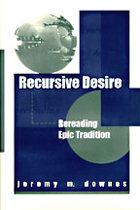 Recursive Desire: Rereading Epic Tradition
Jeremy M. Downes
University of Alabama Press, 1997 Epic has often been seen as a dead genre, intrinsically patriarchal and nationalistic. Furthermore, the psychological model most frequently applied to the relations between poets has been a violent one--the Freudian masterplot of Oedipus slaying the father to possess the mother. The limited usefulness of such simplistic explanations of epic is readily apparent when confronted with the continuing production of epic poetry long after its so-called death; when confronted with the contemporary drive toward epic among women poets, people of color, and postcolonial poets; and when faced with epic's fundamentally recursive desire--obvious in oral epic, but common to the entire genre--to repeat rather than to kill or evade its precursors.
Recursive desire, rooted in more basic preoedipal negotiations of union and separation rather than in Oedipal conflict, provides an elegant and far more useful explanation. By rereading and substantially redefining epic in this way, this book recognizes and reinvests with meaning the vital recursive qualities of the genre. Examining a diverse array of texts from the Epic of Gilgamesh to Derek Walcott's Osmeros, from the Homeric epics to H.D.'s Helen in Egypt. The book develops a broadened, inclusive, and living tradition of epic poetry, demonstrating the continuities of that tradition across dramatic discontinuities in time, place, worldview, and technology.
Recursive Desire rereads epic tradition and specific epic poems in ways that challenge traditional notions of the genre and open up unexplored fields of endeavor to students of epic, of poetry, and of narrative. With its more powerful and comprehensive psychological model of poetic relations, the book provides readers with a new understanding of epic poetry and its vital, shifting, polyvocal array (and disarray) of textual forces.
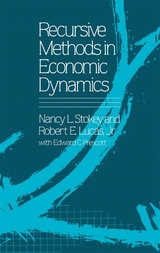 Recursive Methods in Economic Dynamics
Nancy L. Stokey and Robert E. Lucas, Jr.
Harvard University Press, 1989 Three eminent economists provide in this book a rigorous, self-contained treatment of modern economic dynamics. Nancy L. Stokey, Robert E. Lucas, Jr., and Edward C. Prescott develop the basic methods of recursive analysis and emphasize the many areas where they can usefully be applied.
After presenting an overview of the recursive approach, the authors develop economic applications for deterministic dynamic programming and the stability theory of first-order difference equations. They then treat stochastic dynamic programming and the convergence theory of discrete-time Markov processes, illustrating each with additional economic applications. They also derive a strong law of large numbers for Markov processes. Finally, they present the two fundamental theorems of welfare economics and show how to apply the methods developed earlier to general equilibrium systems.
The authors go on to apply their methods to many areas of economics. Models of firm and industry investment, household consumption behavior, long-run growth, capital accumulation, job search, job matching, inventory behavior, asset pricing, and money demand are among those they use to show how predictions can be made about individual and social behavior. Researchers and graduate students in many areas of economics, both theoretical and applied, will find this book essential.
 Recycled Stars: Female Film Stardom in the Age of Television and Video
Mary R. Desjardins
Duke University Press, 2015 The popularity of television in postwar suburban America had a devastating effect on the traditional Hollywood studio system. Yet many aging Hollywood stars used television to revive their fading careers. In Recycled Stars, Mary R. Desjardins examines the recirculation, ownership, and control of female film stars and their images in television, print, and new media. Female stardom, she argues, is central to understanding both the anxieties and the pleasures that these figures evoke in their audiences’ psyches through patterns of fame, decline, and return. From Gloria Swanson, Loretta Young, Ida Lupino, and Lucille Ball, who found new careers in early television, to Maureen O’Hara’s high-profile 1957 lawsuit against the scandal magazine Confidential, to the reappropriation of iconic star images by experimental filmmakers, video artists, and fans, this book explores the contours of female stars’ resilience as they struggled to create new contexts for their waning images across emerging media.
Recycling and Incineration: Evaluating The Choices
Richard A. Denison and John Ruston; Environmental Defense Fund
Island Press, 1990 Recycling and Incineration presents information on the technology, economics, environmental concerns, and legal intricacies behind recycling and incineration programs.
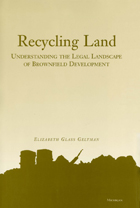 Recycling Land: Understanding the Legal Landscape of Brownfield Development
Elizabeth Glass Geltman
University of Michigan Press, 2000 Older--and often economically depressed--industrial cities generally have a number of well located but abandoned industrial sites. Too frequently these sites are heavily polluted by the residue of toxic wastes dumped when old factories were still in use. These "brownfield" sites must be cleaned up under existing law before they can be redeveloped. And yet the question of who will bear the cost of this cleanup frequently stymies efforts to return these sites to productive use. A complicated net of federal, state and local regulations can involve several generations of owners in potential liability for the cleanup, frequently resulting only in extended litigation, not often in the cleanup of the site. In this book, Elizabeth Glass Geltman surveys the laws on both the federal and state level with regard to the cleanup of brownfield sites. The author makes valuable suggestions for reforming these laws that will help encourage land reuse and the accompanying redevelopment of the industrial base of many American cities both large and small.
Elizabeth Glass Geltman is Professor of Law, George Washington University Law School and is the author of many books on environmental law, including Modern Environmental Law: Policy and Practice.
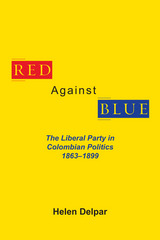 Red Against Blue: The Liberal Party in Colombian Politics, 1863 - 1899
Helen Delpar
University of Alabama Press, 1981 “Delpar provides a history of Colombia’s liberal party covering a period in which it was first the dominant party (1863-1885) and then the party of opposition (1886-1899). Delpar’s study is well written and firmly grounded in extensive research [and] will occupy a prominent position in the sparse historiography of the late 19th century Colombia.” – Hispanic American Historical Review (HAHR) “Delpar has given us a book that is disarmingly unpretentious yet offers considerably more than the title implies. As a discussion of the Liberal Party during the latter part of the 19th century, it is more narrative and descriptive than theoretical and analytical, indeed quite free of both redundant conceptualization and overly self-conscious methodology.
“It pays due attention to historical origins, regional distribution of support the characteristics of Liberal leadership, Liberal doctrine such as it was, the rules of the political game under the constitution of 1863, and the Liberal’s adjustment to opposition status after their fall from power in the 1880s. The author’s tone is clear and she has used an impressive quantity of published sources plus the personal papers of a good number of prominent Liberals.
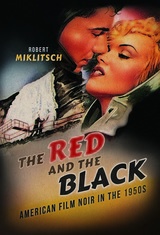 The Red and the Black: American Film Noir in the 1950s
Robert Miklitsch
University of Illinois Press, 2017 Critical wisdom has it that we said a long goodbye to film noir in the 1950s. Robert Miklitsch begs to differ. Pursuing leads down the back streets and alleyways of cultural history, The Red and the Black proposes that the received rise-and-fall narrative about the genre radically undervalues the formal and thematic complexity of '50s noir and the dynamic segue it effected between the spectacular expressionism of '40s noir and early, modernist neo-noir. Mixing scholarship with a fan's devotion to the crooked roads of critique, Miklitsch autopsies marquee films like D.O.A., Niagara, and Kiss Me Deadly plus a number of lesser-known classics. Throughout, he addresses the social and technological factors that dealt deuce after deuce to the genre--its celebrated style threatened by new media and technologies such as TV and 3-D, color and widescreen, its born losers replaced like zombies by All-American heroes, the nation rocked by the red menace and nightmares of nuclear annihilation. But against all odds, the author argues, inventive filmmakers continued to make formally daring and socially compelling pictures that remain surprisingly, startlingly alive. Cutting-edge and entertaining, The Red and the Black reconsiders a lost period in the history of American movies.
Red and Yellow, Black and Brown: Decentering Whiteness in Mixed Race Studies
Rondilla, Joanne L
Rutgers University Press, 2017 Red and Yellow, Black and Brown gathers together life stories and analysis by twelve contributors who express and seek to understand the often very different dynamics that exist for mixed race people who are not part white. The chapters focus on the social, psychological, and political situations of mixed race people who have links to two or more peoples of color— Chinese and Mexican, Asian and Black, Native American and African American, South Asian and Filipino, Black and Latino/a and so on. Red and Yellow, Black and Brown addresses questions surrounding the meanings and communication of racial identities in dual or multiple minority situations and the editors highlight the theoretical implications of this fresh approach to racial studies.
Red Army Red: Poems
Jehanne Dubrow
Northwestern University Press, 2012 Displaying a sure sense of craft and a sharp facility for linking personal experience to the public realms of history and politics, Jehanne Dubrow’s Red Army Red chronicles the coming of age of a child of American diplomats in Eastern Europe in the 1980s. In the last moments of the Cold War, Poland—the setting for many of the poems—lurches fitfully from a society characterized by hardship and deprivation toward a free-market economy. The contradictions and turmoil generated by this transition are the context in which an adolescent girl awakens to her sexuality. With wit and subtlety, Dubrow makes apparent the parallels between the body and the body politic, between the fulfillment of individual and collective desires.
 Red Arrow across the Pacific: The Thirty-Second Infantry Division during World War II
Mark D. Van Ells
Wisconsin Historical Society Press, 2024 The history of WWII’s most battle-tested US Army division and its crucial role in achieving Allied victory in the Pacific
Red Arrow across the Pacific reveals the long-overdue story of the renowned Thirty-Second "Red Arrow" Infantry Division. Discover how this National Guard unit—which originated in Wisconsin and Michigan but soon evolved to include soldiers from California to New England—became one of the first US military units deployed overseas in World War II, eventually logging more combat hours than any other US Army division.
Far more than a traditional battle narrative, Red Arrow across the Pacific offers a cultural history of the Red Arrow's wartime experience, from its mobilization in 1940, to its deployment across New Guinea, Australia, and the Philippines, to its postwar occupation of Japan. Drawing from letters, memoirs, and interviews, author Mark D. Van Ells lets the soldiers speak for themselves, describing in their own words the terror of combat, their impressions of foreign lands, the struggle to maintain their own humanity, and the many ways the war profoundly changed them.
Nuanced and remarkably thorough, this book explores the dramatic evolution of the Thirty-Second Infantry Division and reveals how the story of the Red Arrow reflects the experience of the US military during World War II.
“Exceptionally well researched and engagingly written. This book is a must read for any student of military history.”
—Capt. Florian L. Waitl, Command Historian, Wisconsin Army National Guard
“A superb divisional history. . . . Highly recommended for a general audience, as well as readers interested in the Second World War.”
—Mary Louise Roberts, Lucie Aubrac Distinguished Professor Emerita of History, University of Wisconsin–Madison, and author of Sheer Misery: Soldiers in Battle in WWII
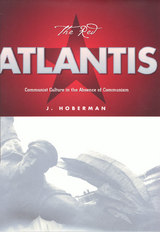 The Red Atlantis
J. Hoberman
Temple University Press, 2000 For most of the twentieth century, American and European intellectual life was defined by its fascination with a particular utopian vision. Both the artistic and political vanguards were spellbound by the Communist promise of a new human era -- so much so that its political terrors were rationalized as a form of applied evolution and its collapse hailed as the end of history.
The Red Atlantis argues that Communism produced a complex culture with a dialectical relation to both modernism and itself. Offering examples ranging from the Stalinist show trial to Franz Kafka's posthumous career as a dissident writer and the work of filmmakers, painters, and writers, which can be understood only as criticism of existing socialism made from within, The Red Atlantis suggests that Communism was an aesthetic project -- perhaps the aesthetic project of the twentieth century.
Considering the meaning of Communist culture in its absence, these essays sift through the wrecking age of Marxist fantasy to exhibit exhumed fossils (Socialist Realist canvases), vanished monuments (the Berlin Wall), imaginary territories (the Jewish state, Birobidzhan), and ideological memories (the Crime of the Century). The Cold War notwithstanding, the greatest of these exotic artifacts and obsolete scenarios is the lost Communist utopia, which, in fact, never existed.
 The Red Atlas: How the Soviet Union Secretly Mapped the World
John Davies and Alexander J. Kent
University of Chicago Press, 2017 Nearly thirty years after the end of the Cold War, its legacy and the accompanying Russian-American tension continues to loom large. Russia’s access to detailed information on the United States and its allies may not seem so shocking in this day of data clouds and leaks, but long before we had satellite imagery of any neighborhood at a finger’s reach, the amount the Soviet government knew about your family’s city, street, and even your home would astonish you. Revealing how this was possible, The Red Atlas is the never-before-told story of the most comprehensive mapping endeavor in history and the surprising maps that resulted.
From 1950 to 1990, the Soviet Army conducted a global topographic mapping program, creating large-scale maps for much of the world that included a diversity of detail that would have supported a full range of military planning. For big cities like New York, DC, and London to towns like Pontiac, MI and Galveston, TX, the Soviets gathered enough information to create street-level maps. What they chose to include on these maps can seem obvious like locations of factories and ports, or more surprising, such as building heights, road widths, and bridge capacities. Some of the detail suggests early satellite technology, while other specifics, like detailed depictions of depths and channels around rivers and harbors, could only have been gained by actual Soviet feet on the ground. The Red Atlas includes over 350 extracts from these incredible Cold War maps, exploring their provenance and cartographic techniques as well as what they can tell us about their makers and the Soviet initiatives that were going on all around us.
A fantastic historical document of an era that sometimes seems less distant, The Red Atlas offers an uncanny view of the world through the eyes of Soviet strategists and spies.
Red Atom: Russias Nuclear Power Program From Stalin To Today
Paul Josephson
University of Pittsburgh Press, 2005
In the 1950s, Soviet nuclear scientists and leaders imagined a stunning future when giant reactors would generate energy quickly and cheaply, nuclear engines would power cars, ships, and airplanes, and peaceful nuclear explosions would transform the landscape. Driven by the energy of the atom, the dream of communism would become a powerful reality. Thirty years later, that dream died in Chernobyl. What went wrong? Based on exhaustive archival research and interviews, Red Atom takes a behind-the-scenes look at the history of the Soviet Union's peaceful use of nuclear power. It explores both the projects and the technocratic and political elite who were dedicated to increasing state power through technology. And it describes the political, economic, and environmental fallout of Chernobyl.
The Red Badge of Courage
Stephen Crane
Harvard University Press, 2009 Stephen Crane’s weirdly impressionistic The Red Badge of Courage is one of the first non-romantic novels of the Civil War—and the first nonromantic account to gain wide popularity. Paul Sorrentino introduces Red Badge to a new generation of readers for a fuller appreciation of the novel and its effects. He has selected as his text the first edition, published by D. Appleton & Co. in 1895.
 The Red Bird All-Indian Traveling Band
Frances Washburn
University of Arizona Press, 2014 Opening July 4, 1969, on the Pine Ridge Reservation, The Red Bird All-Indian Traveling Band begins with a raucous Fourth of July gig that abruptly ends with the Red Birds ducking out of the performance in a hilarious hail of beer bottles. By the end of the evening, community member Buffalo Ames is dead, presumed to be murdered, just outside the bar. Sissy Roberts, the band’s singer and the “best female guitar picker on the rez,” is reluctantly drawn into the ensuing investigation by an FBI agent who discovers Sissy’s knack for hearing other people’s secrets.
The Red Bird All-Indian Traveling Band is part mystery, part community chronicle. Shaped by a cast of skillfully drawn characters, all of whom at one time or another are potential suspects, at the core of the story is smart and compassionate Sissy. Four years past high school, Sissy’s wry humor punctuates descriptions of reservation life as she learns more about Ames’s potential killer, and as she embarks on a personal search for ways to buck expectations and leave rural South Dakota to attend college.
Ames’s death is just an example of the undercurrents of violence and passions that run through this fast-moving novel of singing, loving, and fighting. Following Sissy as she unravels the mystery of both Buffalo Ames’s death and her own future, The Red Bird All-Indian Traveling Band is the story of Indian Country on the verge of historic change and a woman unwilling to let change pass her by.
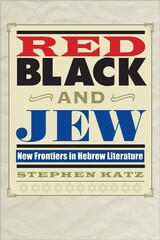 Red, Black, and Jew: New Frontiers in Hebrew Literature
By Stephen Katz
University of Texas Press, 2009 Between 1890 and 1924, more than two million Jewish immigrants landed on America's shores. The story of their integration into American society, as they traversed the difficult path between assimilation and retention of a unique cultural identity, is recorded in many works by American Hebrew writers. Red, Black, and Jew illuminates a unique and often overlooked aspect of these literary achievements, charting the ways in which the Native American and African American creative cultures served as a model for works produced within the minority Jewish community. Exploring the paradox of Hebrew literature in the United States, in which separateness, and engagement and acculturation, are equally strong impulses, Stephen Katz presents voluminous examples of a process that could ultimately be considered Americanization. Key components of this process, Katz argues, were poems and works of prose fiction written in a way that evoked Native American forms or African American folk songs and hymns. Such Hebrew writings presented America as a unified society that could assimilate all foreign cultures. At no other time in the history of Jews in diaspora have Hebrew writers considered the fate of other minorities to such a degree. Katz also explores the impact of the creation of the state of Israel on this process, a transformation that led to ambivalence in American Hebrew literature as writers were given a choice between two worlds. Reexamining long-neglected writers across a wide spectrum, Red, Black, and Jew celebrates an important chapter in the history of Hebrew belles lettres.
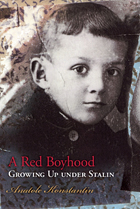 A Red Boyhood: Growing Up Under Stalin
Anatole Konstantin
University of Missouri Press, 2008 Many children growing up in the Soviet Union before World War II knew the meaning of deprivation and dread. But for the son of an “enemy of the people,” those apprehensions were especially compounded. When the secret police came for his father in 1938, ten-year-old Anatole Konstantin saw his family plunged into a morass of fear. His memoir of growing up in Stalinist Russia re-creates in vivid detail the daily trials of people trapped in this regime before and during the repressive years of World War II—and the equally horrific struggles of refugees after that conflict. Evicted from their home, their property confiscated, and eventually forced to leave their town, Anatole’s family experienced the fate of millions of Soviet citizens whose loved ones fell victim to Stalin’s purges. His mother, Raya, resorted to digging peat, stacking bricks, and even bootlegging to support herself and her two children. How she managed to hold her family together in a rapidly deteriorating society—and how young Anatole survived the horrors of marginalization and war—form a story more compelling than any novel. Looking back on those years from adulthood, Konstantin reflects on both his formal education under harsh conditions and his growing awareness of the contradictions between propaganda and reality. He tells of life in the small Ukrainian town of Khmelnik just before World War II and of how some of its citizens collaborated with the German occupation, lending new insight into the fate of Ukrainian Jews and Nazi corruption of local officials. And in recounting his experiences as a refugee, he offers a new look at everyday life in early postwar Poland and Germany, as well as one of the few firsthand accounts of life in postwar Displaced Persons camps. A Red Boyhood takes readers inside Stalinist Russia to experience the grim realities of repression—both under a Soviet regime and German occupation. A moving story of desperate people in desperate times, it brings to life the harsh realities of the twentieth century for young and old readers alike.
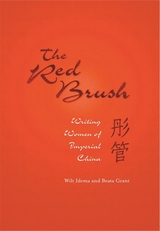 The Red Brush: Writing Women of Imperial China
Wilt L. Idema and Beata Grant
Harvard University Press, 2004 One of the most exciting recent developments in the study of Chinese literature has been the rediscovery of an extremely rich and diverse tradition of women's writing of the imperial period (221 BCE-1911 CE). Many of these writings are of considerable literary quality. Others provide us with moving insights into the lives and feelings of a surprisingly diverse group of women living in Confucian China, a society that perhaps more than any other is known for its patriarchal tradition.
Because of the burgeoning interest in the study of both premodern and modern women in China, several scholarly books, articles, and even anthologies of women's poetry have been published in the last two decades. This anthology differs from previous works by offering a glimpse of women's writings not only in poetry but in other genres as well, including essays and letters, drama, religious writing, and narrative fiction.
The authors have presented the selections within their respective biographical and historical contexts. This comprehensive approach helps to clarify traditional Chinese ideas on the nature and function of literature as well as on the role of the woman writer.
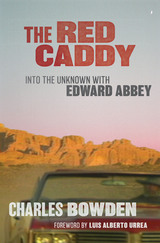 The Red Caddy: Into the Unknown with Edward Abbey
By Charles Bowden; foreword by Luis Alberto Urrea
University of Texas Press, 2018 A passionate advocate for preserving wilderness and fighting the bureaucratic and business forces that would destroy it, Edward Abbey (1927–1989) wrote fierce, polemical books such as Desert Solitaire and The Monkey Wrench Gang that continue to inspire environmental activists. In this eloquent memoir, his friend and fellow desert rat Charles Bowden reflects on Abbey the man and the writer, offering up thought-provoking, contrarian views of the writing life, literary reputations, and the perverse need of critics to sum up “what he really meant and whether any of it was truly up to snuff.” The Red Caddy is the first literary biography of Abbey in a generation. Refusing to turn him into a desert guru, Bowden instead recalls the wild man in a red Cadillac convertible for whom liberty was life. He describes how Desert Solitaire paradoxically “launched thousands of maniacs into the empty ground” that Abbey wanted to protect, while sealing his literary reputation and overshadowing the novels that Abbey considered his best books. Bowden also skewers the cottage industry that has grown up around Abbey’s writing, smoothing off its rougher (racist, sexist) edges while seeking “anecdotes, little intimacies . . . pieces of the True Beer Can or True Old Pickup Truck.” Asserting that the real essence of Abbey will always remain unknown and unknowable, The Red Caddy still catches gleams of “the fire that from time to time causes a life to become a conflagration.”
The Red Cell: Production, Metabolism, Destruction—Normal and Abnormal, Revised Edition
John Harris
Harvard University Press, 1970 Every chapter in this classic on hematology has been entirely updated. Beginning at the molecular level, the book gives a detailed description of the way a red blood cell is produced, its metabolic processes, and how it is destroyed. Data and examples drawn from experiments illustrate current knowledge of the subject and substantiate conclusions. Although the work is clinically oriented, the text emphasizes the experimental approach to seeking the pathophysiology and mechanisms of disease resulting from alterations in the life processes of the red cell. Nearly 100 illustrations accompany the text.
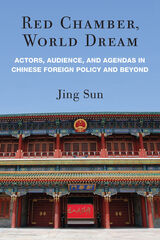 Red Chamber, World Dream: Actors, Audience, and Agendas in Chinese Foreign Policy and Beyond
Jing Sun
University of Michigan Press, 2021 Chinese president Xi Jinping is most famously associated with his “Chinese Dream” campaign, envisioning a great rejuvenation of the nation. Many observers, though, view China’s pursuit of this dream as alarming. They see a global power ready to abandon its low-profile diplomacy and eager to throw its weight around.
Red Chamber, World Dream represents an interdisciplinary effort of deciphering the Chinese Dream and its global impact. Jing Sun employs methods from political science and journalism and concepts from literature, sociology, psychology and drama studies, to offer a multilevel analysis of various actors’ roles in Chinese foreign policy making: the leaders, the bureaucrats, and its increasingly diversified public. This book rejects a simple dichotomy of an omnipotent, authoritarian state versus a suppressed society. Instead, it examines how Chinese foreign policy is constantly being forged and contested by interactions among its leaders, bureaucrats, and people. The competition for shaping China’s foreign policy also happens on multiple arenas: intraparty fighting, inter-ministerial feuding, social media, TV dramas and movies, among others. This book presents vast amounts of historical detail, many unearthed the first time in the English language. Meanwhile, it also examines China’s diplomatic responses to ongoing issues like the Covid-19 crisis. The result is a study multidisciplinary in nature, rich in historical nuance, and timely in contemporary significance.
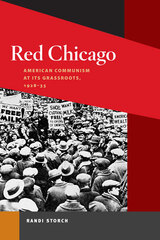 Red Chicago: American Communism at Its Grassroots, 1928-35
Randi Storch
University of Illinois Press, 2007 Red Chicago is a social history of American Communism set within the context of Chicago's neighborhoods, industries, and radical traditions. Using local party records, oral histories, union records, party newspapers, and government documents, Randi Storch fills the gap between Leninist principles and the day-to-day activities of Chicago's rank-and-file Communists. Uncovering rich new evidence from Moscow's former party archive, Storch argues that although the American Communist Party was an international organization strongly influenced by the Soviet Union, at the city level it was a more vibrant and flexible organization responsible to local needs and concerns. Thus, while working for a better welfare system, fairer unions, and racial equality, Chicago's Communists created a movement that at times departed from international party leaders' intentions. By focusing on the experience of Chicago's Communists, who included a large working-class, African American, and ethnic population, this study reexamines party members' actions as an integral part of the communities and industries in which they lived and worked.
Red Clay Suite
Honoree Fanonne Jeffers
Southern Illinois University Press, 2007 In her third book of poems, Honorée Fanonne Jeffers expresses her familiarity with the actual and imaginary spaces that the American South occupies in our cultural lexicon. Her two earlier books of poetry, The Gospel of Barbecue and Outlandish Blues, use the blues poetic to explore notions of history and trauma. Now, in Red Clay Suite, Jeffersapproaches the southern landscape as utopia and dystopia—a crossroads of race, gender, and blood. These poems signal the ending movement of her crossroads blues and complete the last four “bars” of a blues song, resting on the final, and essential, note of resolution and reconciliation.
Red Clay Weather
Reginald Shepherd
University of Pittsburgh Press, 2011 “Among other things, Shepherd has always been an elemental poet. His work abounds with the imagery and motifs of water and fire, and while those elements are important here, it is air and earth that are the more dominant elements in this collection. . . .
Clay, red clay in particular, recurs several times throughout the collection as a motif of earth. It is the substance of creation, but always of impermanent things, whether heroes or Babylonian statues with feet of clay, or of things durable but fragile, such as the cuneiform tablets of ‘A Parking Lot Just Outside the Ruins of Babylon.’”
—Robert Philen, from the Foreword
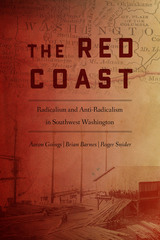 The Red Coast: Radicalism and Anti-Radicalism in Southwest Washington
Aaron Goings
Oregon State University Press, 2019 The Red Coast is a lively and readable informal history of the labor, left-wing, and progressive activists who lived, worked, and organized in southwest Washington State from the late nineteenth century until World War II. The book serves as a hidden history for a region frequently identified with conservatism, rescuing these working-class activists from obscurity and placing them at the center of southwest Washington's history.
With a focus on socialists, militant unionists, Wobblies, "Red" Finns, and Communists, The Red Coast covers the people, places, and events that made history-well-known events like the 1919 Armistice Day Tragedy in Centralia and the murders of labor activists William McKay and Laura Law in Aberdeen as well as lesser-known events that have been lost to posterity until now.
The Red Coast also delves deep into the lives and work of the region's anti-radical forces, examining the collective efforts of employers, news editors, and vigilantes to combat working-class organization. Topics include the Wobblies, the labor wars of the 1910s and 1930s, and the lumber and maritime industries. Labor historians, scholars, and general readers with interest in the working-class history of the Pacific Northwest will welcome this comprehensive and accessible account.
 Red Creative: Culture and Modernity in China
Justin O'Connor and Xin Gu
Intellect Books, 2020 Red Creative is an exploration of China’s cultural economy over the last twenty years, particularly through the lens of its creative hub of Shanghai. The research presented here raises questions about the nature of contemporary ‘creative’ capitalism and the universal claims of Western modernity, offering new ways of thinking about cultural policy in China.
Taking a long-term historical perspective, Justin O’Connor and Xin Gu analyze the ongoing development of China’s cultural industries, examining the institutions, regulations, interests, and markets that underpin the Chinese cultural economy and the strategic position of Shanghai within it. Further, the authors explore cultural policy reforms in post-colonial China and articulate Shanghai’s significance in paving China’s path to modernity and entry to global capitalism. In-depth and illuminating, Red Creative carefully situates China’s contemporary cultural economy in its larger global and historical context, revealing the limits of Western thought in understanding Chinese history, culture, and society.
Red Deer: Behavior and Ecology of Two Sexes
T. H. Clutton-Brock, F. E. Guinness, and S. D. Albon
University of Chicago Press, 1982 Red Deer: Behavior and Ecology of Two Sexes is the most extensive study yet available of reproduction in wild vertebrate. The authors synthesize data collected over ten years on a population of individually recognizable red deer, usually regarded as conspecific with the American elk. Their results reveal the extent of sex differences in behavior, reproduction, and ecology and make a substantial contribution to our understanding of sexual selection.
 Red Desert: History of a Place
Edited by Annie Proulx
University of Texas Press, 2008 Finalist, ForeWord Magazine Book of the Year Awards, Environment Category, 2008 A vast expanse of rock formations, sand dunes, and sagebrush in central and southwest Wyoming, the little-known Red Desert is one of the last undeveloped landscapes in the United States, as well as one of the most endangered. It is a last refuge for many species of wildlife. Sitting atop one of North America's largest untapped reservoirs of natural gas, the Red Desert is a magnet for energy producers who are damaging its complex and fragile ecosystem in a headlong race to open a new domestic source of energy and reap the profits. To capture and preserve what makes the Red Desert both valuable and scientifically and historically interesting, writer Annie Proulx and photographer Martin Stupich enlisted a team of scientists and scholars to join them in exploring the Red Desert through many disciplines—geology, hydrology, paleontology, ornithology, zoology, entomology, botany, climatology, anthropology, archaeology, sociology, and history. Their essays reveal many fascinating, often previously unknown facts about the Red Desert—everything from the rich pocket habitats that support an amazing diversity of life to engrossing stories of the transcontinental migrations that began in prehistory and continue today on I-80, which bisects the Red Desert. Complemented by Martin Stupich's photo-essay, which portrays both the beauty and the devastation that characterize the region today, Red Desert bears eloquent witness to a unique landscape in its final years as a wild place.
 Red Diapers: GROWING UP IN THE COMMUNIST LEFT
Edited by Judy Kaplan and Linn Shapiro
University of Illinois Press, 1998
Red Diapers is the
first anthology of autobiographical writings by the children of American
communists. These memoirs, short stories, and poems reflect the joys and
perils of growing up in a subculture defined by its opposition to some
of society's most deeply held values. How red diaper babies have come
to terms with their political inheritance is the theme of this compelling
anthology.
Some contributors have fond
memories of family activism; others recall the past with ambivalence or
even pain. The authors range in age from their twenties to their eighties.
Some, such as Watergate reporter Carl Bernstein and sixties activist Bettina
Aptheker, are widely known themselves; some are the children of well-known
American leftists, including Jeff Lawson, son of blacklisted screenwriter
John Howard Lawson, and Robert Meeropol, son of Ethel and Julius Rosenberg.
In disparate voices, the contributors elaborate on how their parents attempted
to pass on to them the torch of radical politics.
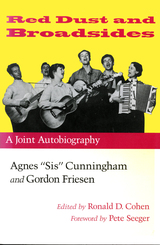 Red Dust and Broadsides: A Joint Autobiography
Ronald D. Cohen
University of Massachusetts Press, 1999 Perhaps best known for Broadside, the influential magazine they founded in 1962, Agnes "Sis" Cunningham and Gordon Friesen have long been renowned figures on the American left. In this book, these two dedicated social activists—Sis the folk musician and Gordon the radical journalist—offer a spirited account of their personal and political odyssey. The story is illustrated with numerous photographs and drawings. Born into poverty in rural Oklahoma, further shaped by the hardships of the "dustbowl" Depression years, Sis and Gordon were already committed to radical causes when they met and married in 1941. A short time later they moved to New York City, where they befriended Pete Seeger and Woody Guthrie. Sis joined the folk protest group the Almanac Singers, and Gordon continued his work as a journalist. Although blacklisted for their political views during the McCarthy era, Sis and Gordon persevered and eventually launched Broadside, which they continued to produce for almost twenty years. The magazine was instrumental in promoting the careers of many singer-songwriters, publishing the first works of such artists as Bob Dylan, Janis Ian, Phil Ochs, Buffy Sainte-Marie, and Tom Paxton, as well as the works of more established figures, including Malvina Reynolds and Pete Seeger. Indeed, Broadside gave birth to a musical revival that energized the country and forged a vital link between the folk music of the 1930s and 1940s and the urban folk revivalists of the 1960s and 1970s.
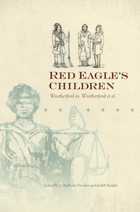 Red Eagle's Children: Weatherford vs. Weatherford et al.
Edited by J. Anthony Paredes and Judith Knight
University of Alabama Press, 2012 Red Eagle’s Children presents the legal proceedings in an inheritance dispute that serves as an unexpected window on the intersection of two cultural and legal systems: Creek Indian and Euro-American. Case 1299: Weatherford vs. Weatherford et al. appeared in the Chancery Court of Mobile in 1846 when William “Red Eagle” Weatherford’s son by the Indian woman Supalamy sued his half siblings fathered by Weatherford with two other Creek women, Polly Moniac and Mary Stiggins, for a greater share of Weatherford’s estate. While the court recognized William Jr. as the son of William Sr., he nevertheless lost his petition for inheritance due to the lack of legal evidence concerning the marriage of his biological mother to William Sr. The case, which went to the Alabama Supreme Court in 1851, provides a record of an attempt to interrelate and, perhaps, manipulate differences in cultures as they played out within the ritualized, arcane world of antebellum Alabama jurisprudence.
Although the case has value in the classic mold of salvage ethnography of Creek Indian culture, Red Eagle’s Children, edited by J. Anthony Paredes and Judith Knight, shows that its more enduring value lies in being a source for historical ethnography—that is, for anthropological analyses of cultural dynamics of the past
events that complement the narratives of professional historians.
Contributors
David I. Durham / Robbie Ethridge / Judith
Knight / J. Anthony Paredes / Paul M. Pruitt
Jr. / Nina Gail Thrower / Robert Thrower /
Gregory A. Waselkov
The Red Earth: A Vietnamese Memoir of Life on a Colonial Rubber Plantation
Binh Tu Tran
Ohio University Press, 1985 Phu Rieng was one of many French rubber plantations in colonial Vietnam; Tran Tu Binh was one of 17,606 laborers brought to work there in 1927, and his memoir is a straightforward, emotionally searing account of how one Vietnamese youth became involved in revolutionary politics. The connection between this early experience and later activities of the author becomes clear as we learn that Tran Tu Binh survived imprisonment on Con Son island to help engineer the general uprising in Hanoi in 1945. The Red Earth is the first of dozens of such works by veterans of the 1924–45 struggle in Vietnam to be published in English translation. It is important reading for all those interested in the many-faceted history of modern Vietnam and of communism in the non-Western world.
 Red Ellen: The Life of Ellen Wilkinson, Socialist, Feminist, Internationalist
Laura Beers
Harvard University Press, 2016 In 1908 Ellen Wilkinson, a fiery adolescent from a working-class family in Manchester, was “the only girl who talks in school debates.” By midcentury, Wilkinson had helped found Britain’s Communist Party, earned a seat in Parliament, and become a renowned advocate for the poor and dispossessed at home and abroad. She was one of the first female delegates to the United Nations, and she played a central role in Britain’s postwar Labour government. In Laura Beers’s account of Wilkinson’s remarkable life, we have a richly detailed portrait of a time when Left-leaning British men and women from a range of backgrounds sought to reshape domestic, imperial, and international affairs.
Wilkinson is best remembered as the leader of the Jarrow Crusade, the 300-mile march of two hundred unemployed shipwrights and steelworkers to petition the British government for assistance. But this was just one small part of Red Ellen’s larger transnational fight for social justice. She was involved in a range of campaigns, from the quest for official recognition of the Spanish Republican government, to the fight for Indian independence, to the effort to smuggle Jewish refugees out of Germany.
During Wilkinson’s lifetime, many British radicals viewed themselves as members of an international socialist community, and some, like her, became involved in socialist, feminist, and pacifist movements that spanned the globe. By focusing on the extent to which Wilkinson’s activism transcended Britain’s borders, Red Ellen adjusts our perception of the British Left in the early twentieth century.
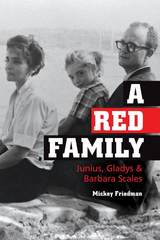 A Red Family: Junius, Gladys, and Barbara Scales
Mickey Friedman. Afterword by Barbara Scales. Historical Essay by Gail O'Brien.
University of Illinois Press, 2008 One of the few publicly known communists in the South, Junius Scales organized textile workers, fought segregation, and was the only American to be imprisoned under the membership clause of the Smith Act during the McCarthy years. This compact collective memoir, built on three interconnected oral histories and including a historical essay by Gail O'Brien, covers Scales's organizing activities and work against racism in the South, his progressive disillusionment with Party bureaucracy and dogmatic rigidity, his persecution and imprisonment, as well as his family's radicalism and response to FBI hounding and blacklisting. Through the distinct perspectives of Junius, his wife Gladys, and his daughter Barbara, this book deepens and personalizes the story of American radicalism. Conversational, intimate, and exceptionally accessible, A Red Family offers a unique look at the American communist experience from the inside out.
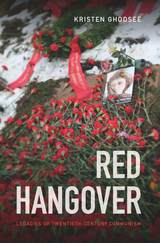 Red Hangover: Legacies of Twentieth-Century Communism
Kristen Ghodsee
Duke University Press, 2017 In Red Hangover Kristen Ghodsee examines the legacies of twentieth-century communism twenty-five years after the Berlin Wall fell. Ghodsee's essays and short stories reflect on the lived experience of postsocialism and how many ordinary men and women across Eastern Europe suffered from the massive social and economic upheavals in their lives after 1989. Ghodsee shows how recent major crises—from the Russian annexation of Crimea and the Syrian Civil War to the rise of Islamic State and the influx of migrants in Europe—are linked to mistakes made after the collapse of the Eastern Bloc when fantasies about the triumph of free markets and liberal democracy blinded Western leaders to the human costs of "regime change." Just as the communist ideal has become permanently tainted by its association with the worst excesses of twentieth-century Eastern European regimes, today the democratic ideal is increasingly sullied by its links to the ravages of neoliberalism. An accessible introduction to the history of European state socialism and postcommunism, Red Hangover reveals how the events of 1989 continue to shape the world today.
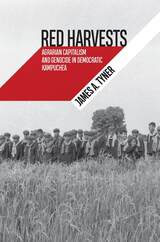 Red Harvests: Agrarian Capitalism and Genocide in Democratic Kampuchea
James A. Tyner
West Virginia University Press, 2021 Reassessing the Cambodian genocide through the lens of global capitalist development.
James Tyner reinterprets the place of agriculture under the Khmer Rouge, positioning it in new ways relative to Marxism, capitalism, and genocide. The Cambodian revolutionaries’ agricultural management is widely viewed by critics as irrational and dangerous, and it is invoked as part of wider efforts to discredit leftist movements. Researching the specific functioning of Cambodia’s transition from farms to agriculture within the context of the global economy, Tyner comes to a different conclusion. He finds that analysis of “actually existing political economy”—as opposed to the Marxist identification the Khmer Rouge claimed—points to overlap between Cambodian practice and agrarian capitalism. Tyner argues that dissolution of the traditional Khmer family farm under the aegis of state capitalism is central to any understanding of the mass violence unleashed by the Khmer Rouge. Seen less as a radical outlier than as part of a global shift in farming and food politics, the Cambodian tragedy imparts new lessons to our understanding of the political economy of genocide.
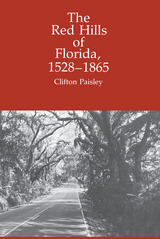 The Red Hills of Florida, 1528-1865
Clifton Paisley
University of Alabama Press, 1989 Recent excavation of the Tallahassee area provided anthropological and archaeological evidence showing that the Red Hills of Florida were sought out by agricultural Indians long before European contact
The Red Hills section of northern Florida is composed of Leon County, where Tallahassee is located , and its neighboring counties of Gadsden and Jackson to the west and Jefferson and Madison to the east. The land is distinctive band of rolling red clay hills that extends for 150 miles along the border of Alabama and Georgia. This well-written narrative chronicles the history of the region from the time of first European contact in 1528 through the end of the Civil War, and provides a comprehensive study of this vital section of northern Florida. Recent excavation of the Tallahassee area provided anthropological and archaeological evidence showing that the Red Hills of Florida were sought out by agricultural Indians long before European contact. DeSoto fed his army of more that 700 during the winter of 1539-40 from corn gathered within a few miles of the principal town of the Apalachee. The Spaniards who settled in the Apalachee area during the mission era depended on the corn for survival and used the Indians of the 14 Apalachee mission in a war of empire building with the English of South Carolina. Raids by these enemies wiped out the Indians of the Apalachee area and its mission in 1704. In 1818 Andrew Jackson defeated the successors of the Apalachee in the Red Hills, the Seminoles, and after Florida became American territory in 1821, Governor Du Val planned the town of Tallahassee near the original DeSoto winter campsite. Farsighted Du Val used a site plan that provide for future expansion. Farmers were shipping cotton from the region as early as 1820, but the full development of the plantation economy had to await the removal of the Seminoles. From the 1840s through the Civil War cotton was the major crop which supported the social, political, and economic growth of this pivotal area of north Florida know as the Red Hills.
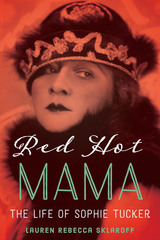 Red Hot Mama: The Life of Sophie Tucker
Lauren Rebecca Sklaroff
University of Texas Press, 2018 The “First Lady of Show Business” and the “Last of the Red Hot Mamas,” Sophie Tucker was a star in vaudeville, radio, film, and television. A gutsy, song-belting stage performer, she entertained audiences for sixty years and inspired a host of younger women, including Judy Garland, Carol Channing, and Bette Midler. Tucker was a woman who defied traditional expectations and achieved success on her own terms, becoming the first female president of the American Federation of Actors and winning many other honors usually bestowed on men. Dedicated to social justice, she advocated for African Americans in the entertainment industry and cultivated friendships with leading black activists and performers. Tucker was also one of the most generous philanthropists in show business, raising over four million dollars for the religious and racial causes she held dear. Drawing from the hundreds of scrapbooks Tucker compiled, Red Hot Mama presents a compelling biography of this larger-than-life performer. Lauren Rebecca Sklaroff tells an engrossing story of how a daughter of Russian Jewish immigrants set her sights on becoming one of the most formidable women in show business and achieved her version of the American dream. More than most of her contemporaries, Tucker understood how to keep her act fresh, to change branding when audiences grew tired and, most importantly, how to connect with her fans, the press, and entertainment moguls. Both deservedly famous and unjustly forgotten today, Tucker stands out as an exemplar of the immigrant experience and a trailblazer for women in the entertainment industry.
|
|

